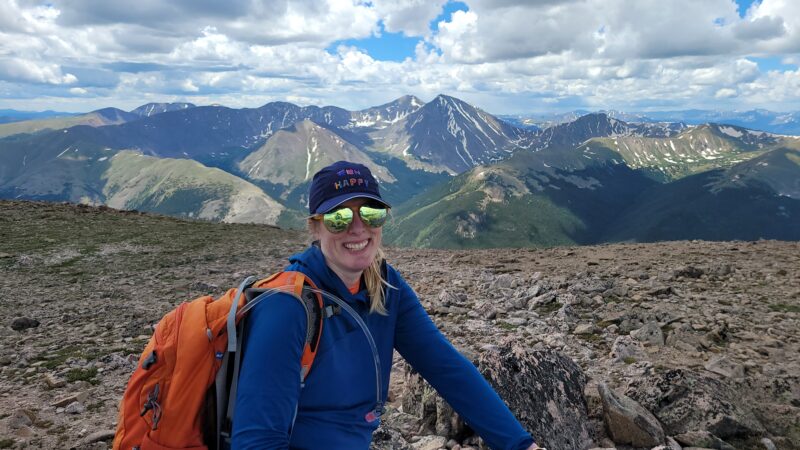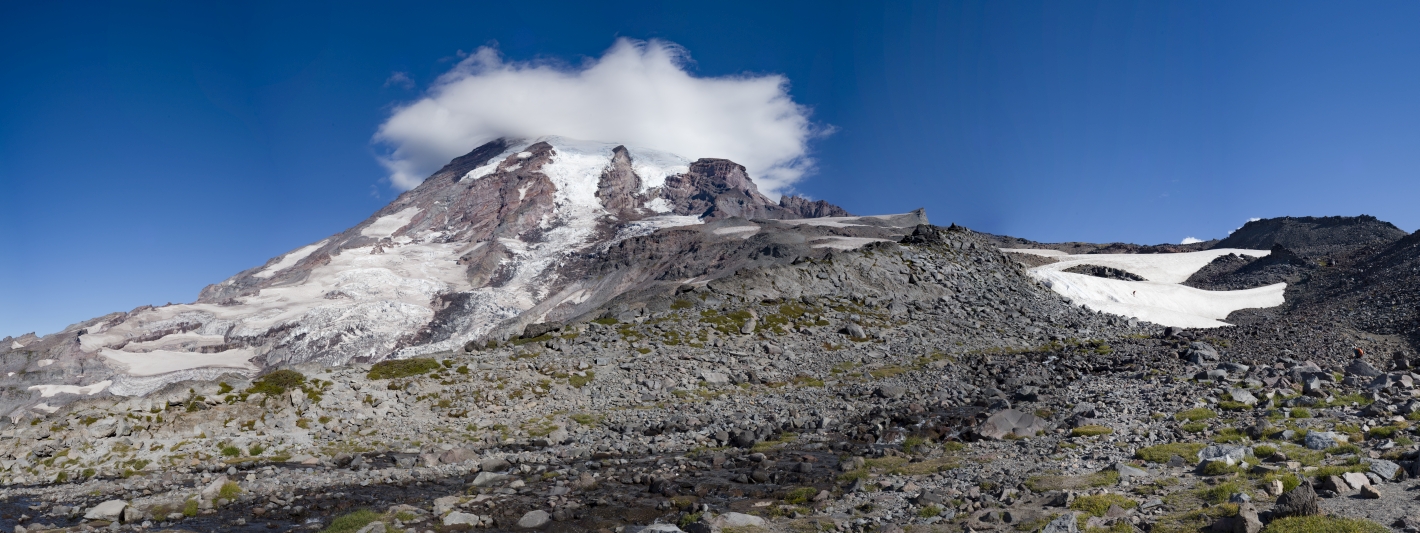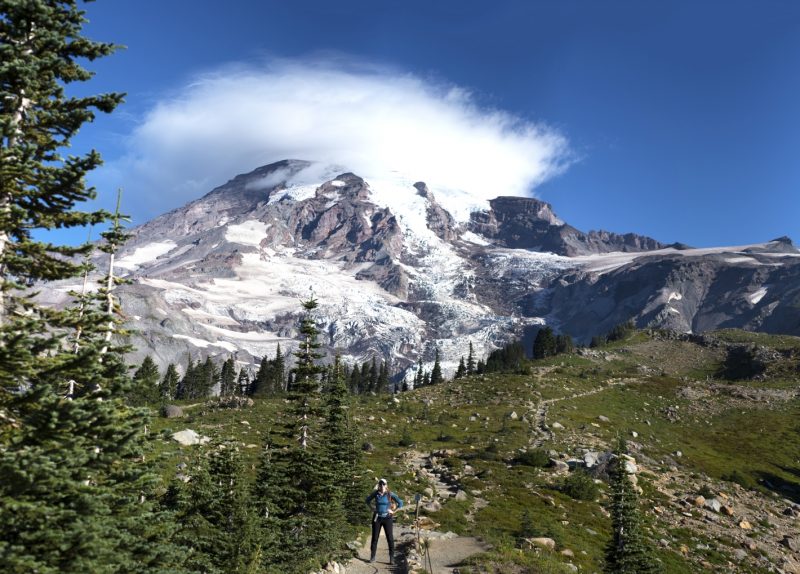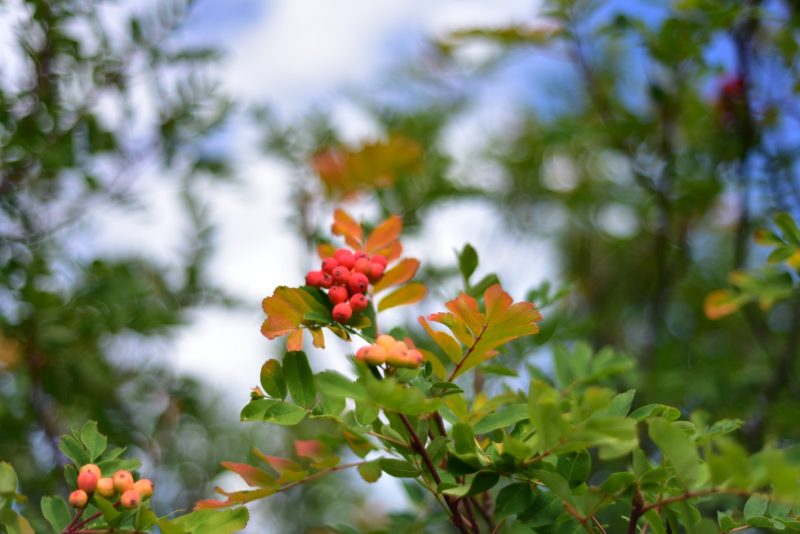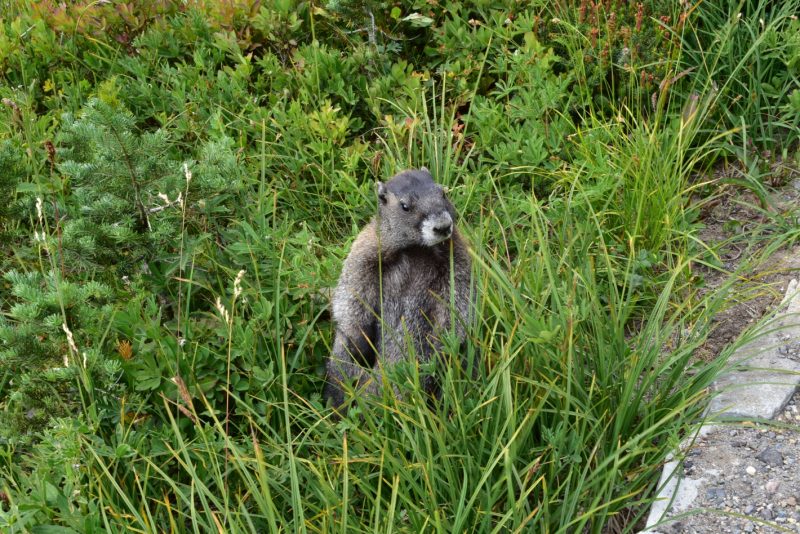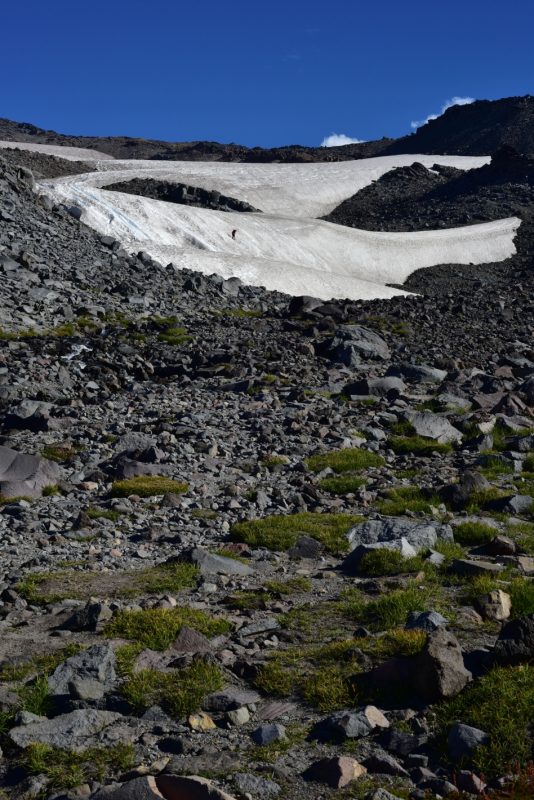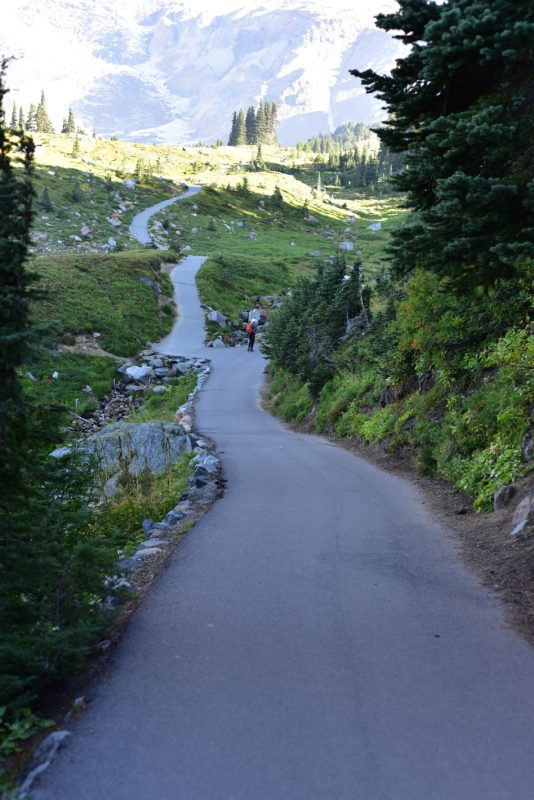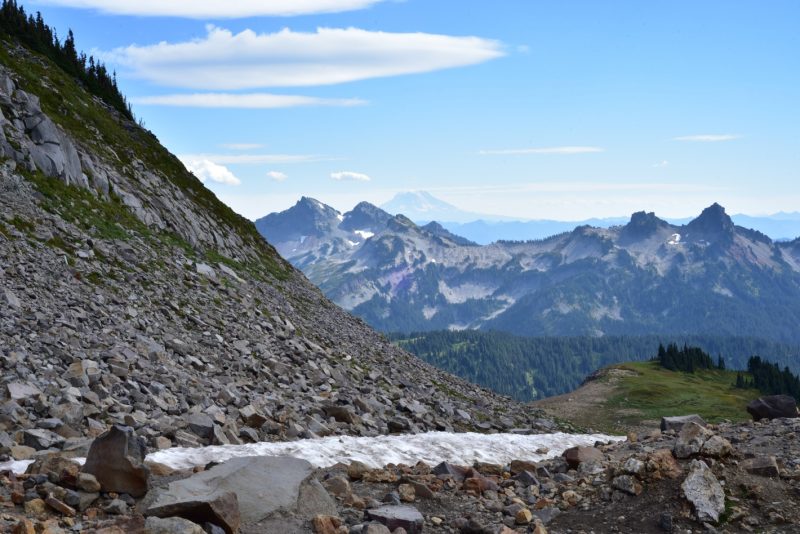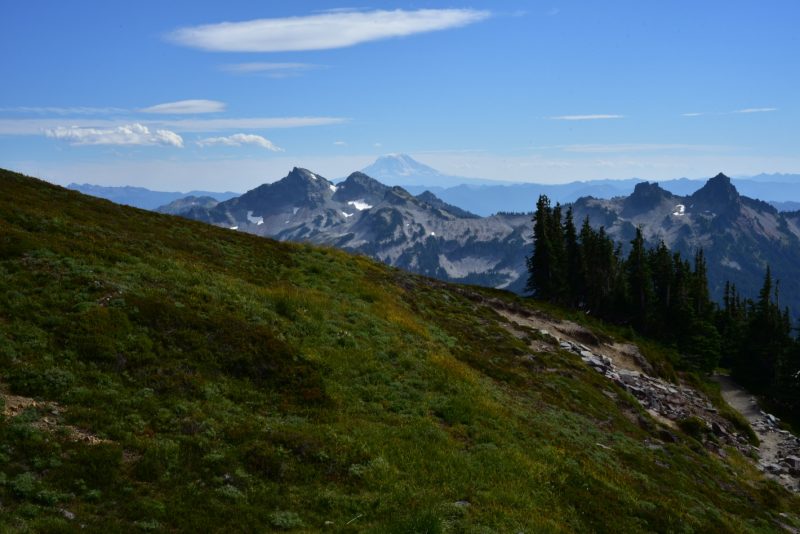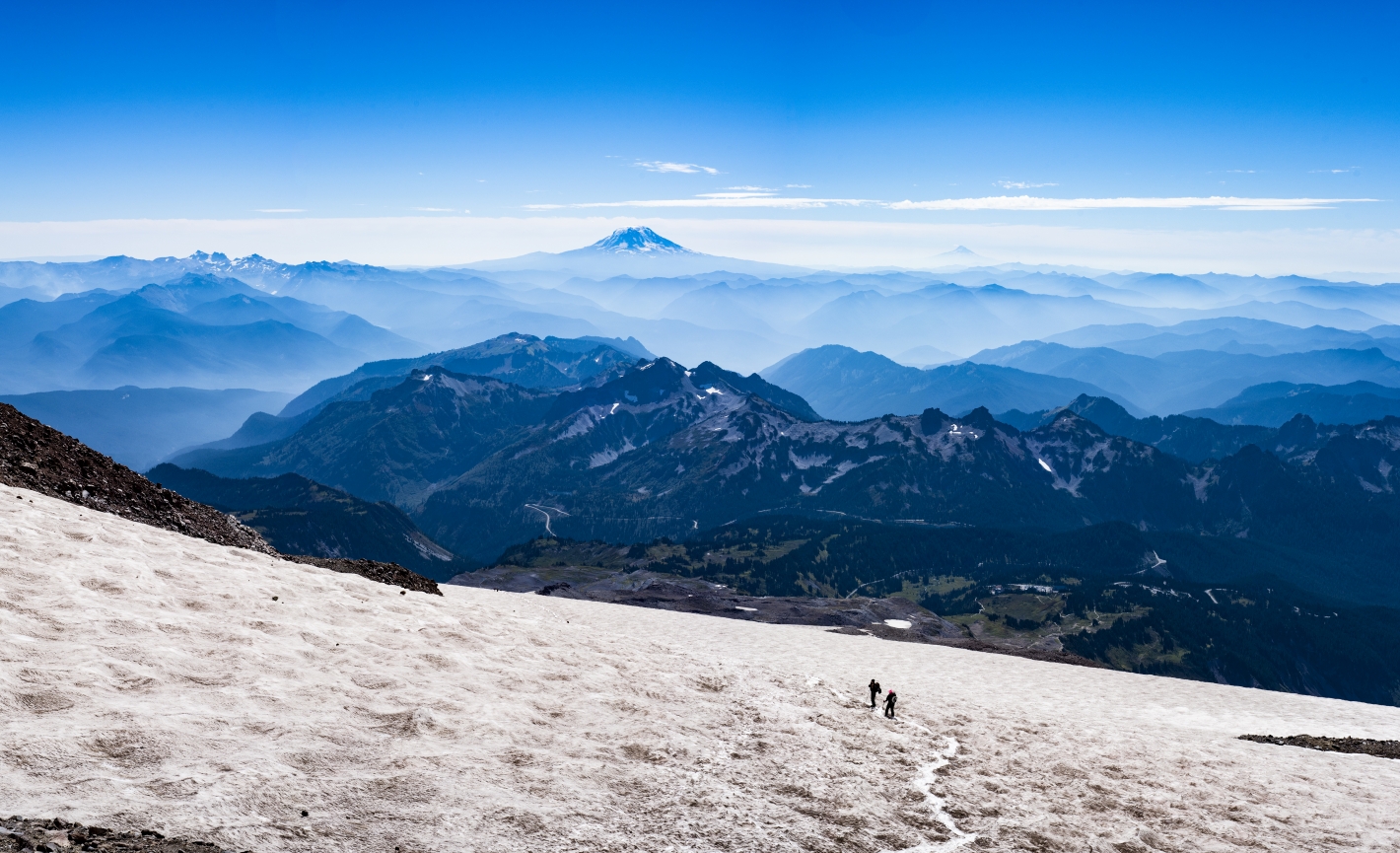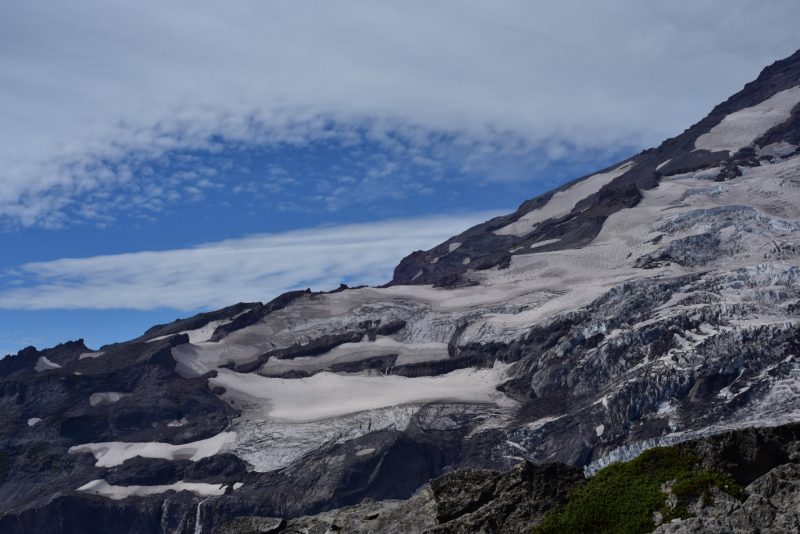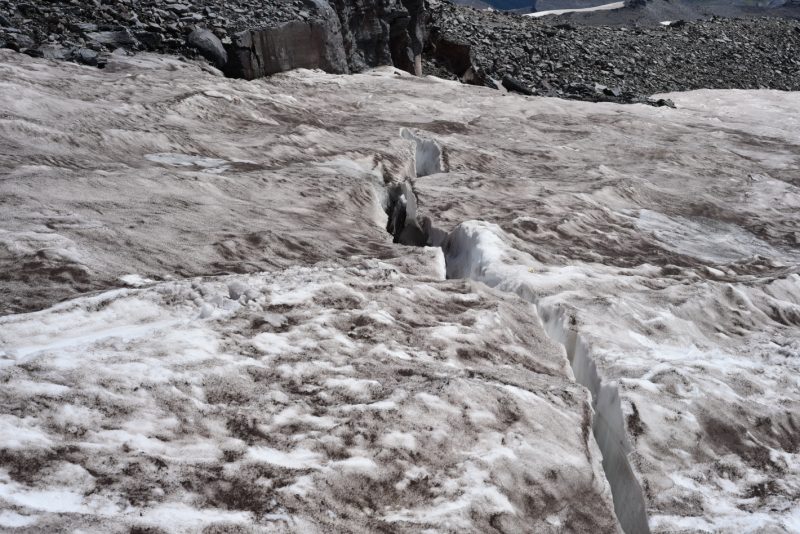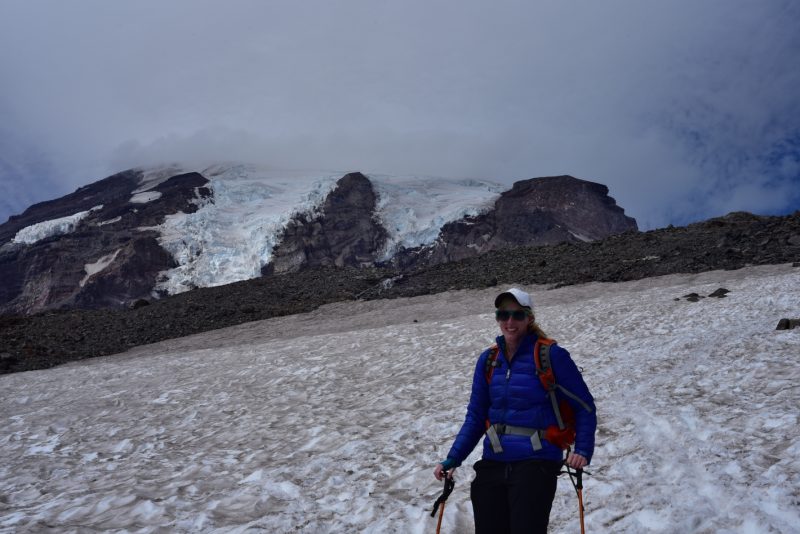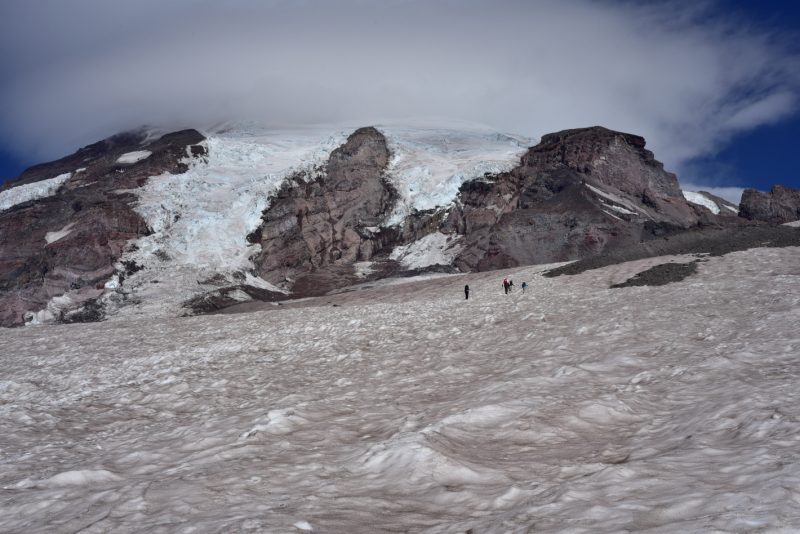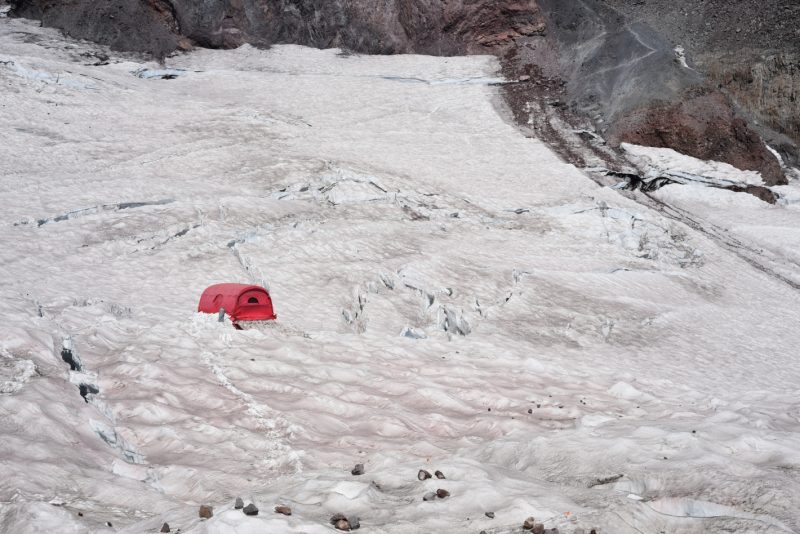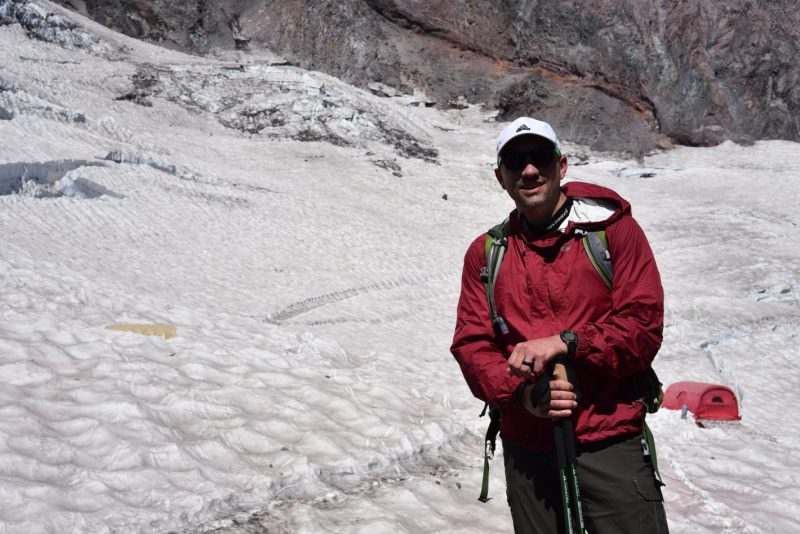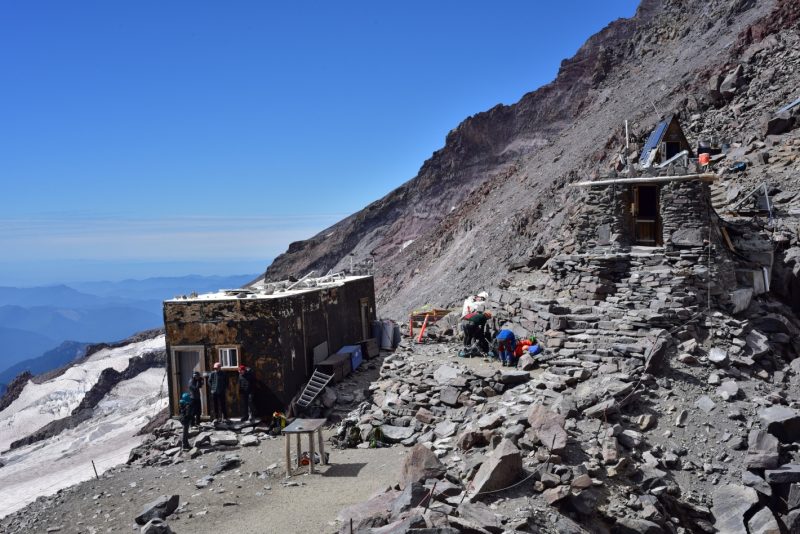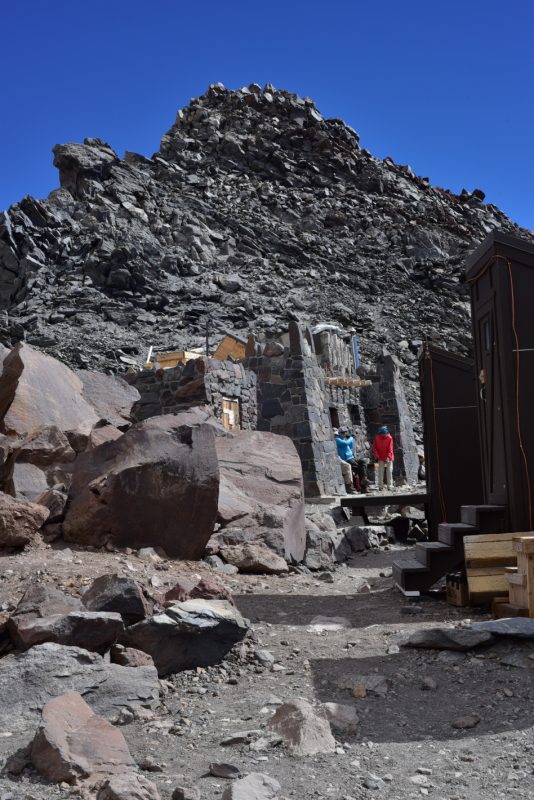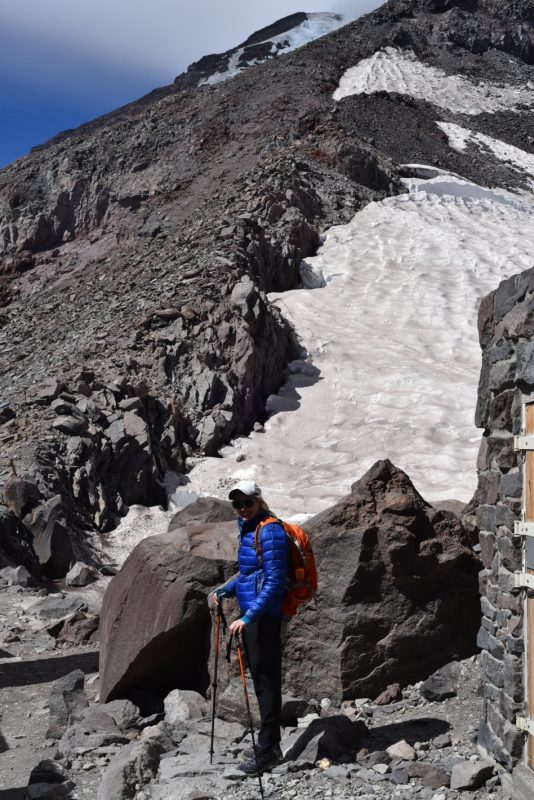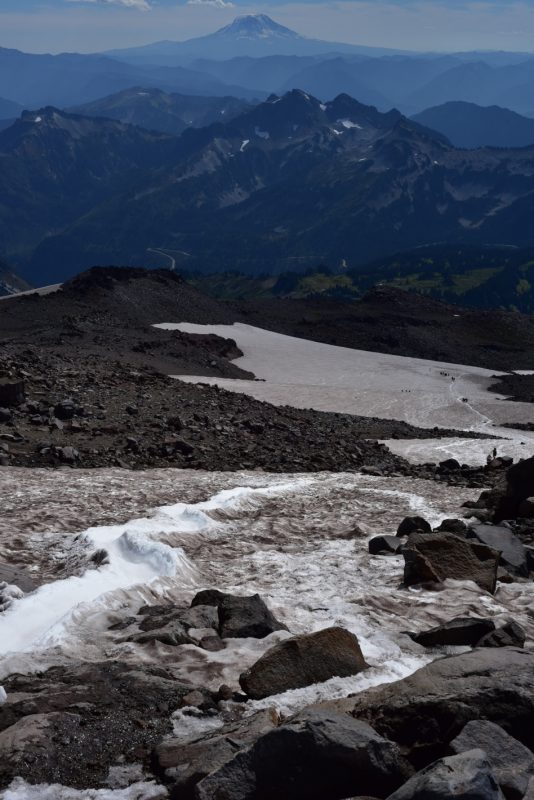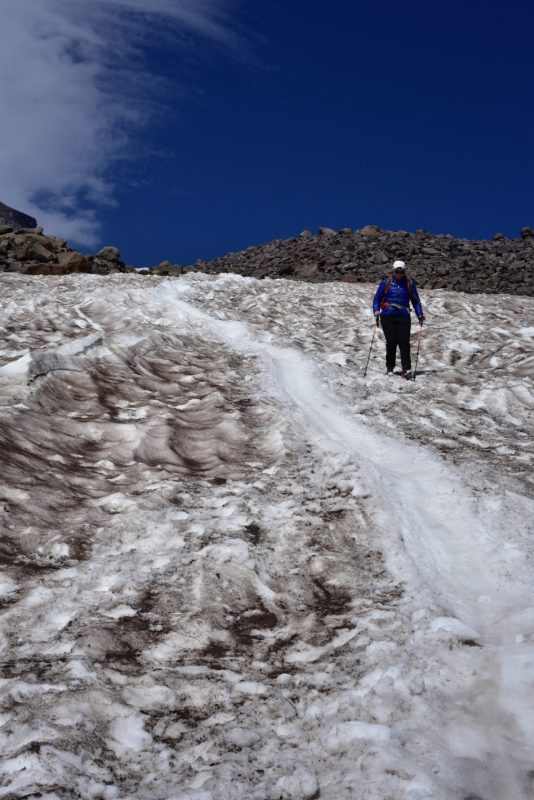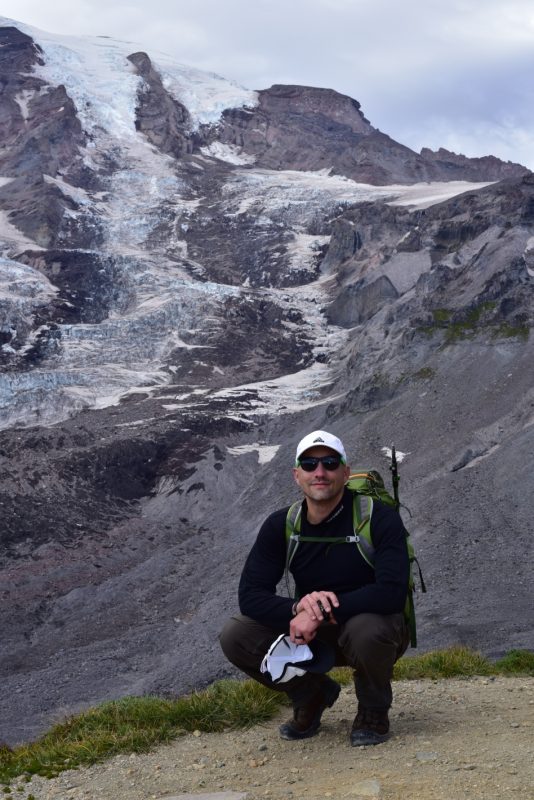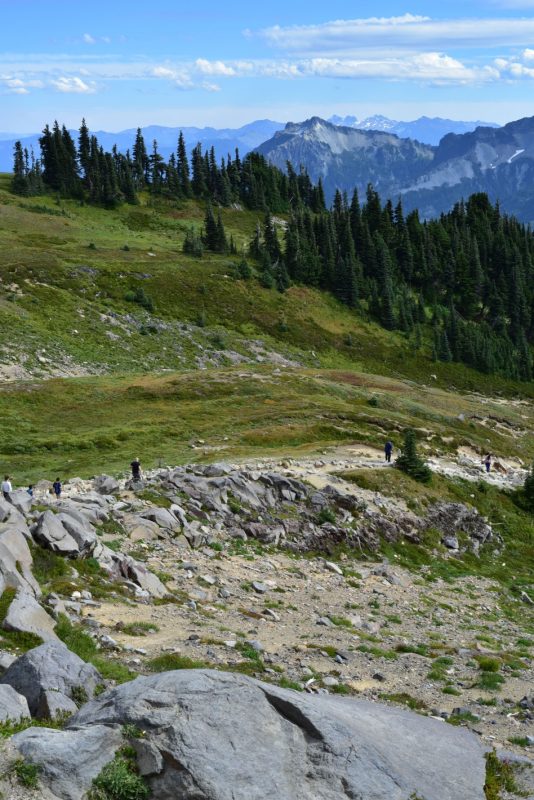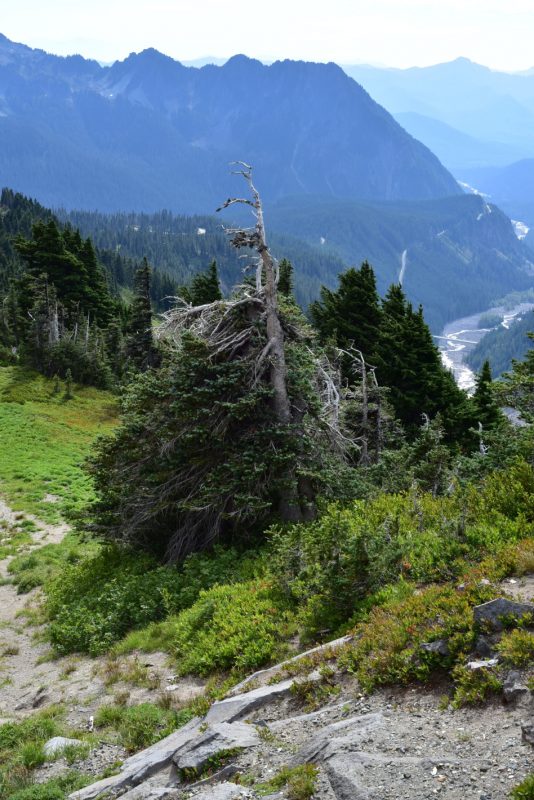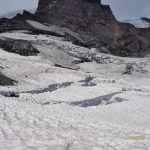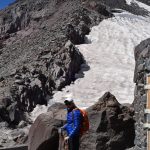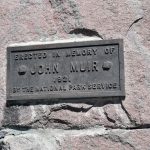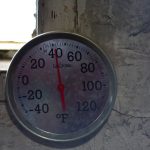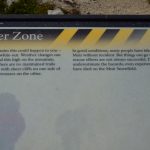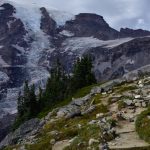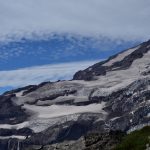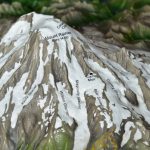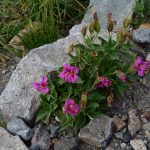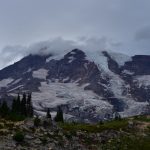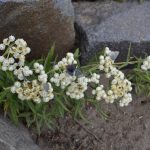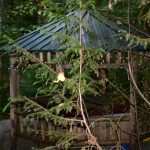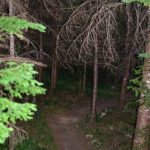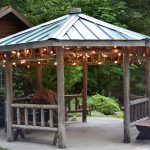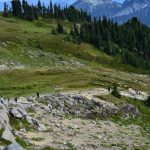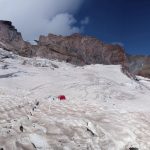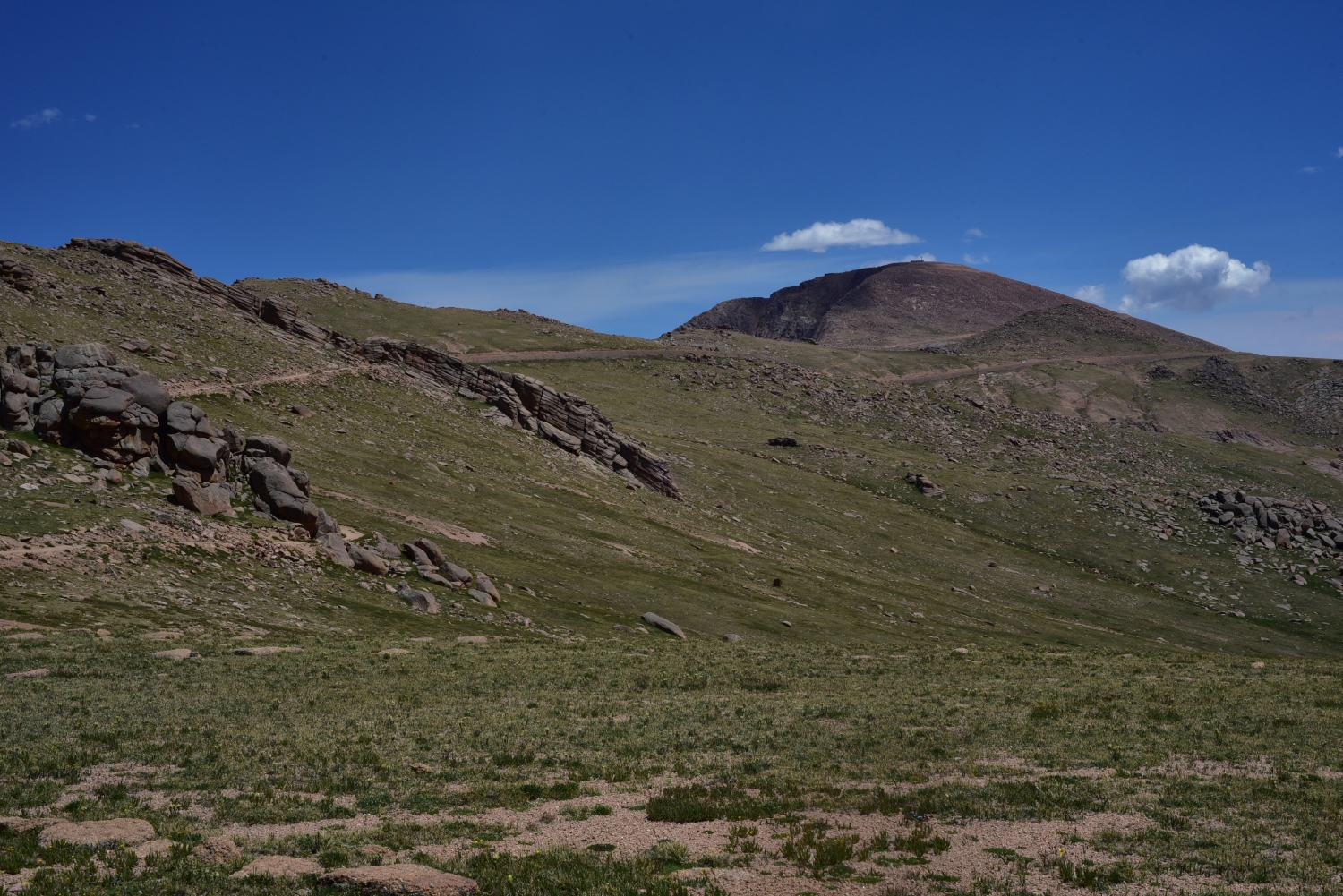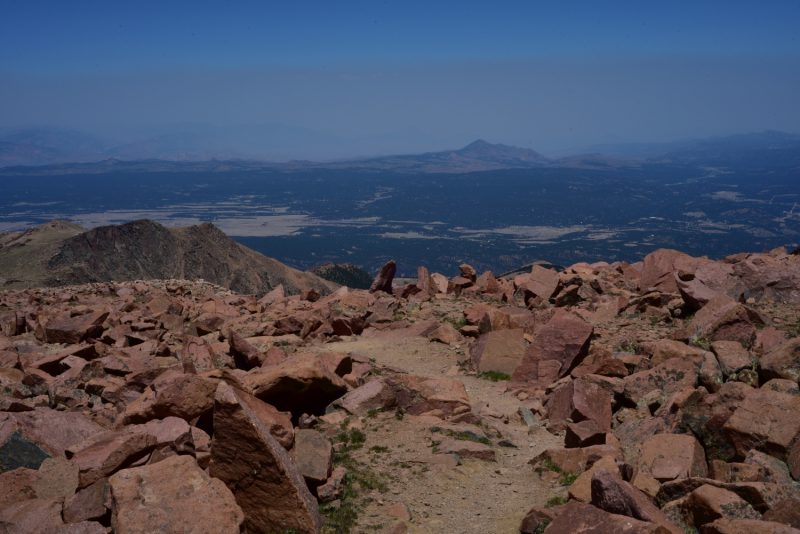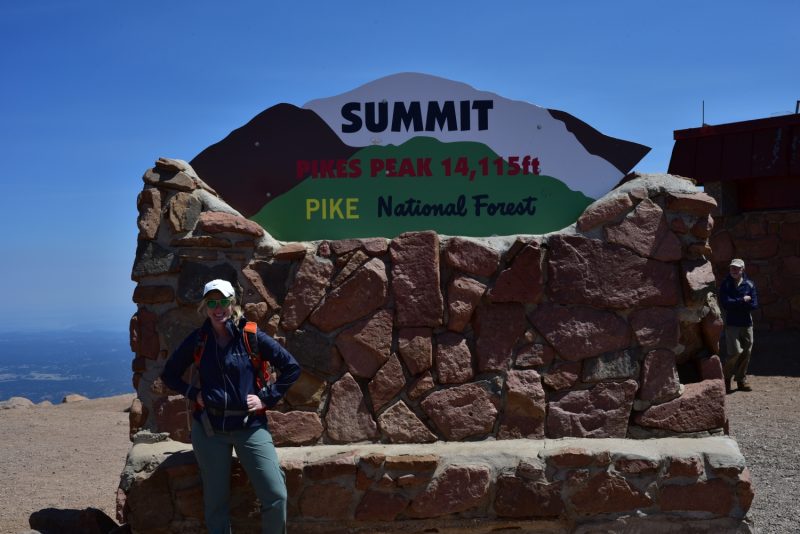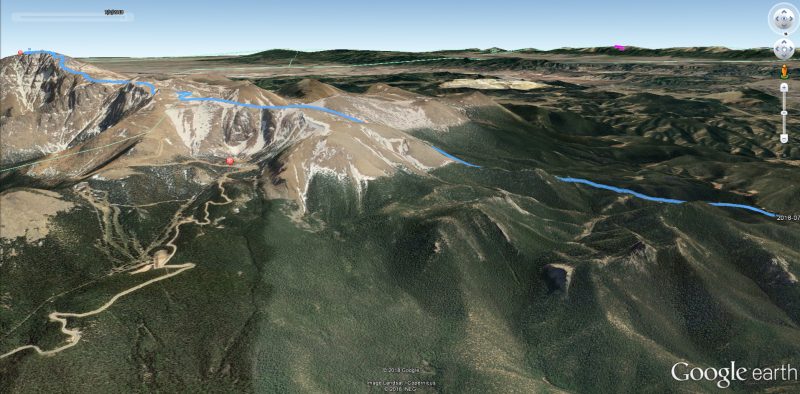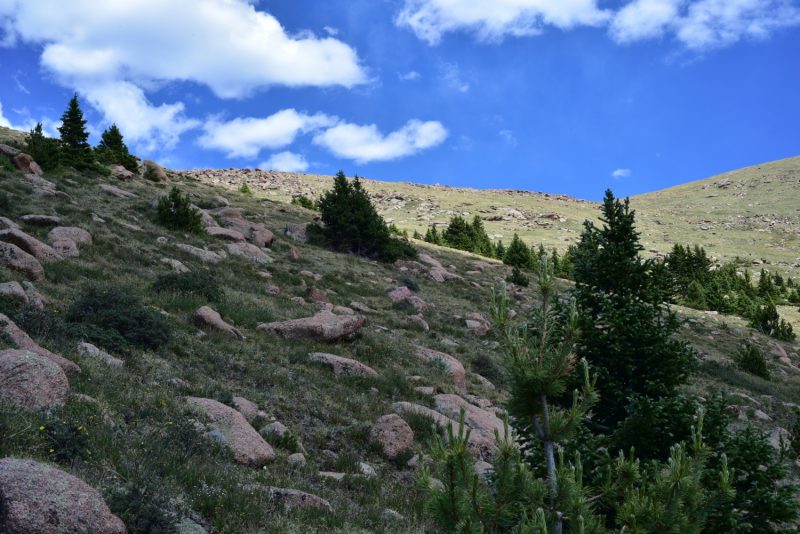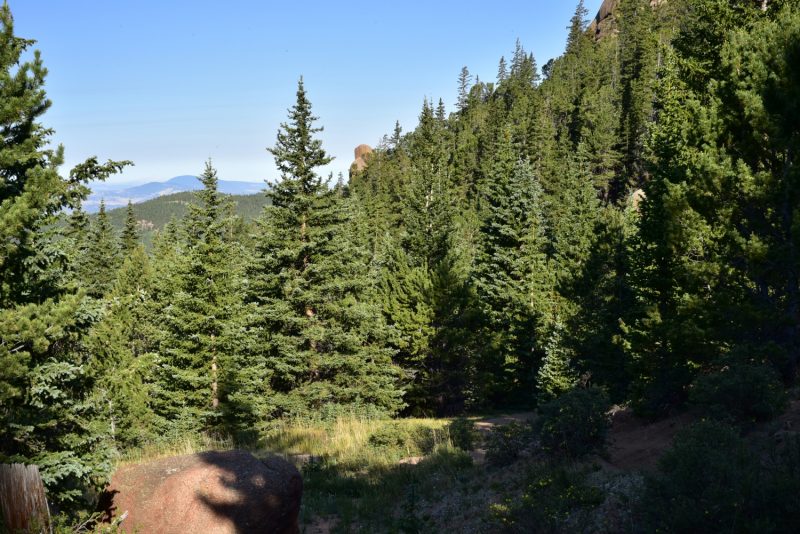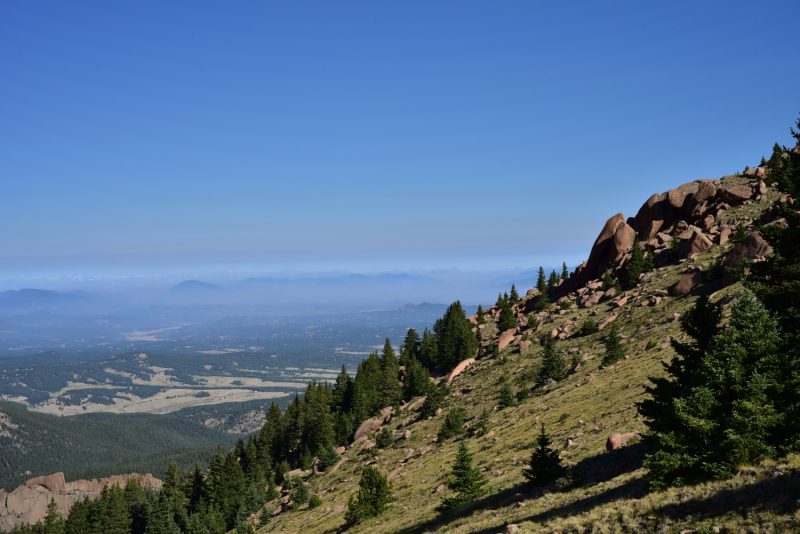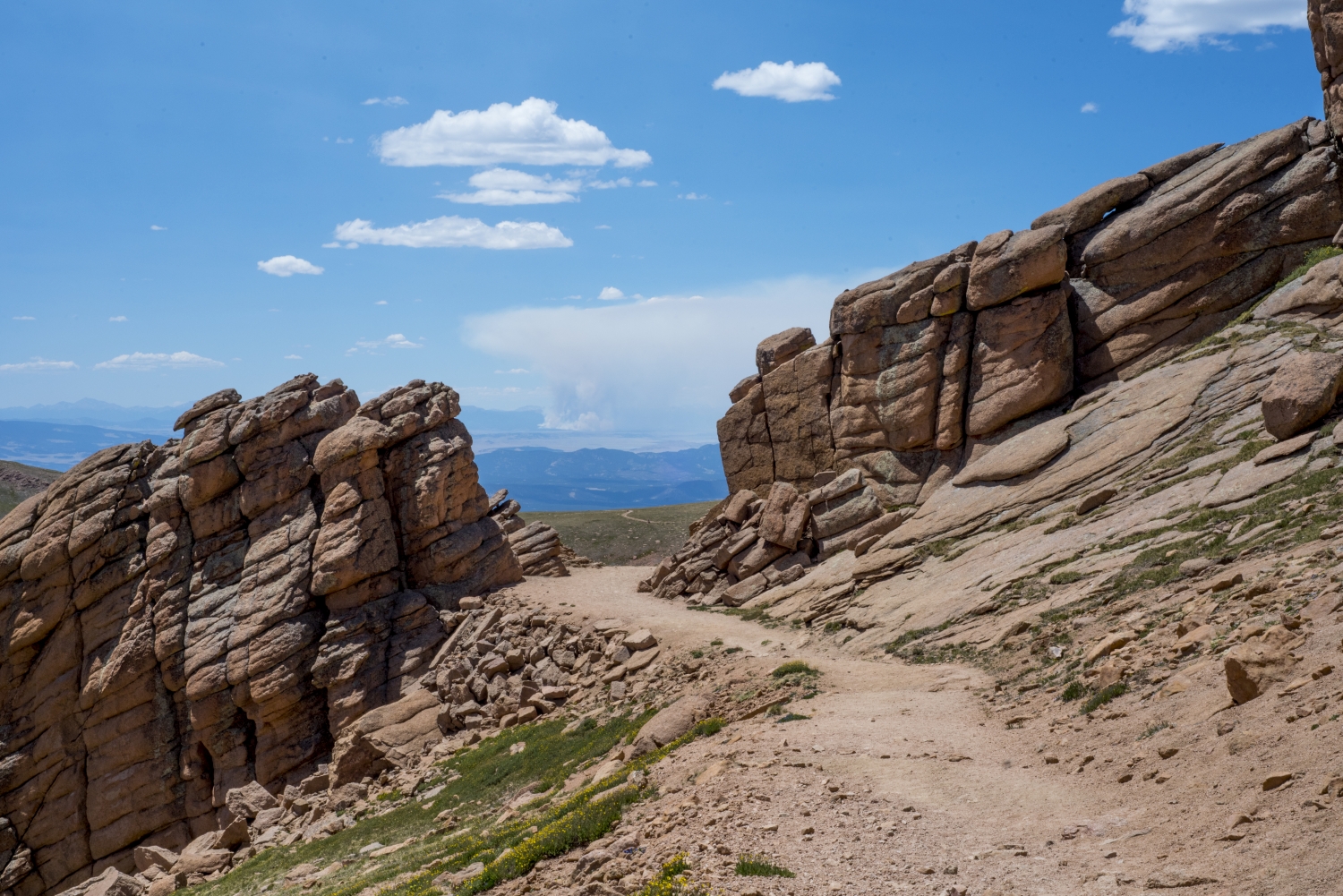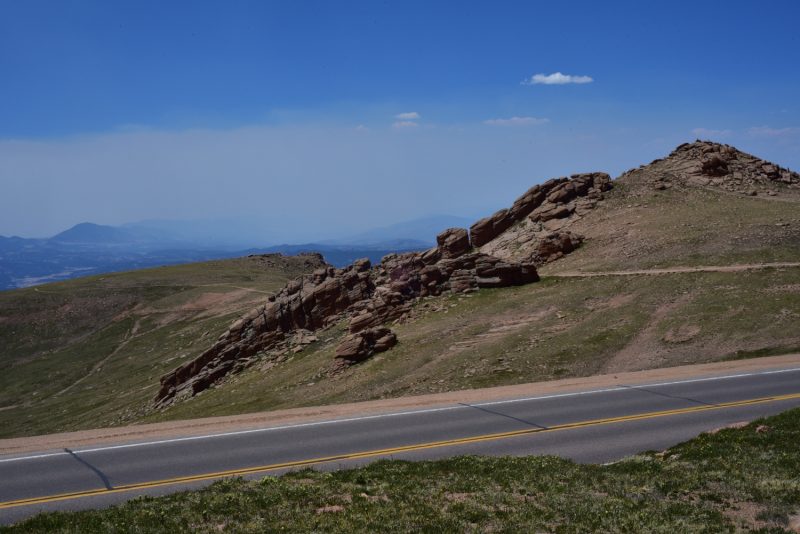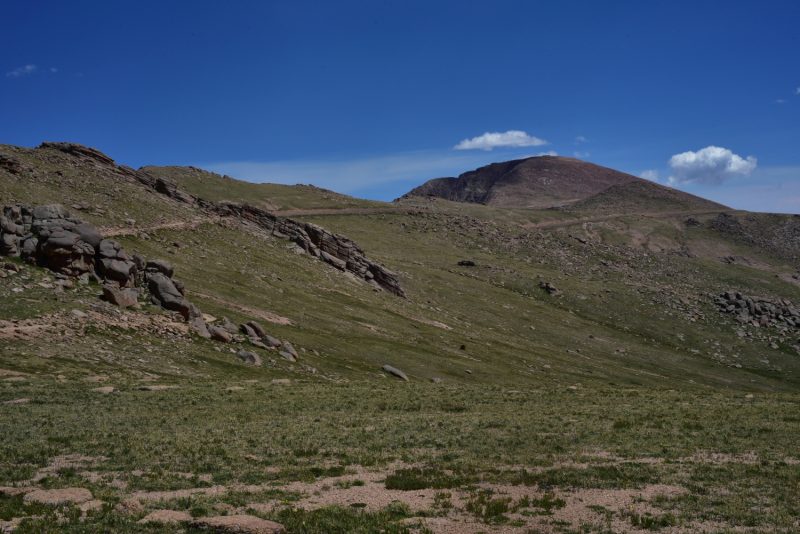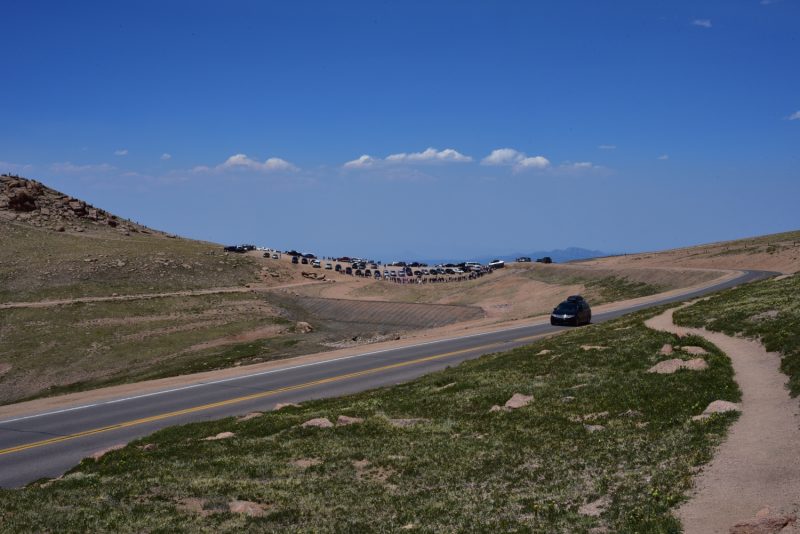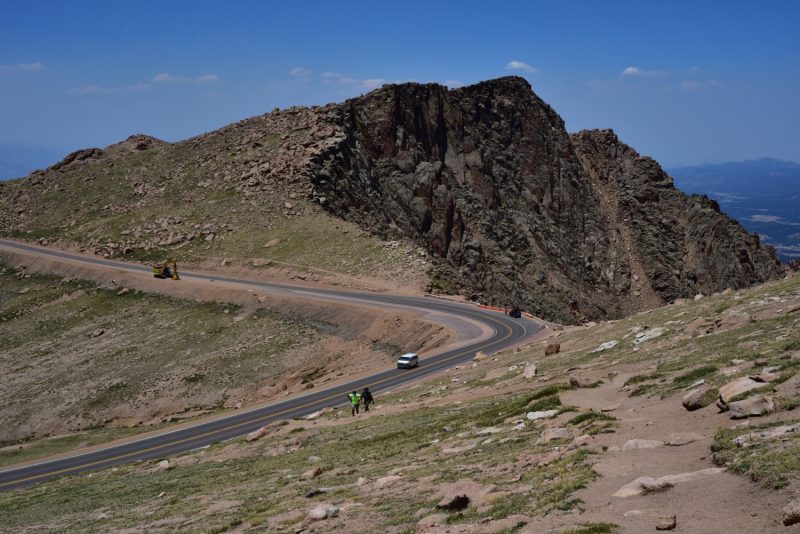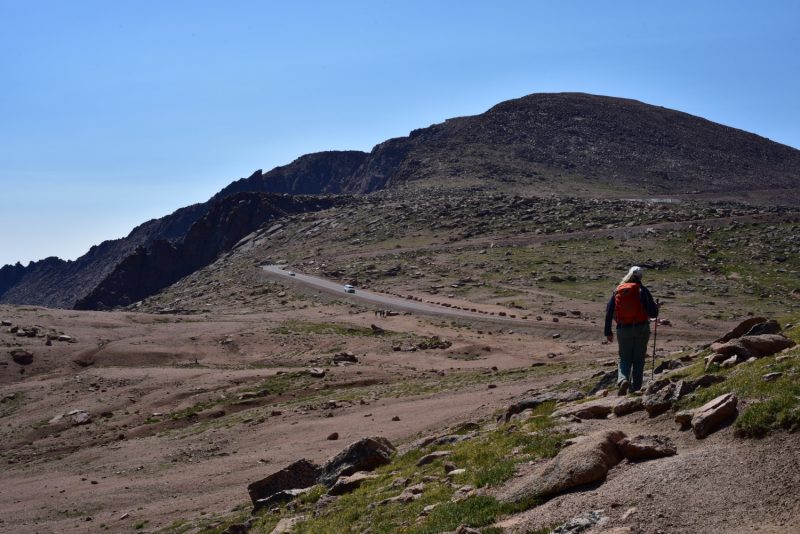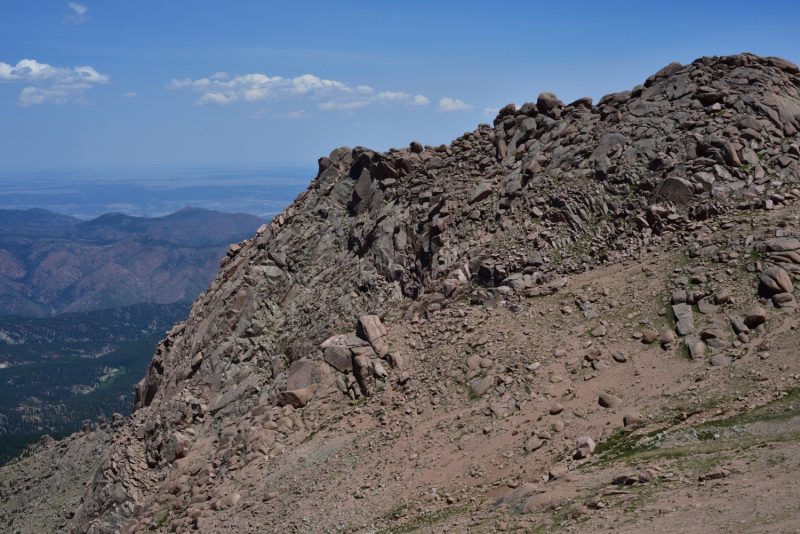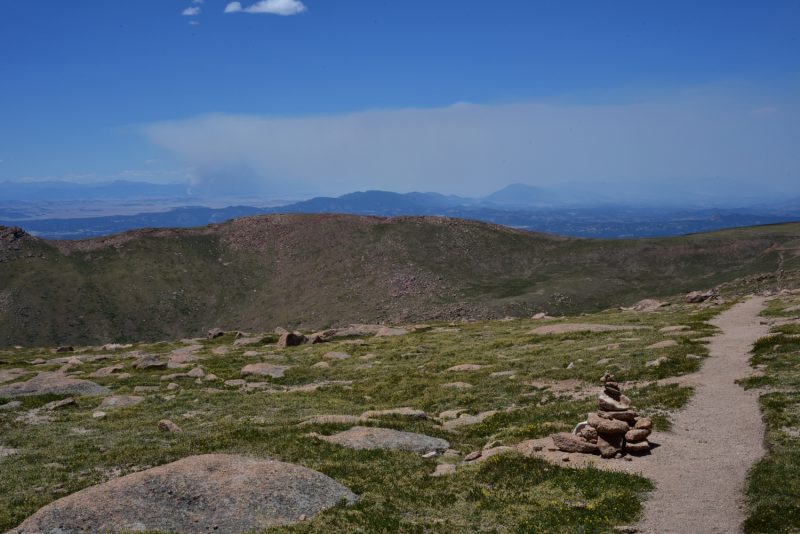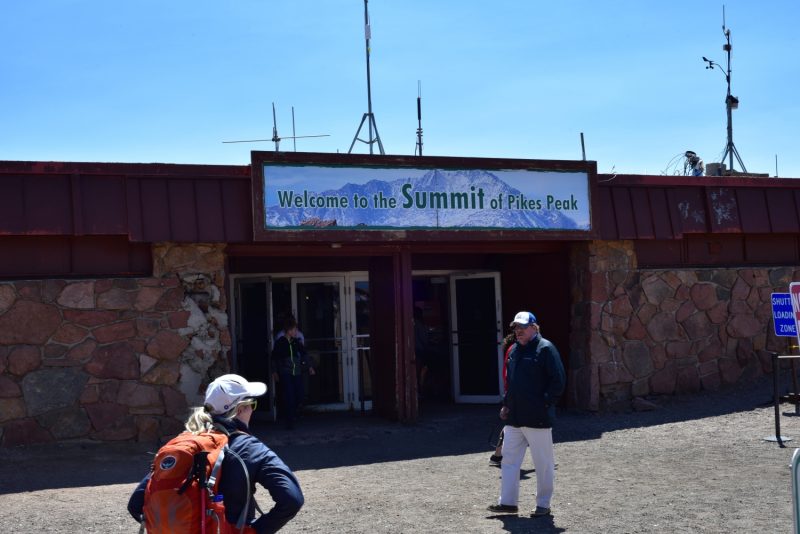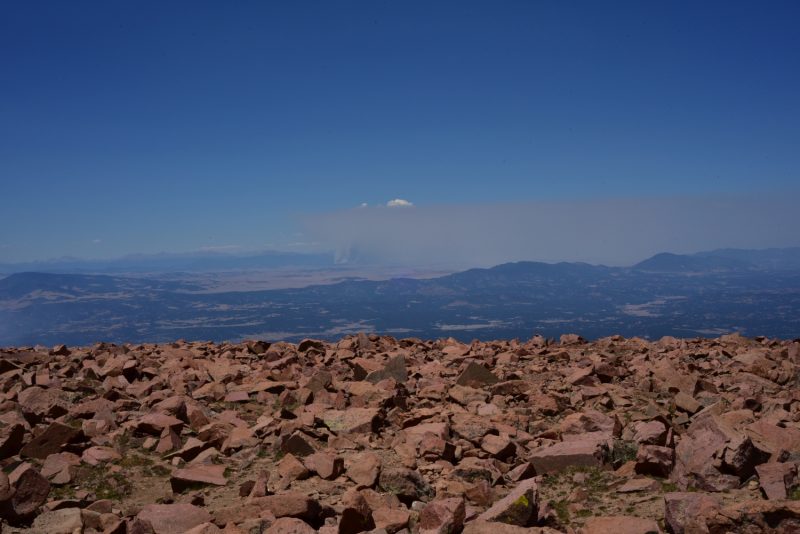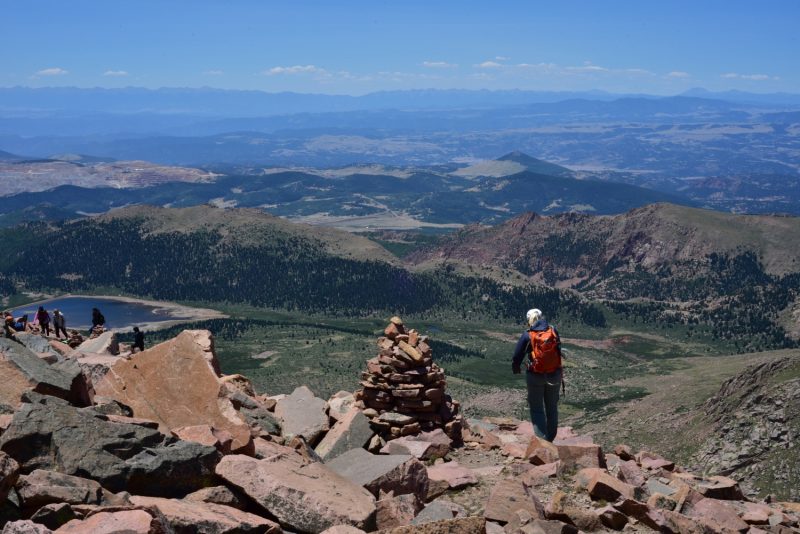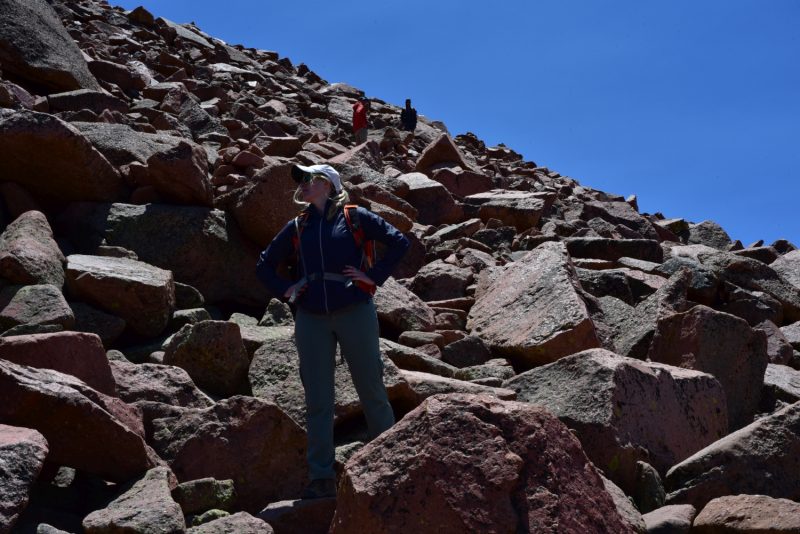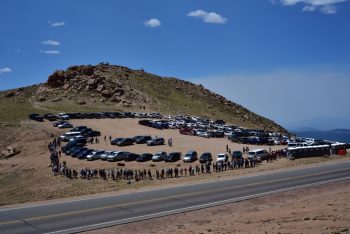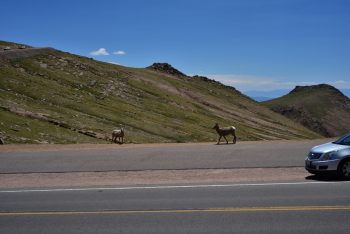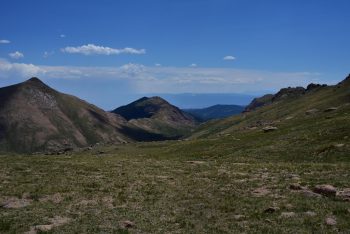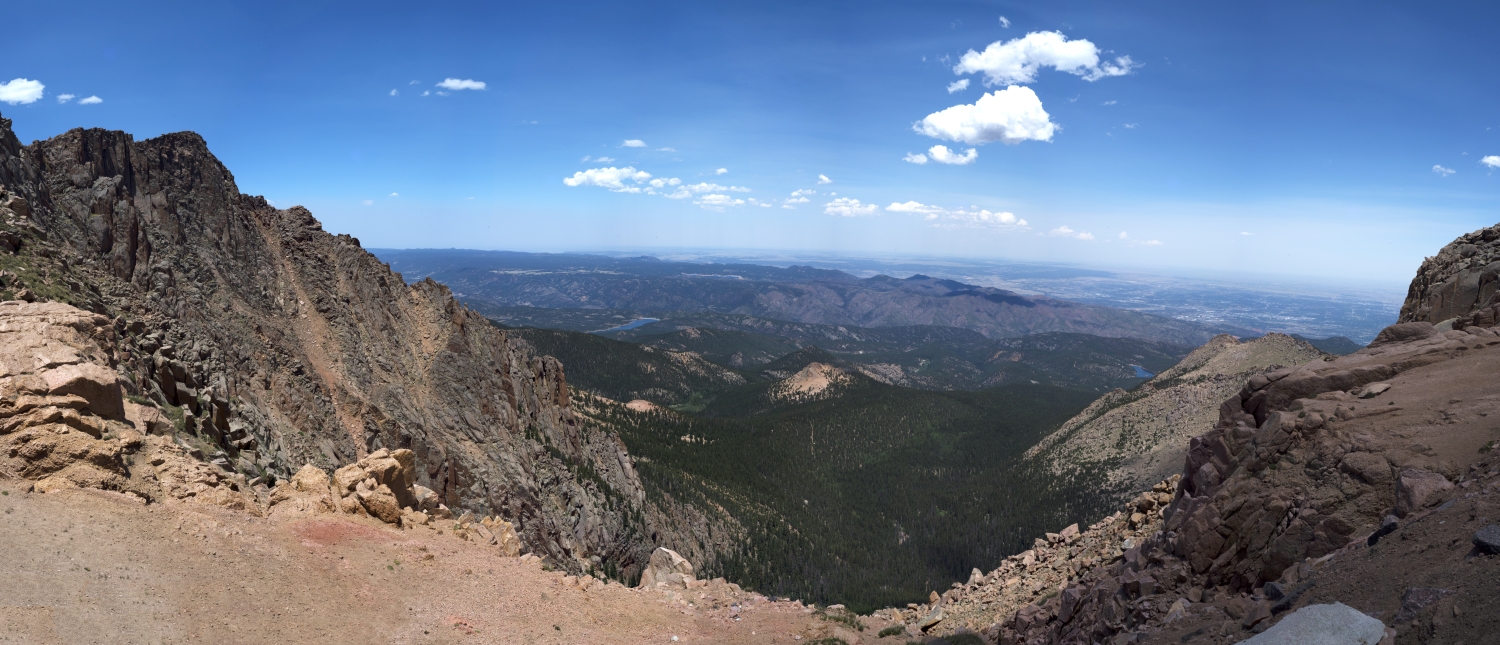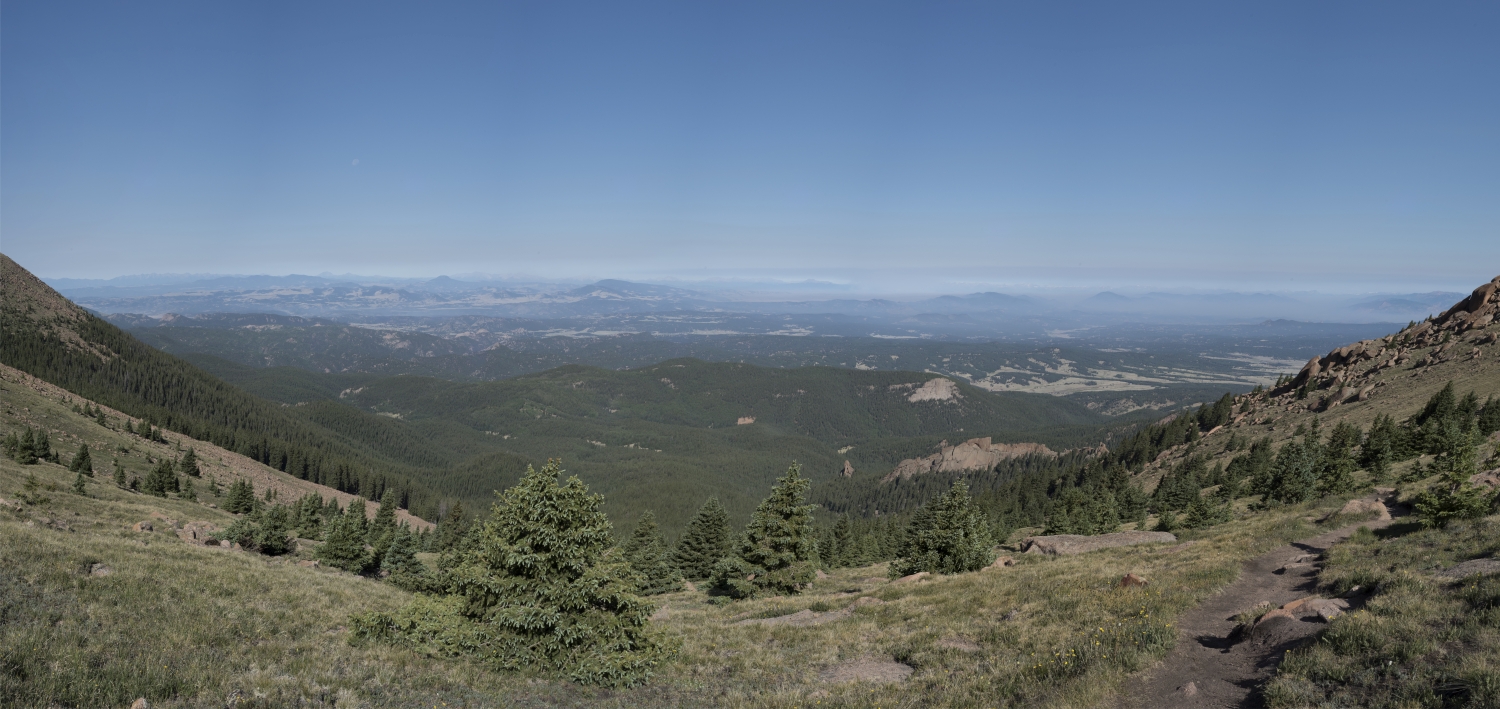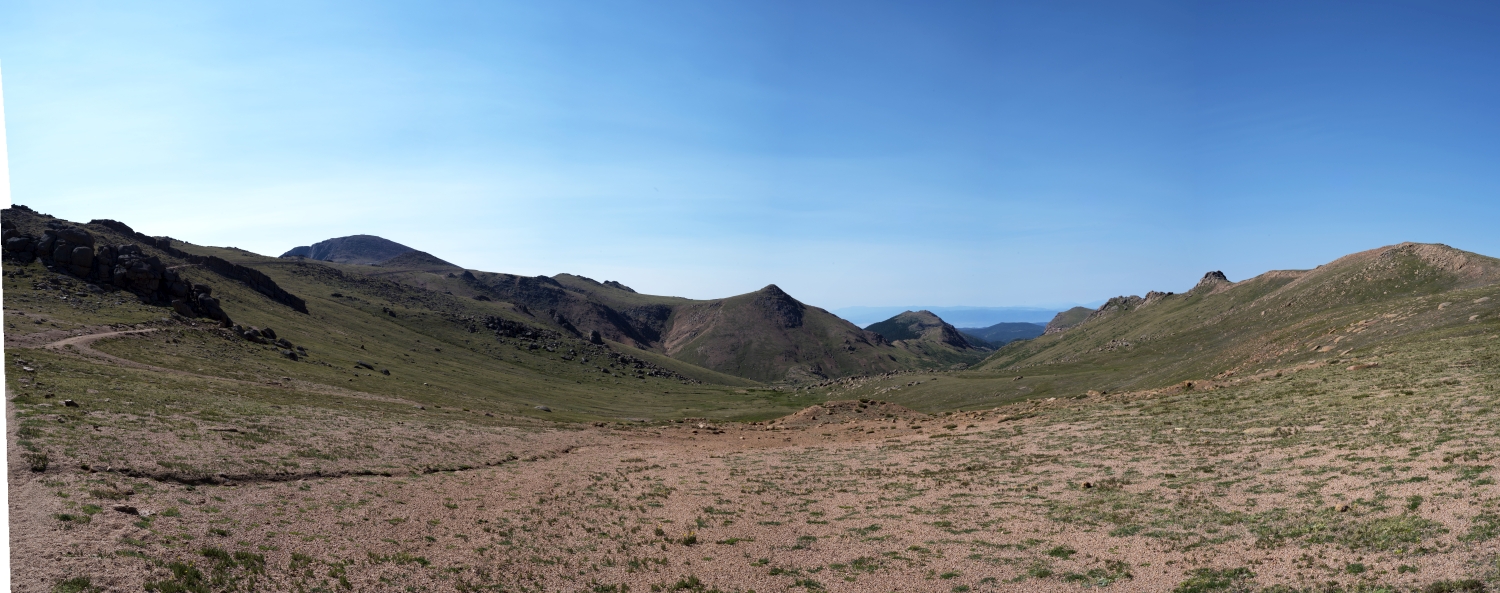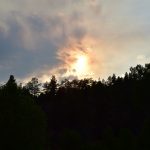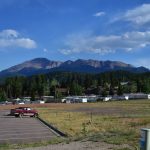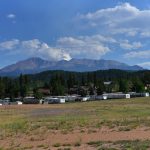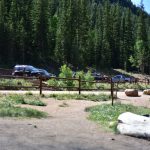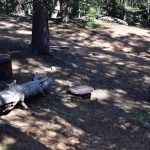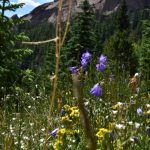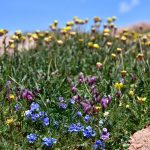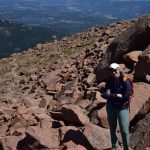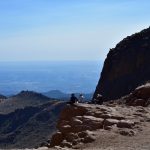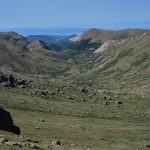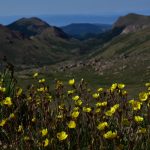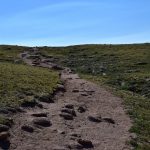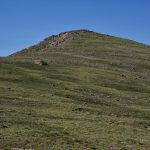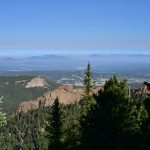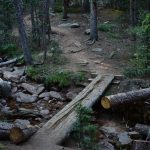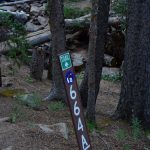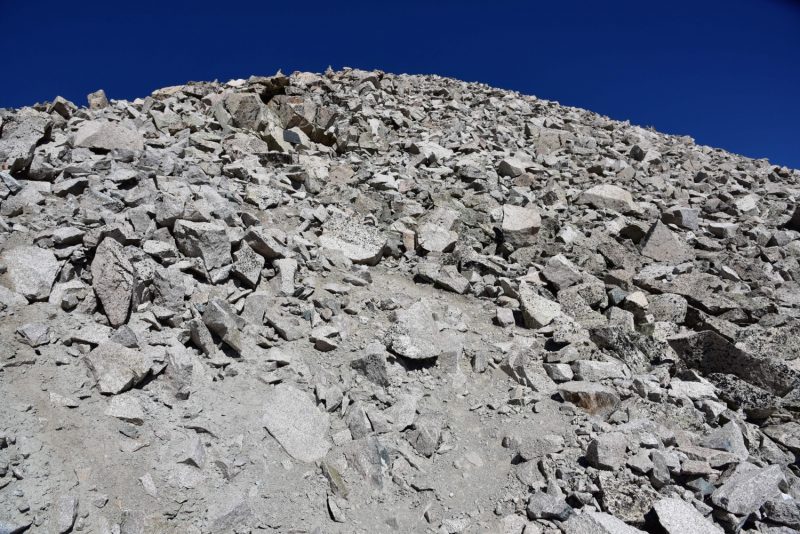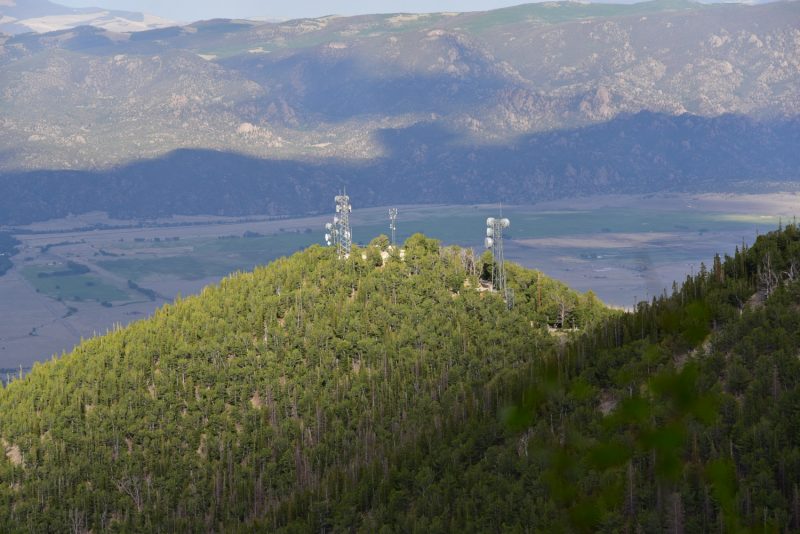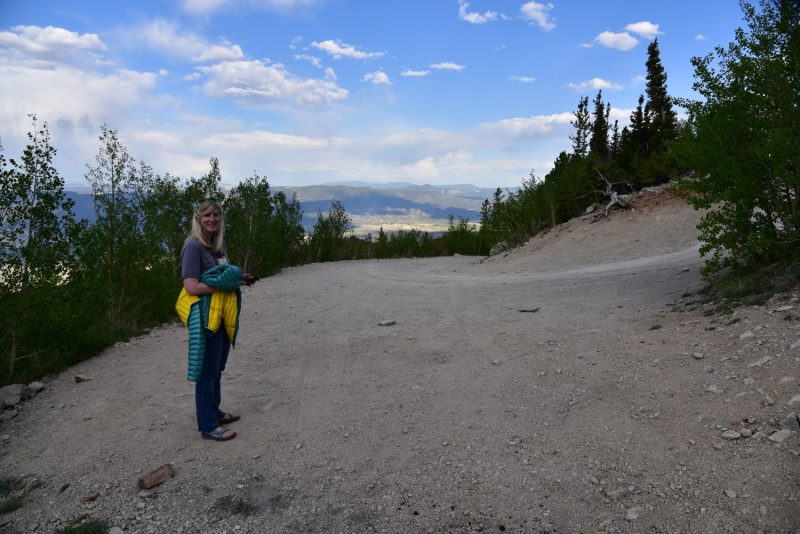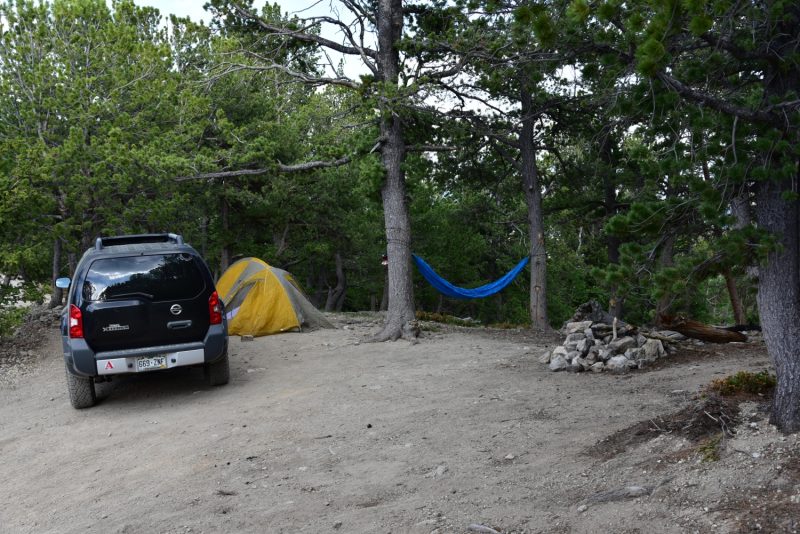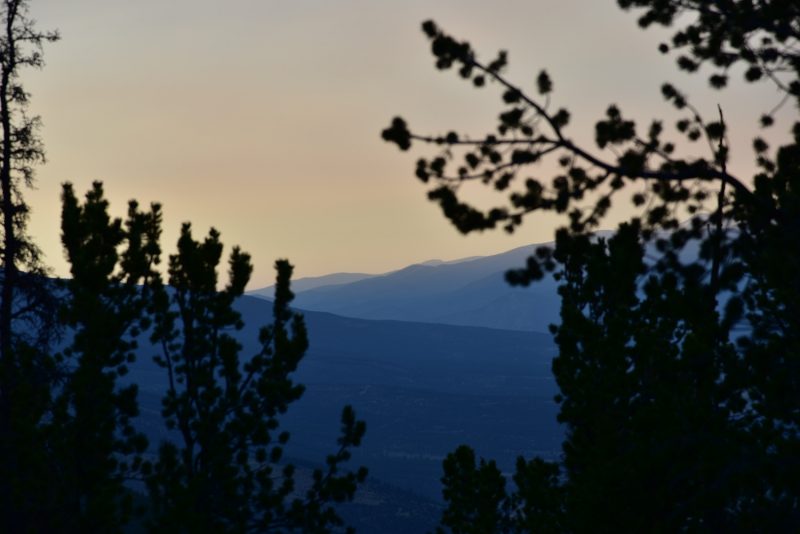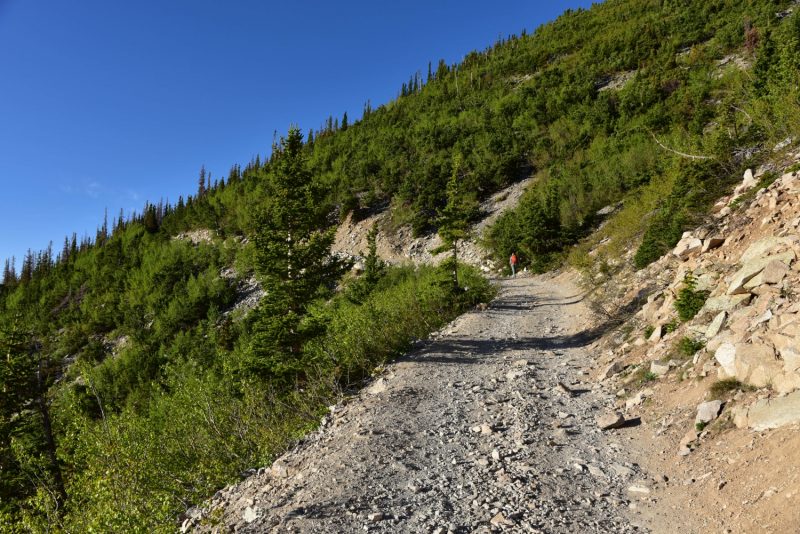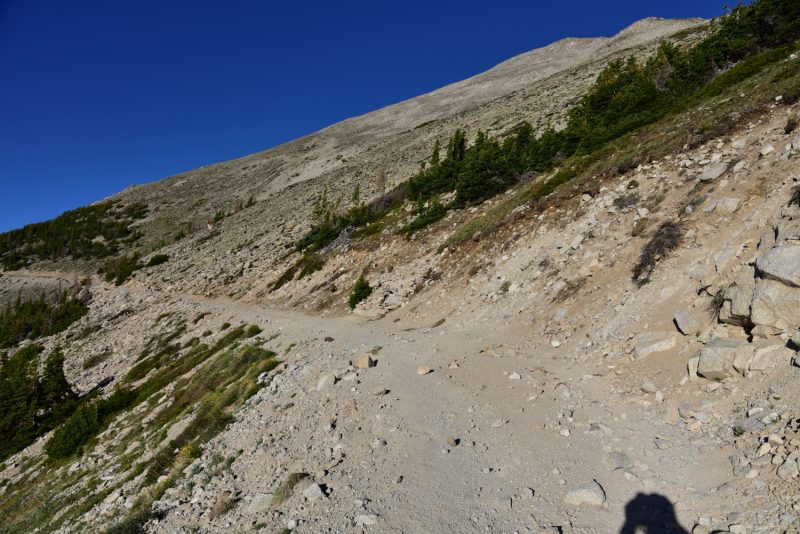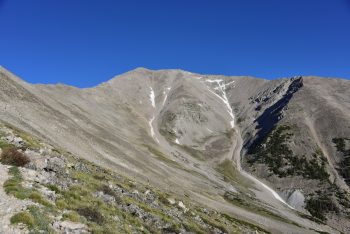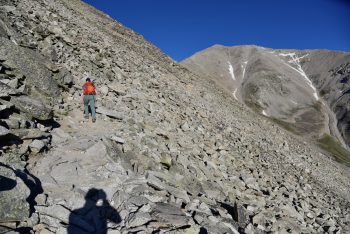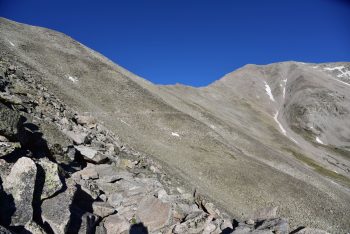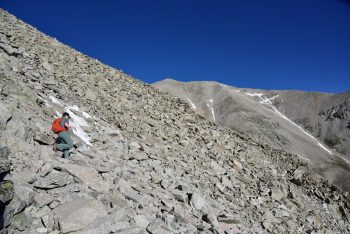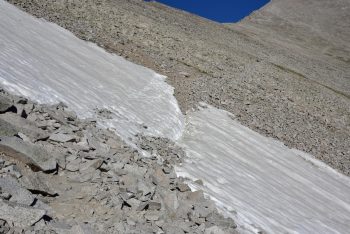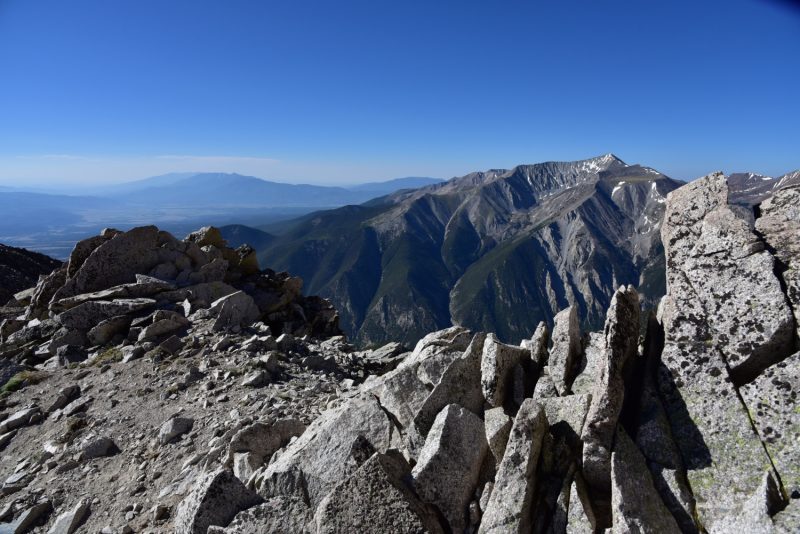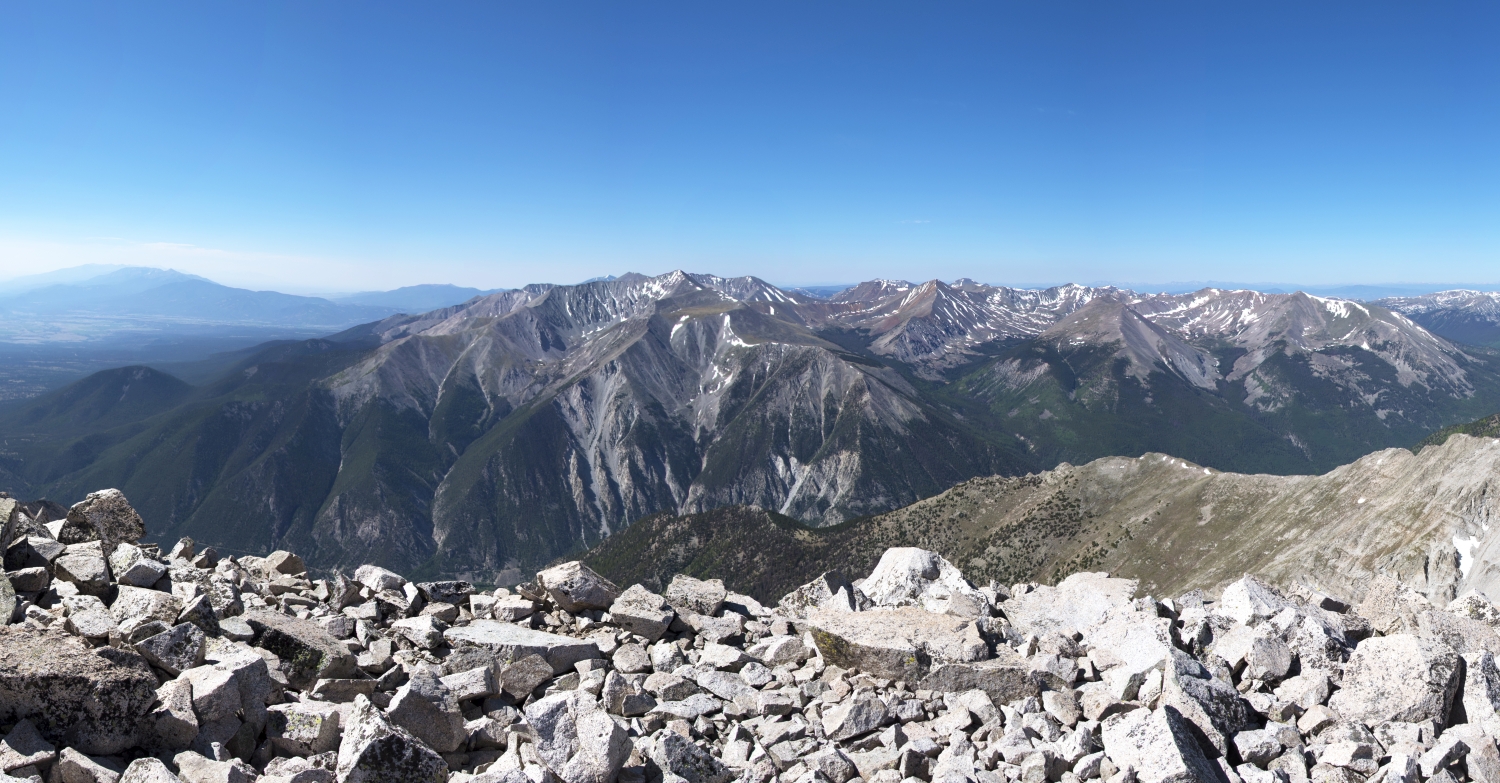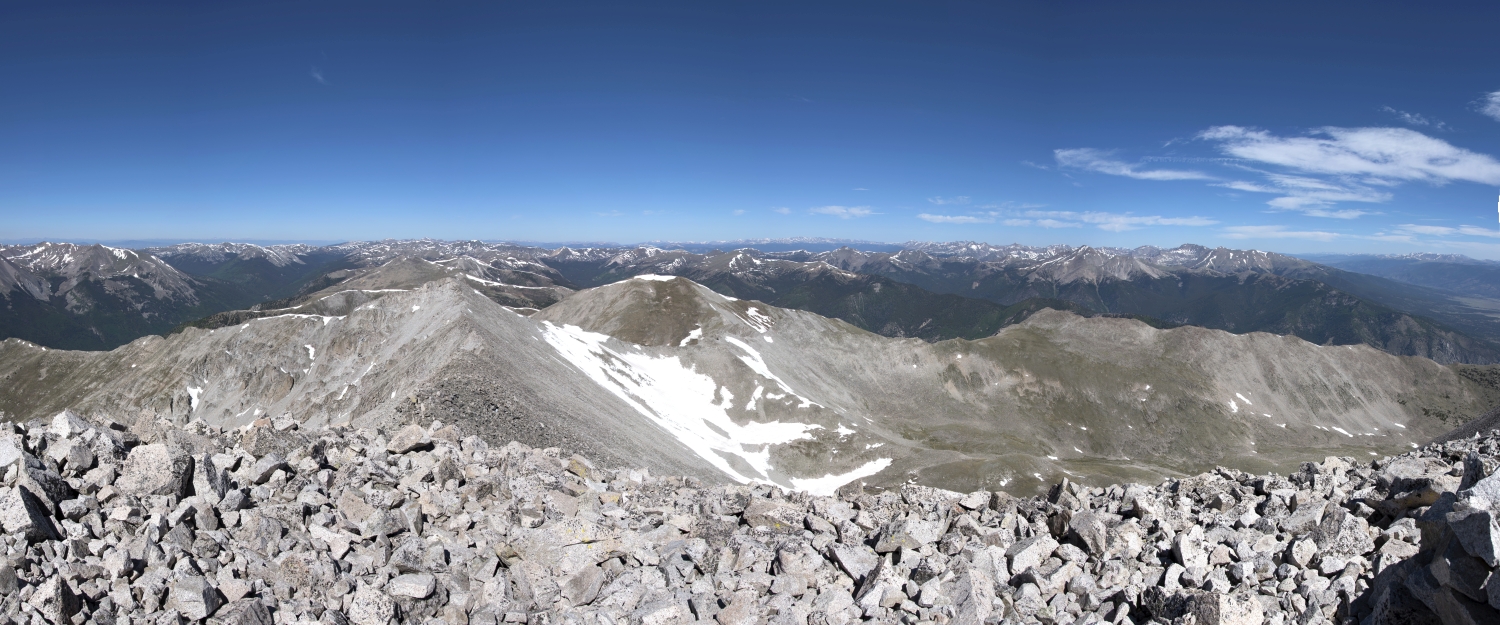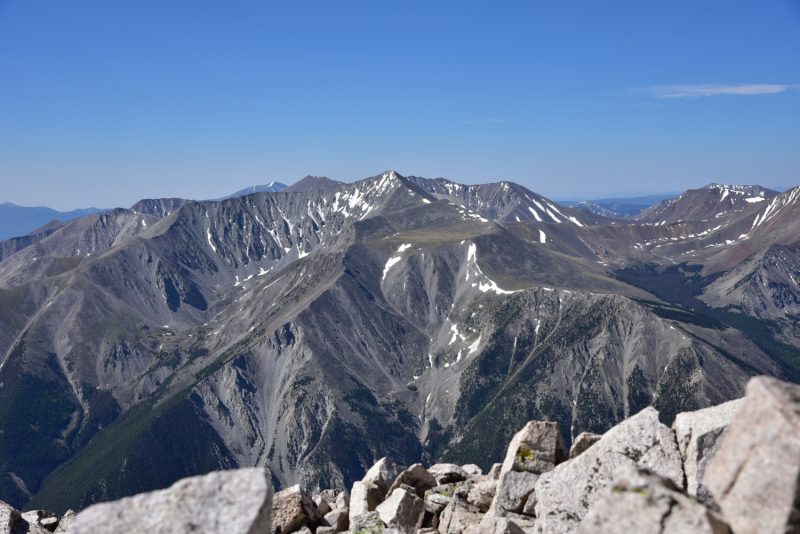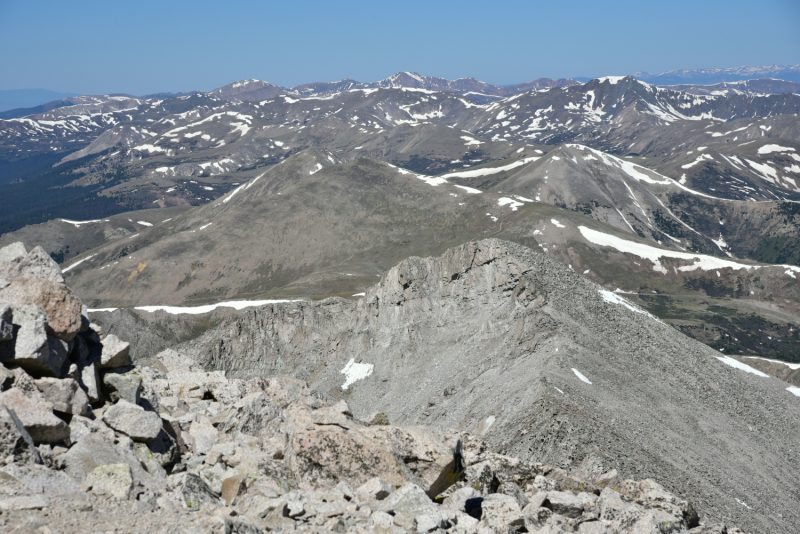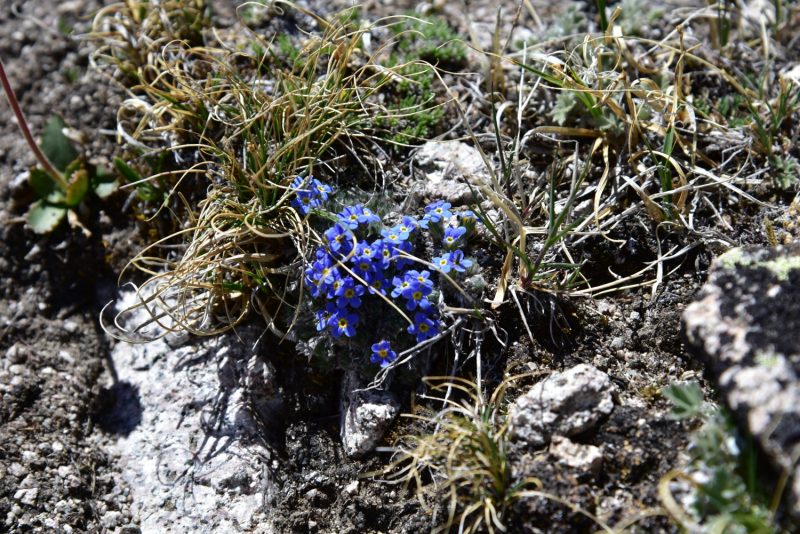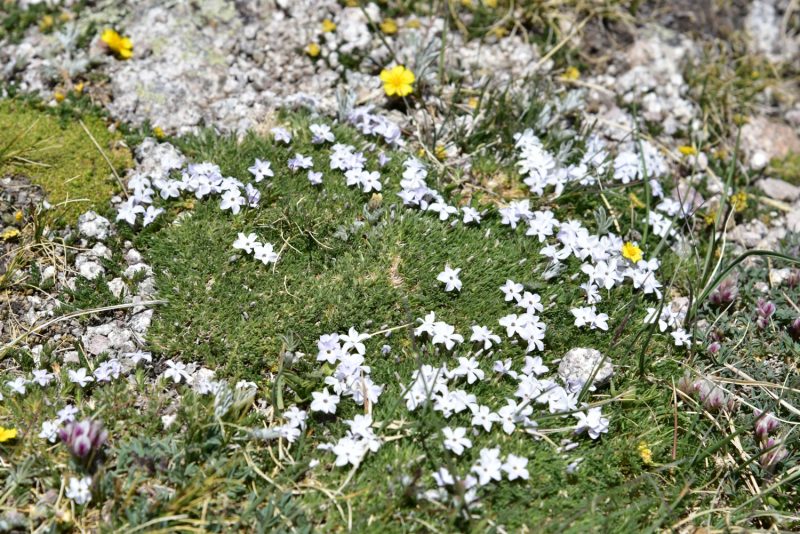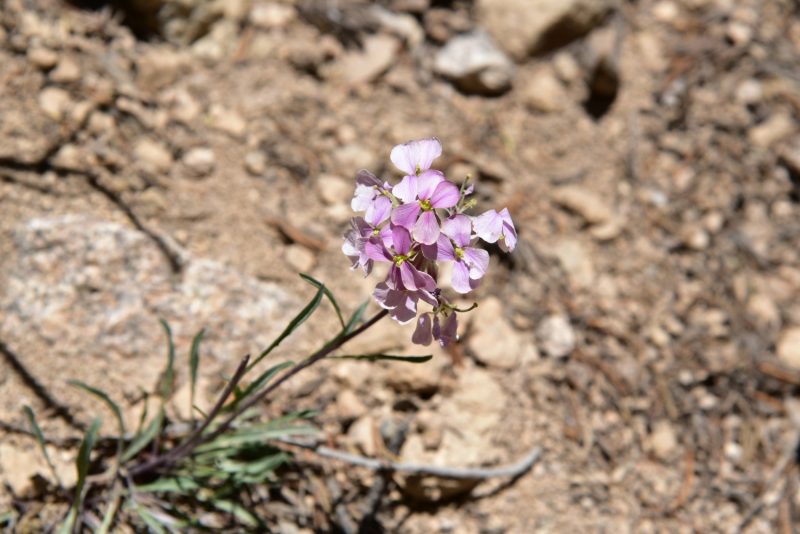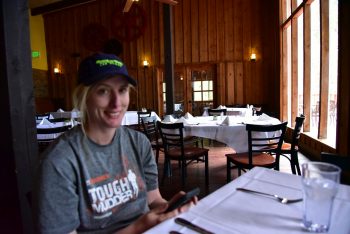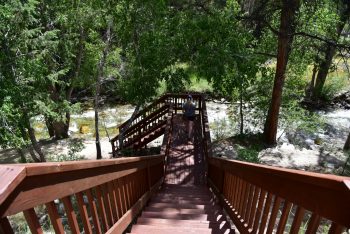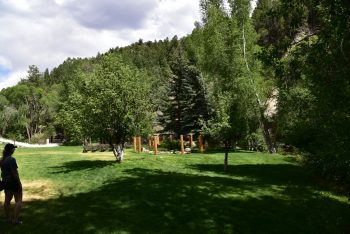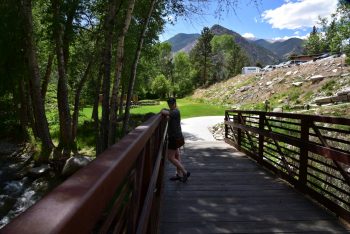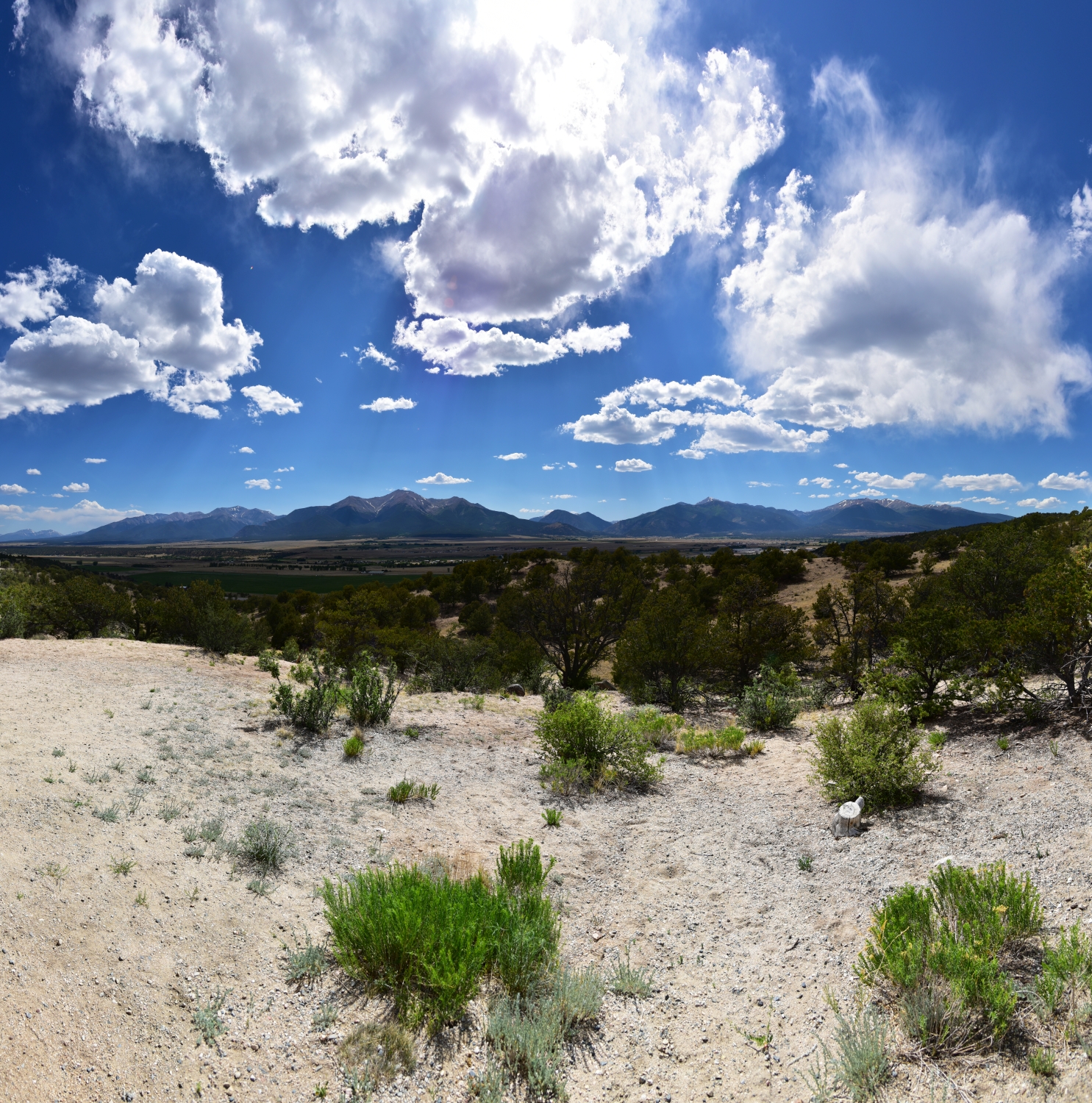Take a Walk
A Quest into the Wild
Redcloud and Sunshine Peaks
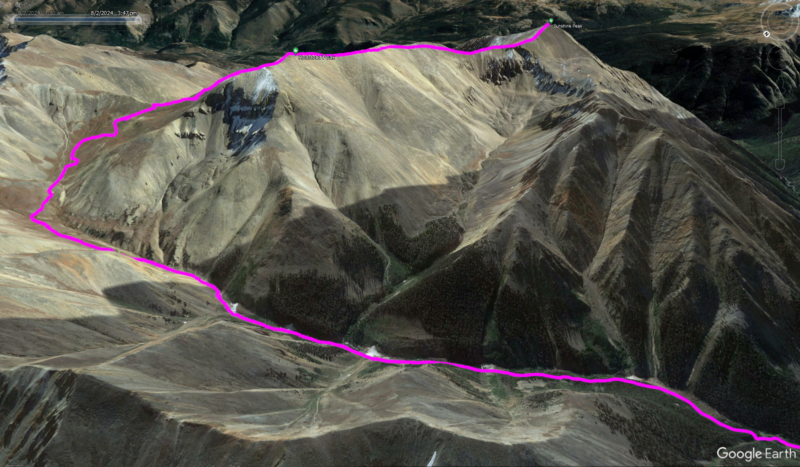
Stats: 12.25 miles with 4,800 ft elevation gain; Class 2; climbed 8/2/2024.
This will be the first post in a while for our blog. We have been climbing and getting out there, but life just seems to have happened. We did climb Mt. Blue Sky and Bierstadt this year as well as some other hikes to get ready for Redcloud and Sunshine. It was a long day and we were a little tired coming back to Redcloud from Sunshine. I gave it a difficult rating for length, but we’ll have to think about a better rating system for our hikes, since they are so diverse. But let’s get into it.
We stayed in Lake City, Colorado, for this hike and drove in on Colorado 30. It is a pretty nice road and I’ve talked about it before for the hike on Handies Peak. The shelf road is still in pretty good shape and I’d say that a vehicle with good clearance can make it to the trailhead just fine. I never used 4-wheel drive in the X-terra, which we’re still driving. For fun, here’s a picture of that shelf road and of the trailhead parking lot.
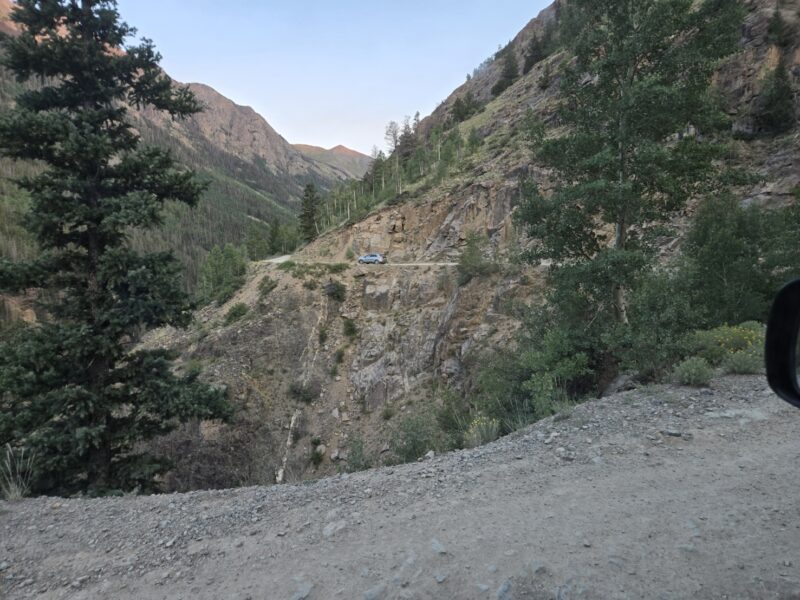
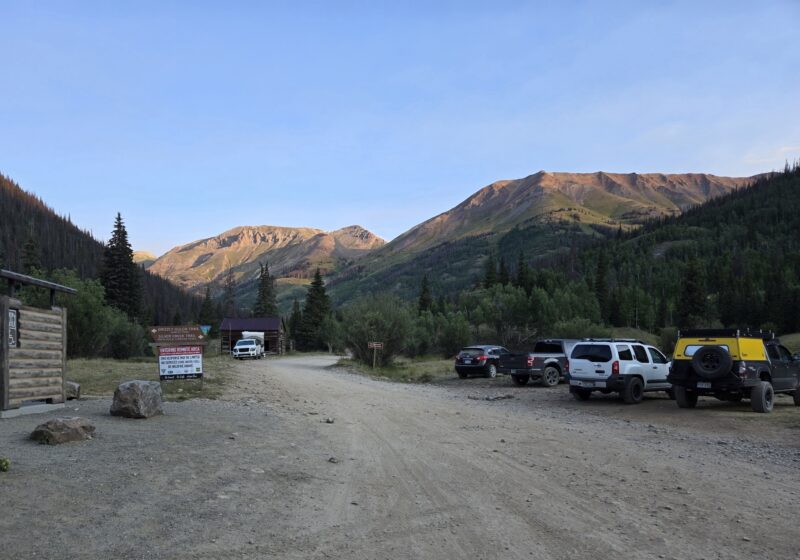
Be careful on those turns, since it is only wide enough for one car and someone is going to have to back up. Anyways, we got going at 7:11 am with a solid weather forecast and decent looking sky. I’ll say that the first quarter mile or so is pretty steep with not much of a warm-up. It is through some trees and you can hear the creek on your right. But a solid trail and I’d say it doesn’t surpass class 1 until you get to the first saddle. I have some shots below that look back towards the trees from the trail, except for the one in the middle which is looking up towards the basin.
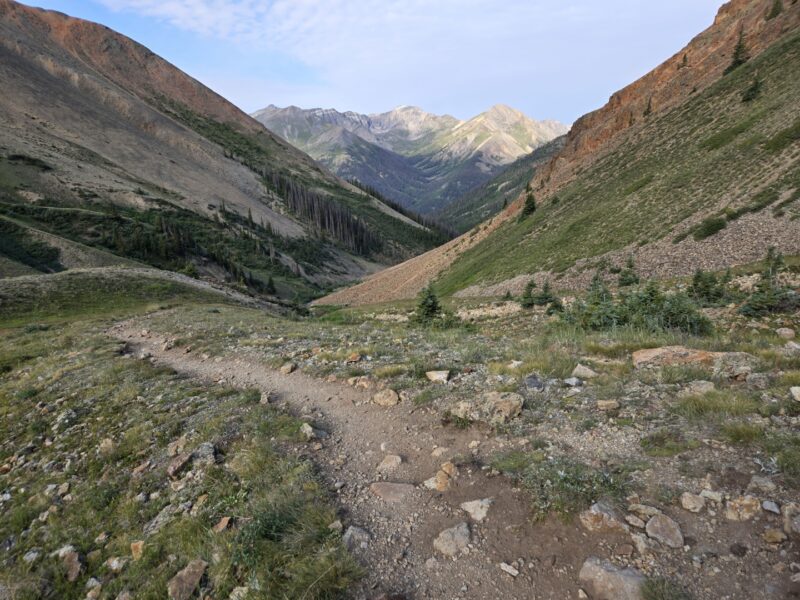
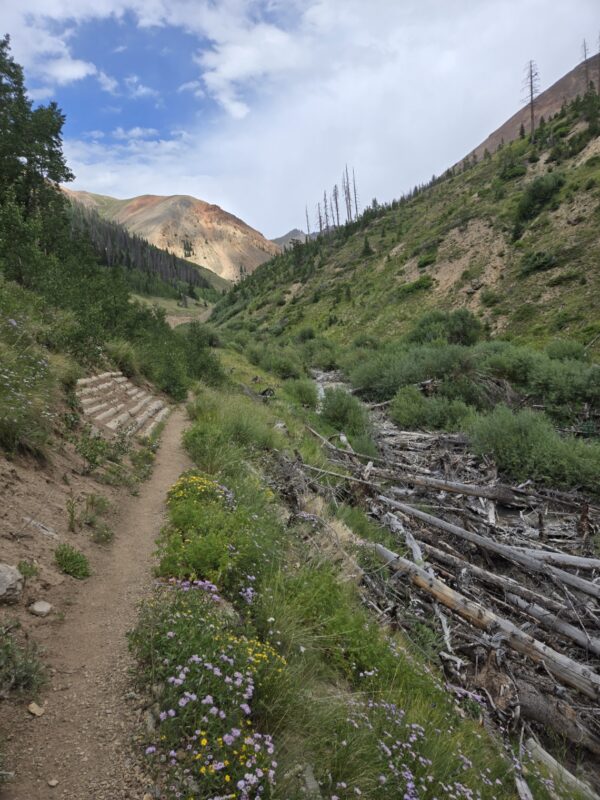
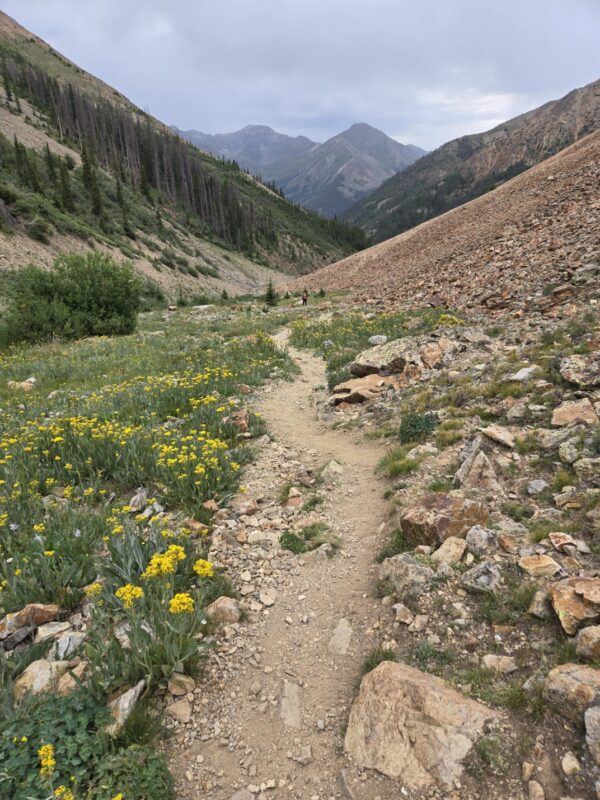
As you can see in the satellite image I put up of the hike, you make a ‘U’ shape around the basin as you head up towards the first saddle at around 13,000 feet. It was a beautiful basin and the trail was very, very nice. Lots of wild flowers were still out. We were feeling strong and loving the cool mountain air. Below are some images from that portion of the hike.
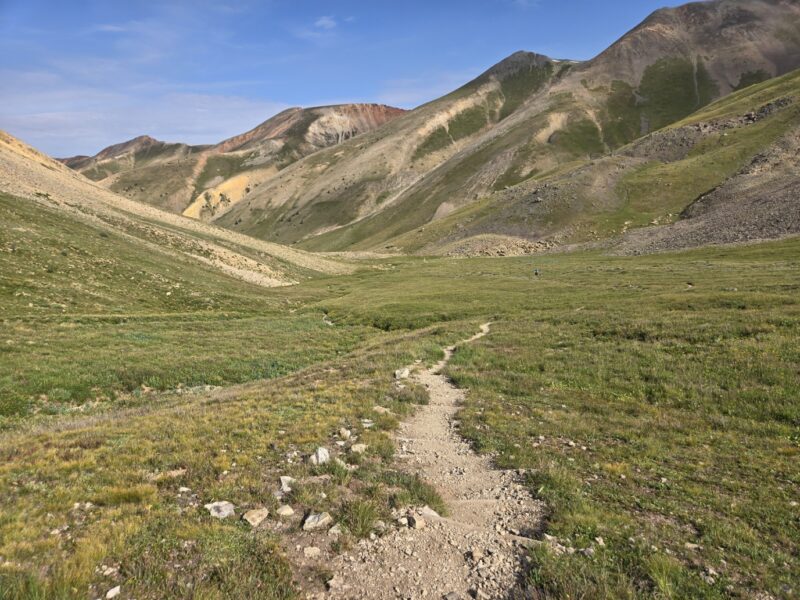
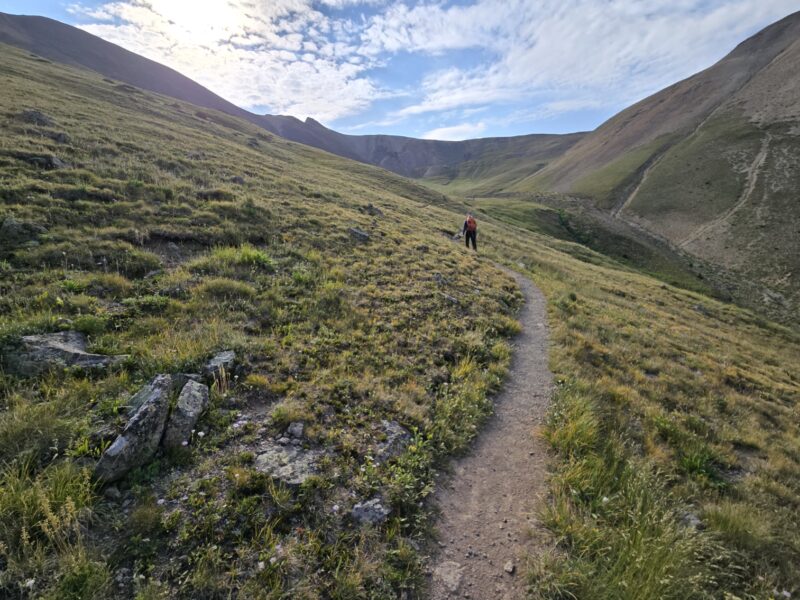
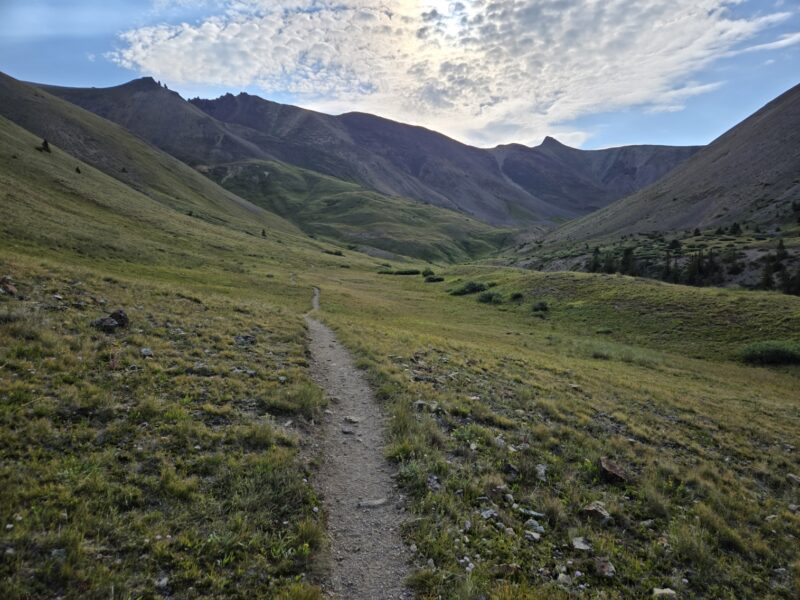
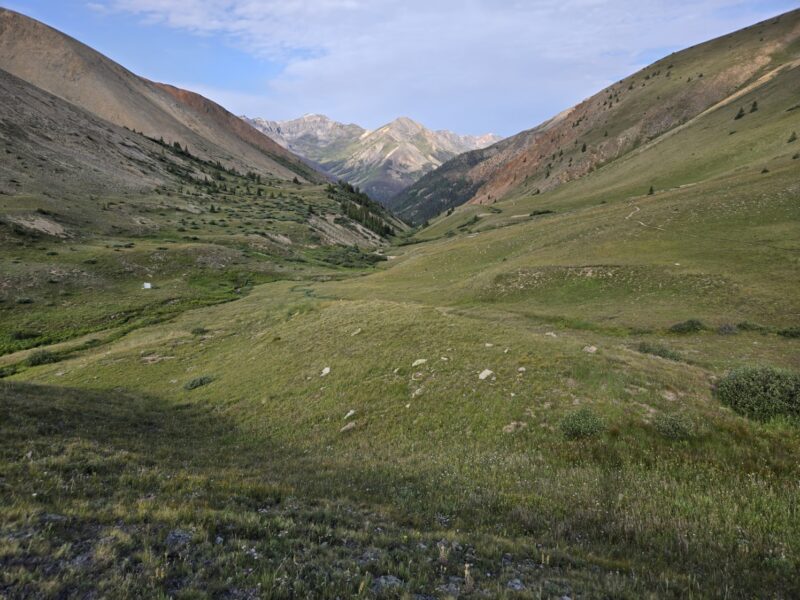
After hiking through the basin area you begin to head up steeper terrain towards the first saddle. It provides pretty views looking back at what you just hiked. At this point, you have hiked about 3 miles and it is hard to believe that Redcloud is only 1.5 miles away, though you can’t see it yet. Making your way up to the saddle you will see a large cairn at the top. Once there when you look right you will see two peaks with a saddle. The peak on the left (the big red one) is Redcloud. You are at about 13,000 feet and can see most of the remaining route to Redcloud. The images below show the view towards the remainder of the route as well as looking the opposite direction towards other non-14er options for hiking.
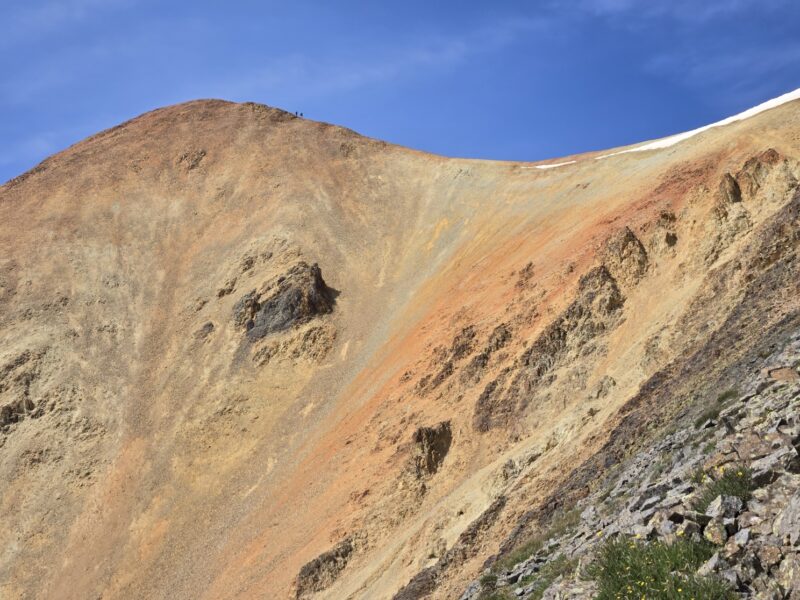
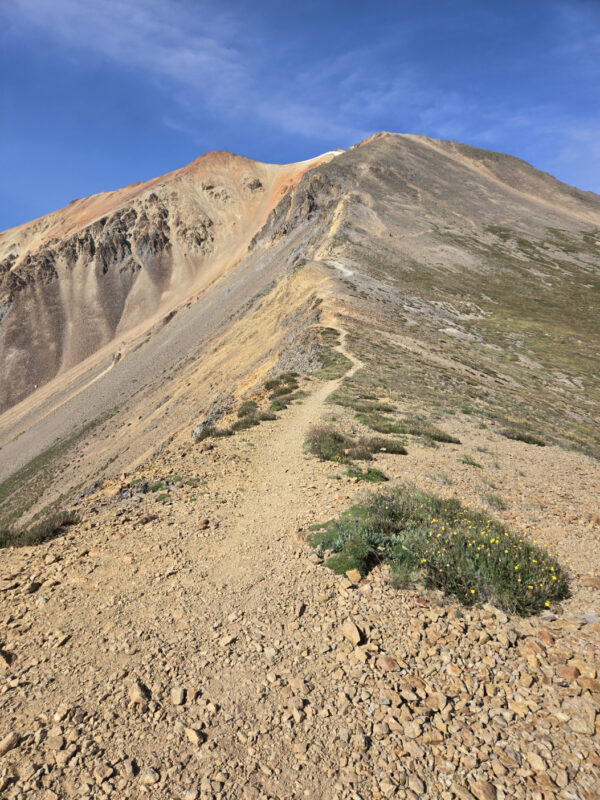
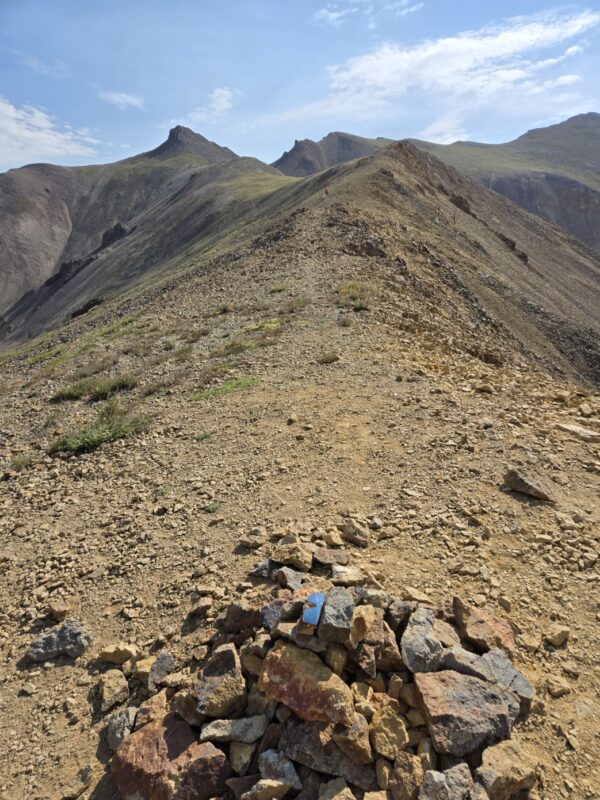
This is where I’d say the climbing changes from class 1 to class 2. This is due to some route finding you have to do going up to the false summit. I’m going to post below an image of the GPS as well as an edited picture of the hike up, since it is a little confusing as noted by a few other hikers. Alright, so there are two signs that say “Trail” with an arrow pointing to the correct (or official) route. The signs are at the base and top of the route labeled 3 in red on the image on the right, which is why that is not the “correct” way. The official route is the path labeled 1 in the image on the right. Route 2 is what we accidentally took on the way down when we turned too early on a byway trail. It was very loose and rotten and not a good path. I will say I saw hikers on all 3 of these and let’s face it, none of them are going to get you into class 4/5 climbing, but in an effort to minimize erosion and keep the trails nice I’m posting this here. Bill Middlebrook has similar images on 14ers.com.
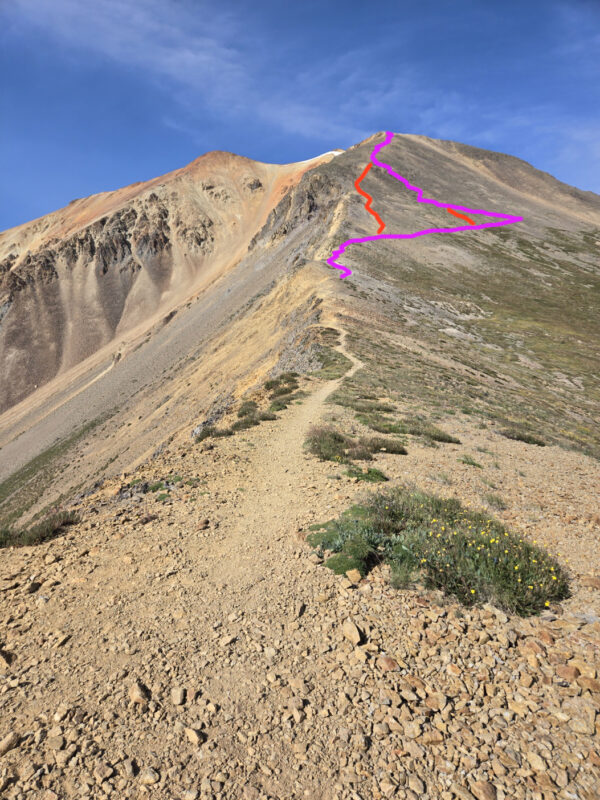

Once you get up to the false summit you can see the last 100+ ft of the climb. It looks kind of cool with all the red dirt and rocks, and you can look back towards the saddle for a cool view. Honestly you can look anywhere and you have amazing views. This is a really awesome peak. The big image is the remaining route. You are at about 13,900 feet here and have hiked about 4.25 miles.

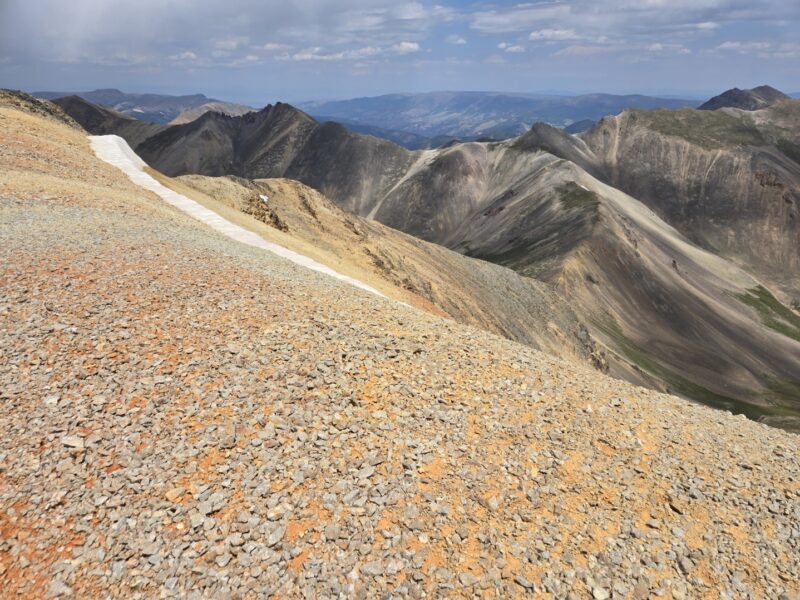
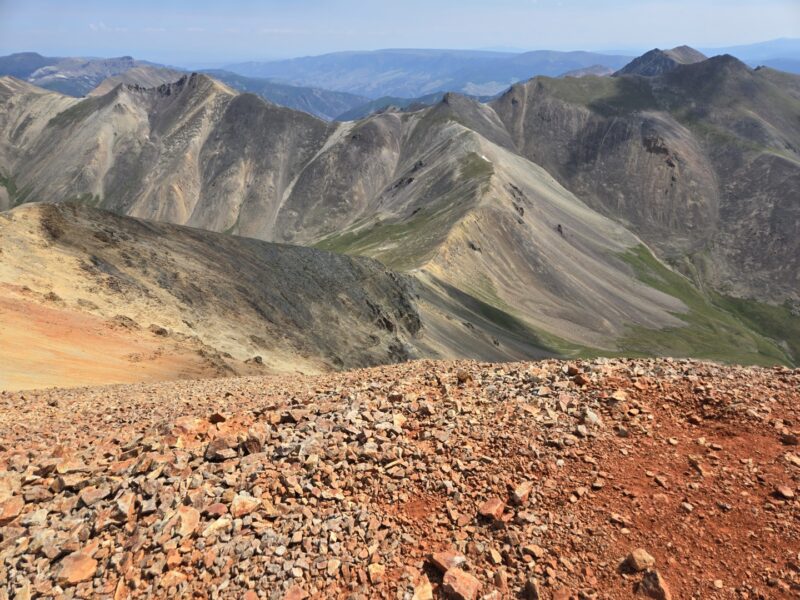
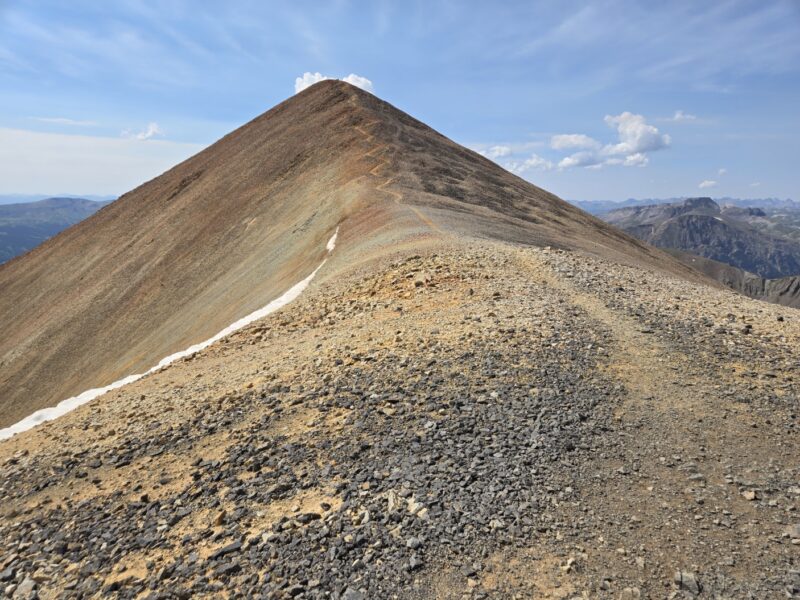
The summit was so red! It was really cool. I could imagine how on a foggy and cloudy day if you just saw that red up in the sky it could look like a red-cloud. The summit has a little rock shelter but not much else. It is flat and not very rocky, easy to walk around. You can see the route to Sunshine from here, but part of the route is obscured by a hump in the middle of the route. But I do have a picture with Allyson that shows Sunshine in the background (top left and top middle show Sunshine). It took us about 3 hours and 30 minutes to summit Redcloud with breaks, which covered 4.5 miles and about 3,700 feet of gain.
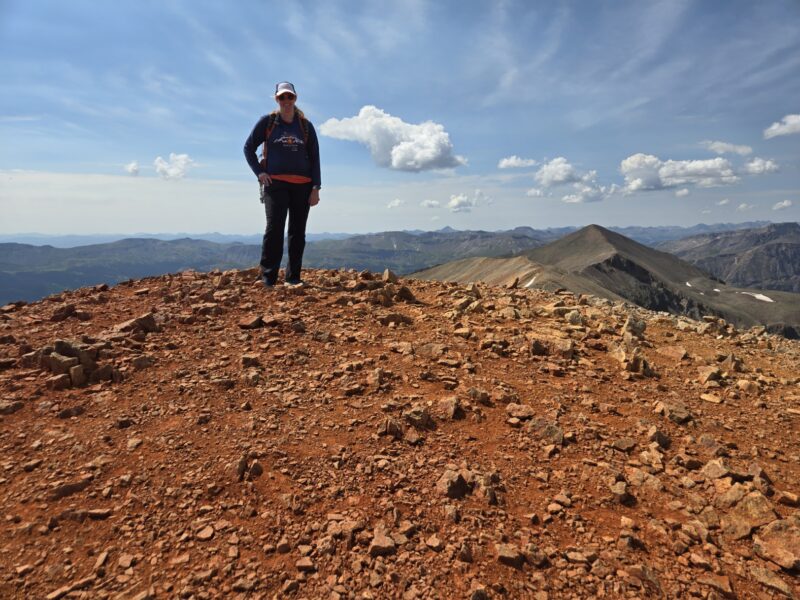
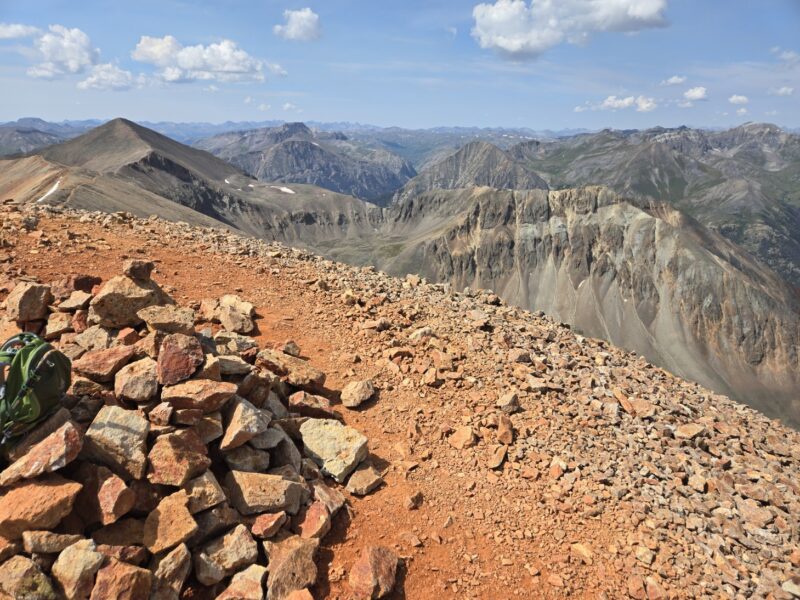
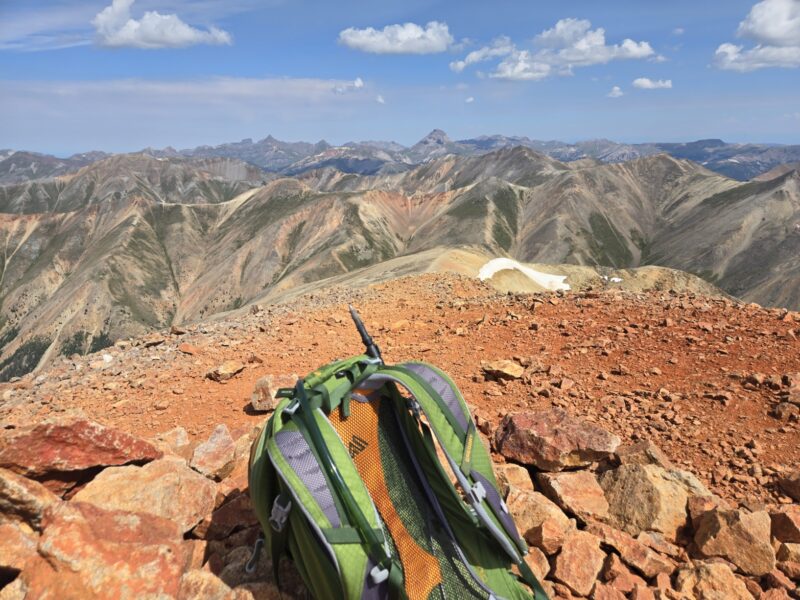
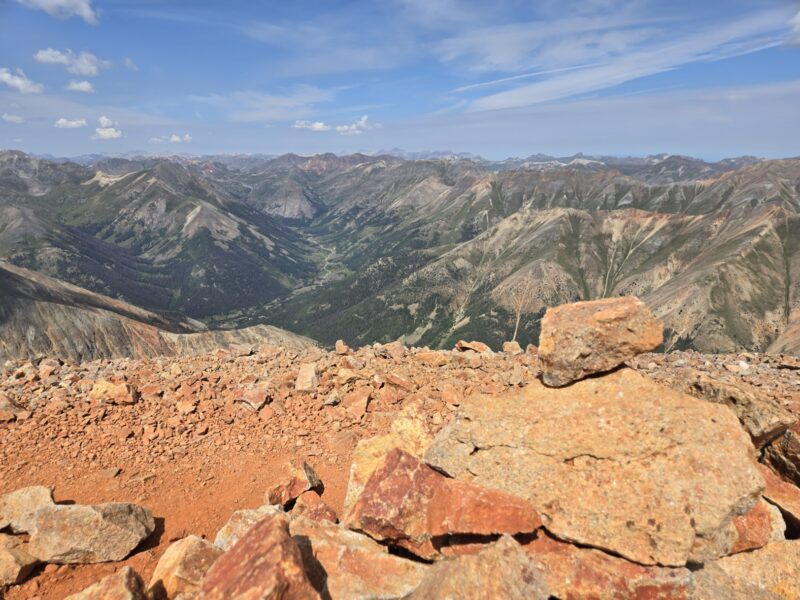

From here the trail is pretty clear and is class 1 hiking — albeit at 14,000 ft. We were feeling pretty strong and the weather looked good so we decided to go for Sunshine. I will say that headed up to Sunshine I realized I was feeling pretty fatigued, and wondered if I had made a mistake! The ridge hike over to Sunshine is a little rocky at points, but never exceeding class 1 in my opinion. It is 1.5 miles one way and adds 3 miles and 1,100 feet of gain total. I am going to post some images below of that section. Since it’s easiest I think to see the route from Sunshine I’m going to post some shots in order looking back towards Redcloud along the hike. The first image is closest to Redcloud and so forth until you get to the big one which is looking back from the summit.
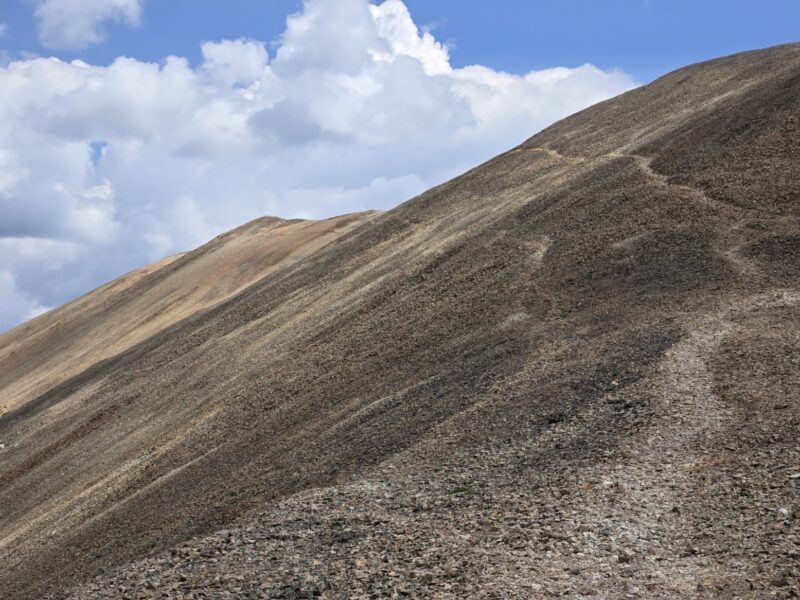
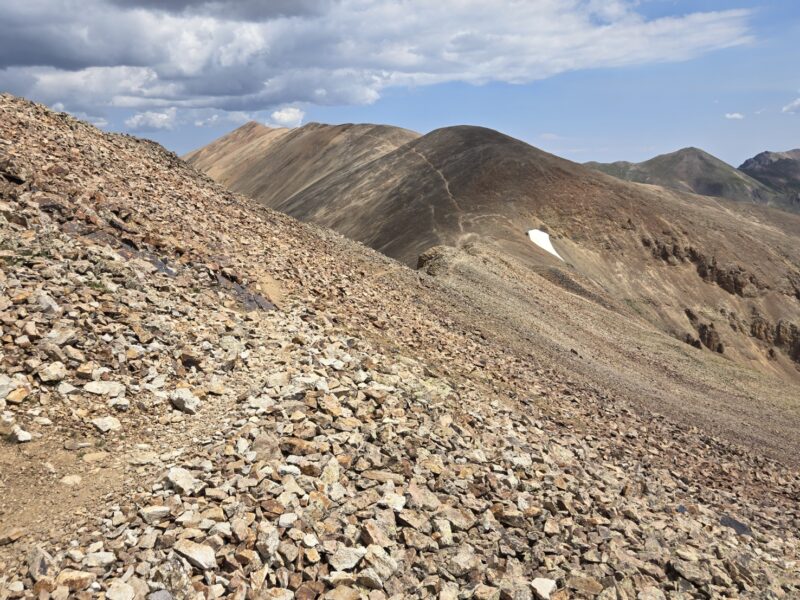
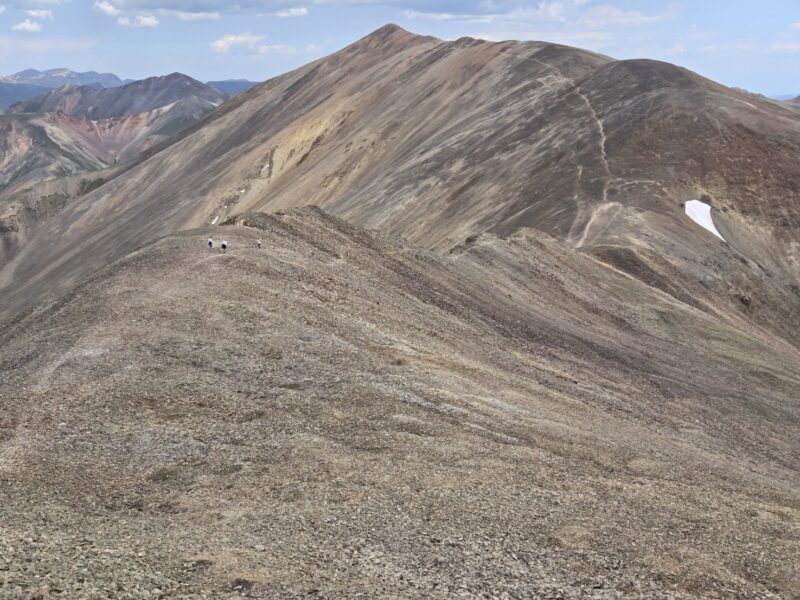

When you get to the saddle between Redcloud and Sunshine there is a sign that tells you not to descend the gully. Don’t descend here, if you want to make a loop then check out the notes further down. I’ll put a pic of the sign with a cool shot of Sundog (a 13er) in it.
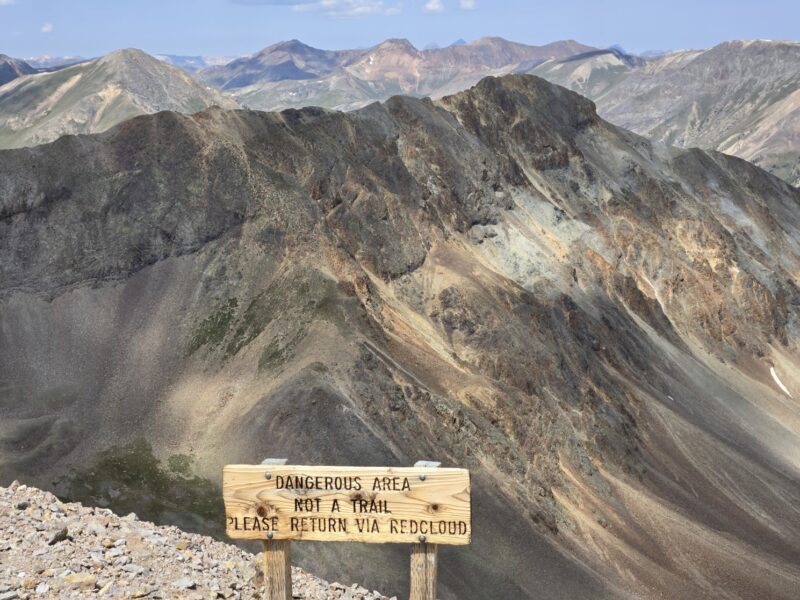
The summit of Sunshine was nice, but not red at all. Just shows how dramatically different summits can be even when their neighbors. You can see Handies off to the northwest and Uncompahgre to the north. Below are a few pics.
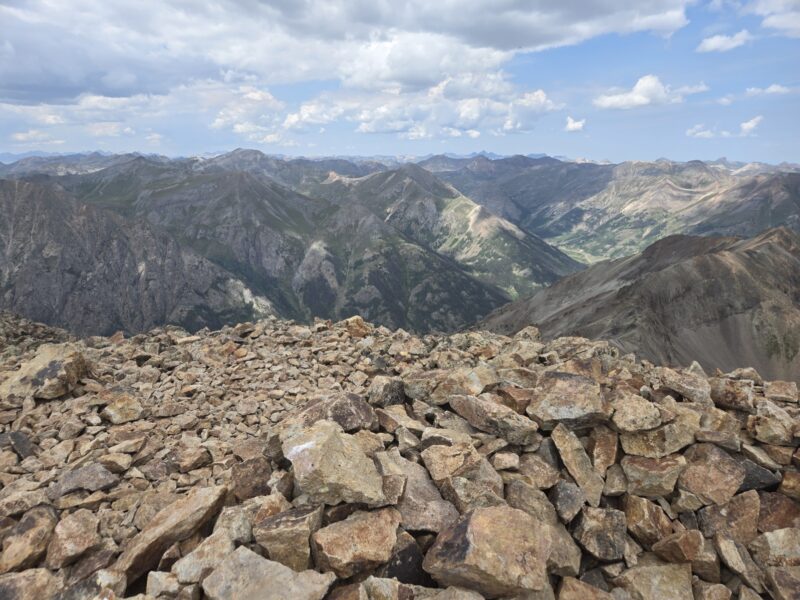
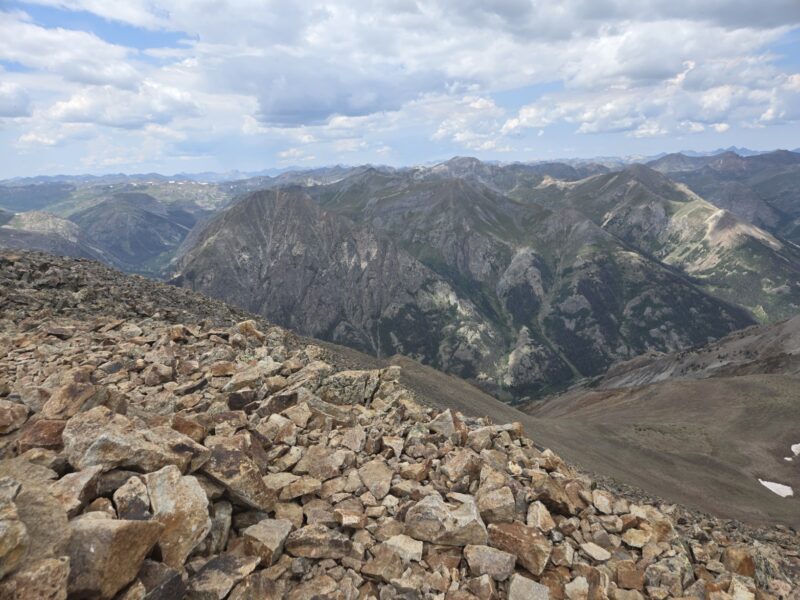
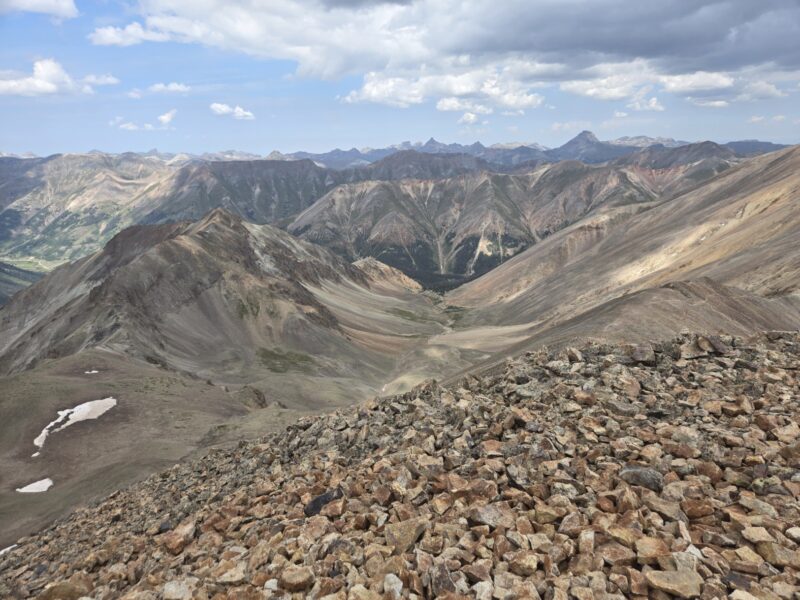
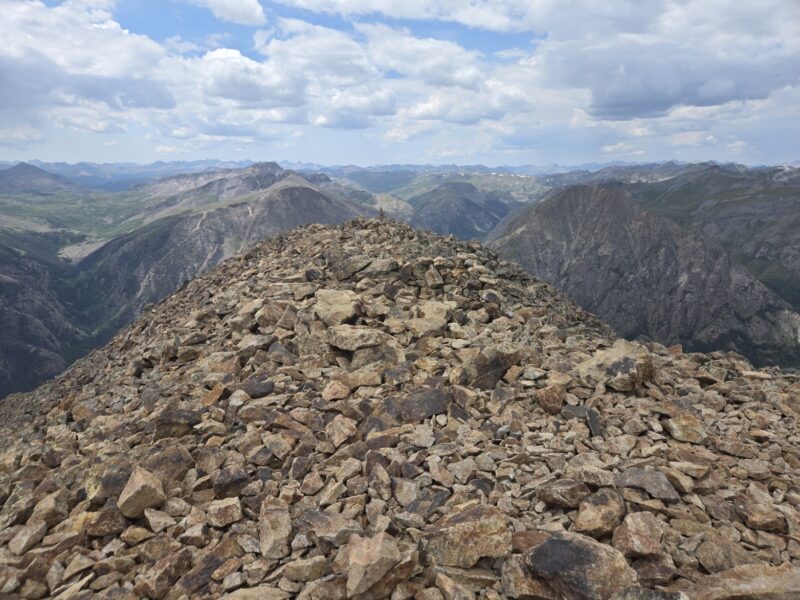
On Sunshine Peak we noticed some clouds rapidly forming, and it was around noon, so we hustled on back to Redcloud (the weather folks were saying chance of storms maybe after 3pm but probably more like 6pm). The hike over to Sunshine and the hike back to Redcloud took almost exactly an hour each — so maintaining about 1.5 mph with breaks. Once back on Redcloud, we opted not to linger too long before making our way to the 13,000 foot saddle. However, as discussed above about the route finding heading up/down from the false summit, we turned too quickly and ended up on a very steep and nasty segment. However, back at the saddle point we felt we were in pretty good shape and were feeling more energized after eating and drinking a bit.
Naturally, once turned around on Sunshine the rest of the hike was just the first part but in reverse. You can make this a loop, but it is reported it is much harder and can get you into trouble if you don’t know the route well. To make it a loop, you’d take the Northwest Face route, which is described on 14ers.com, either down from Sunshine or to summit Sunshine. I’m thinking I’d want to try summiting Sunshine first, then hiking to Redcloud, and then going down the standard route. But hikers do it in reverse. I do have an image that I marked up to show which gully you’d drop into (14ers has much more information on this so I’d go there if you plan on doing this route).
There is somewhat of a trail down Sunshine to the West that leads to the flat section you see in the image. There is a trail that leads over towards the ridge with the x’s and checkmark. You want to find the gendarme between the checkmark and the big x and hike down to the right of it. If you’re coming up you’d hike up to the left of it. The green line/arrow shows the route to go to Sundog Peak, which is a 13er.

Given that we haven’t done this route. I’d go to 14ers or another site/trip report for more info. But since I was looking at it thought I’d post this pic and mention it as a possibility.
Alright, so we had reversed it and headed back. Unfortunately for the area it did not rain, despite threatening clouds. We noted that the water towards the top (above maybe 12,000 feet) looked pretty clear, but that lower down it looked like it was polluted potentially with mining run-off. I’m not sure how safe it is to drink (luckily we were good on water). I want to post a few nice pics below to showcase the hike.
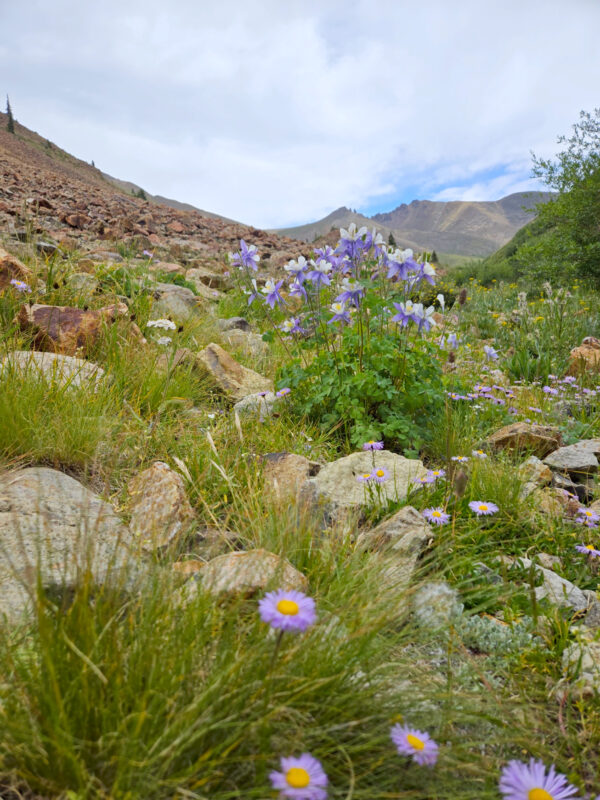
Really beautiful columbines on the hike with mountain daisies.

Just such a cool vista with Uncompahgre in the top-right corner of the image. Taken near the false summit of towards Redcloud.
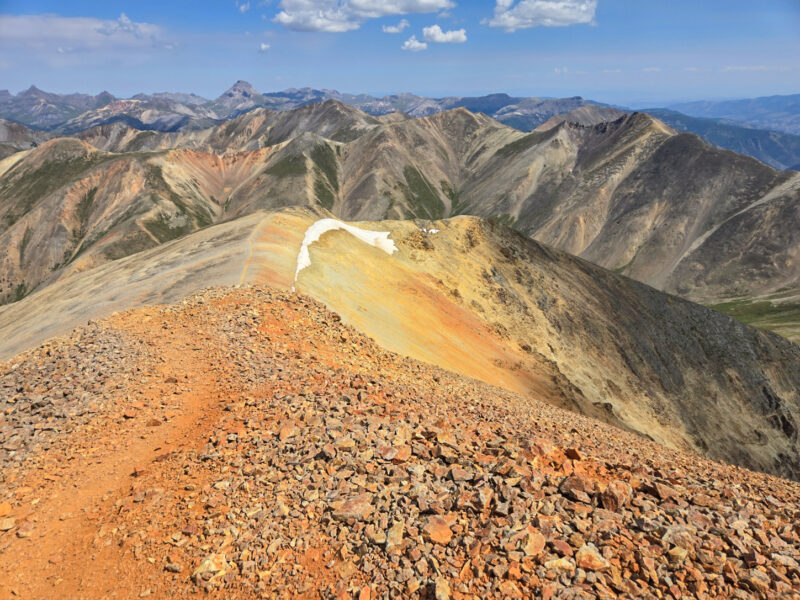
Highlighting the vivid colors on the hike. Taken near at the summit of Redcloud.
Thank you for reading. Our GPS lost us at a few points and at a particularly long section near Sunshine Peak. So the stats are based on 14ers and my own estimates. Be safe and have fun out there!
Camp Muir, Mount Rainier 10,100 ft
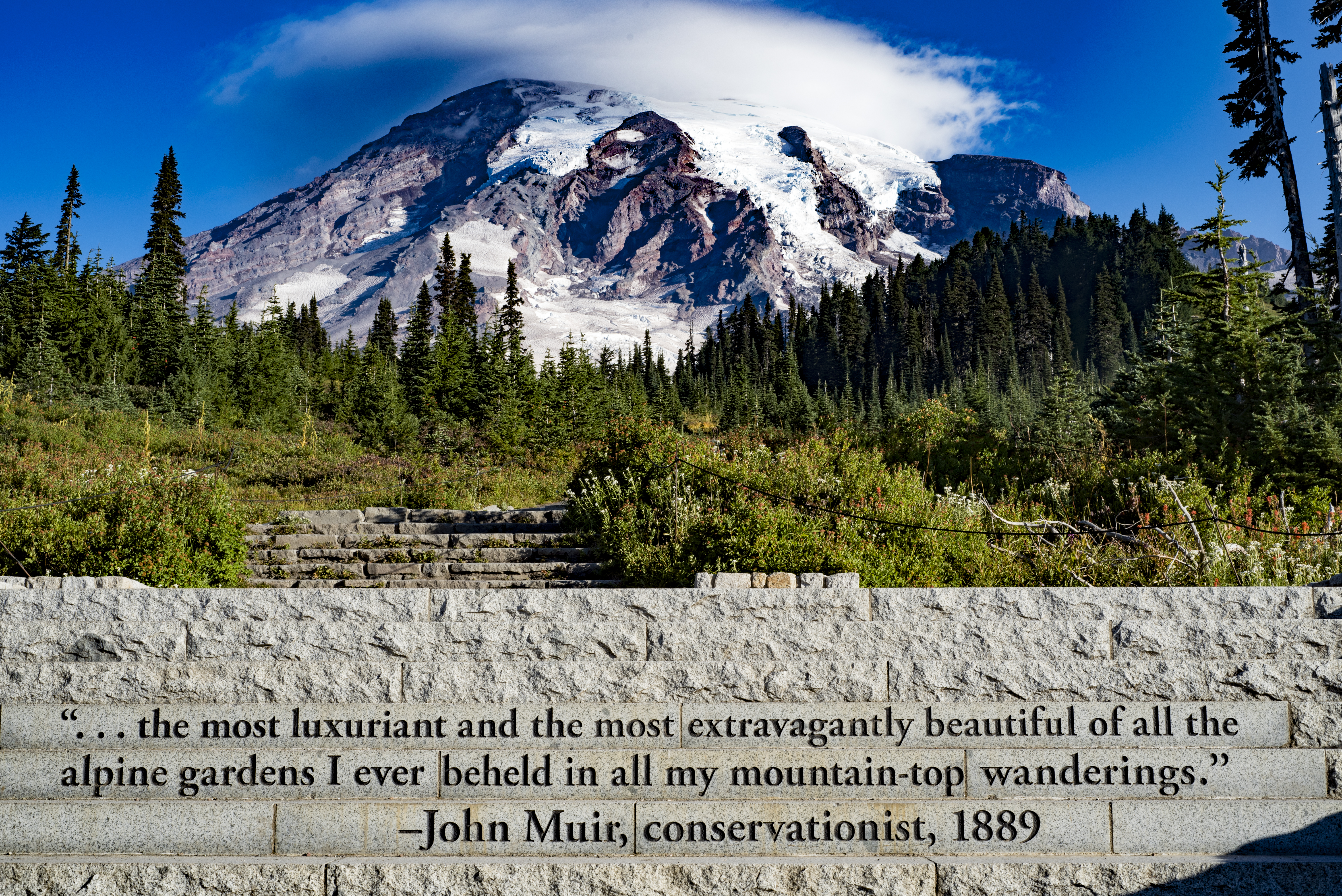
Some Background and History
A rich geological and human history both contribute to the wonder of the stratovolacano that is Mount Rainer. The peak was forged by fire and years of lava, ash, and pumice piling up, layer upon layer, eventually forming a summit cone, a consequence of thousands of years of volcanic activity. Close to 6,000 years ago, the peak had a violent eruption which knocked off the cone, and subsuquent years of volcanic activity left the peak with two overlapping craters at the top. It is the largest peak in the Cascade Range and sits prominently above all other peaks in the nearby vicinity at a stunning 14,411 feet above sea level. For perspective, the others sit around 6,000 feet. The mountain face is constantly changing as fluctuations in the weather and temperature shift and melt its heavily glaciated regions. Every few hundred years, small to moderate eruptions occur, with the most recent occuring in 1894. Importantly, the mountain is still an active volcano.
The Mount Rainier region has always pulled humanity close, providing natural resources and in more modern times, recreational ones. Native American tribes have gathered for millenia to hunt and gather resources here. The first recorded ascent occured in 1870 by Rhode Islander, Hazard Stevens. The park was established in 1899, and the true infrastructure began to take shape following the creation of the National Park Service in 1916, though the road to Paradise had been in place since 1910. There has been some tumultuous history of the park through the years, that we won’t go into here, but relative stabilty has been achieved since the 1960s. Visitation continues to boom, with 1.8 million visits recorded in 2016. The number of attempted climbs of Mount Rainier is also large. In the last 8 years, there have been between 10,000 and 11,000 yearly registered climbers.
Our Trip
We have not escaped the allure of Mount Rainier and decided to plan a visit to the mountain in mid-September as part of a week long excursion to the Pacific Northwest. Though we did not decide to make an attempt at the summit as we had insufficient time to secure guiding resources, we did want to go halfway and visit the famous Camp Muir. Camp Muir, named after the famous alpinist, is nestled at 10,100 feet above the Muir Snowfield and on the edge of the Cowlitz Glacier and serves as base-camp for those planning a summit attempt. Reaching the camp requires a mix of trail hiking and traversing the unmarked Muir Snowfield. The one way trip is roughly 4.5 miles with close to 4,800 feet of elevation gain from the Paradise Visitor Center. The National Park Service recommends the trip for only experienced hikers as there is no marked path up the 2.2 miles of the snowfield and white-outs are frequent.
Skyline Trail
On September 6th, we flew in to Sea-Tac and immediately drove down to our quaint cabin nestled in the woods approximately two miles from the park entrance. After a good night’s rest, we arose at dawn and made the short drive into the park to the Paradise Hiker’s parking lot. Blue, clear skies were abundant, and we began our journey on the Skyline Trail. The trail is an extremely steep and well-paved path for the first 10-15 minutes of hiking before it turns into a much more pleasant gravel/dirt path. There were several signs along the way to direct us to the direction of Camp Muir on this portion of the hike as many side trails exist to gain different vantage points of the the nearby glaciers and the mountain. Near mile 1.1, there was a junction in which both routes go the correct direction. Going left leads to Glacier Vista, overlooking the Nisqually Glacier to the west which also has a waterfall. Going right bypasses the ridgetop and takes hikers on a more direct route. Of note, the trails do reconnect fairly quickly. On the way up, we bypassed the overlook and continued toward our objective. At approximately 1.6 miles, we saw the sign for Pebble Creek and followed it to the creek at about 2.1 miles. We climbed over the creek and past McClure rock. Looking down at our GPS, we noted an elevation of about 7,300 feet. The trail had now ended. It was time to throw on the spikes. We entered the snow.
Muir Snowfield
Our spikes grabbed the snow easily, and we proceeded upward and closer to the upper reaches of Mount Rainier. We took the most obvious path forward and kept near earlier bootpack and some glissading paths. Camp Muir was not yet visible. The snowfield appeared to stretch for miles and miles. Intermittently, there were some brief breaks in the snow via small sections of rocky outcroppings. We used one once to sit and dress a blister since it was preferable to sitting in wet snow. The snow was a strange redish muddy color in places. We’ve been told this is common in late summer due to pumice and ash. At 8,600 feet, we noted the turn off for the ridge that connects to Anvil Rock, a 9,000 something foot detour on the way to Camp Muir. We had our goal in site and did not choose to venture on this scenic path this time around. In the remaining mile on the snowfield, we acsended roughly 1,500 feet. It was intense. We kept checking the GPS thinking that it must be off or something. Surely we are higher in elevation with only a mile to go we thought. There were several wire wands in the snow with florescent tape marking the best path forward, which was helpful considering a few crevasses had started opening up on the snowfield. One we noted was 3 feet wide in places. Camp Muir and the snowfield are nearly completely surrounded by glaciers, and there are several warning in place by the National Park Service reminding hikers and climbers of the dangers of climbing the snowfield. Sadly, this hike has claimed a few lives when conditions turned poor. Backpacker magazine ranks the hike as one of the 10 most dangerous in America.
Camp Muir / Cloud Camp
Camp Muir was originally called Cloud camp, and aptly so. The small camp sits above the Muir snowfield on the edge of the Cowlitz Glacier seemingly floating above the world below. After John Muir made the 6th recorded ascent in 1888, the name of the camp changed. Excitement ensued as we began to get our first glances of the camp. The first structure that camp into view was actually the guide hut. Only the famous stone structures would come into focus as we got much closer. We followed the boot pack and continued upward. It was a bit farther than it looked. The blue tint of the glaciers were quite apparent now, and finally we touched of our feet on hard rocky surface. We had made it to Camp Muir. While we were only sitting slightly above 10,000 feet, the hike was not too unlike many of our treks up to 14,000 feet. The elevation gain was intense. The camp was full of life and busy just before noon on a pleasant Friday. There were several guide groups and camps already set up on the Cowlitz glacier. Half a dozen or so day hikers were already perched at the front of the stone sleep shelter. We spent almost 45 minutes at the camp, eating some food and relaxing in the beauty of our surroundings. It was interesting to see tents pitched on the edge of 6 foot wide crevasses on Cowlitz Glacier. There were several warning signs in place stating that unropped travel past this point was not advised. As we looked south, we could see very clearly Mount Adams and Mount St. Helens. Mount Hood was slighlty visible between these two mountains.
The Descent
It was finally time to return to the world below, and we reluctantly put our spikes back on and began our descent. It was afternoon now, and the snow had gotten quiet slushy. Even in spikes, we were slipping and sliding. We eventually determined that the most efficient route down the mountain was via running/sliding down the mushy snow in our boots. There were several glissading paths that we saw on the way down, but at this point, unless they were steep, it was very hard to gain any speed. Scarily, we noted that one glissade path led straight into a crevasse. Though it was only 1 to 2 feet wide, it was still a scary prospect to think that a joyous slide might land you in a deep ice pit. On the way down, we saw several guide-led groups heading up to Camp Muir for a night’s rest prior to the summit push. Many of them looked a bit miserable to be honest. Though one day, we may be returning and participating in that march, today we were free to frolick down the mountain. On the final section of steep snow before reaching Pebble Creek, there was a short but very steep glissade. Several groups gathered here, and we all took turns gleefully sliding down it. There was even a bump that allowed those of us with enough speed to catch some air. Pure Joy.
Paradise Mount Rainier
Once on dry, snow free ground we took our time enjoying the Skyline Trail. We took the loop that looks directly over the Nisqually Glacier this time. There were now hundreds of people out on the trail enjoying the bluebird day and exquisite surroundings. We returned to the Paradise Visitor Center and enjoyed the small but interesting display they had on the stratovolcano and then determined it was time for some real food and a soak in the hot tub at our Cabin. On the drive out of the park, we made one extra stop at Narada Falls for some beautiful waterfall pictures. This requires just a short hike down a steep path.
Parting Thoughts
The hike to Camp Muir was strenuous but rewarding and fun. The scenary was breathtaking virtually the entire hike. Prospective hikers to Camp Muir should remember that part of the trail is on a long snowfield covering nearly 2.2 miles and very steep at portions. While we had a safe fun day, weather can and does often deteriorate quickly and can turn the snowfield to a blanket of white leaving hikers with no sense of direction. This is particularing harrowing here, because there are cliffs and crevasses surrounding the snowfield. Compass/map and GPS are critical for this trek.
Side notes: Verizon had some cell reception at Camp Muir and a bit near Pebble Creek. AT&T had none…anywhere. Also there is a cafeteria at the Paradise Visitor Center. We got small snacks here and they were tasty but expensive. We ask the cashier why the prices are so high. He replied ” that’s the high altitude tax” of which we replied “hey man, this is the elevation of our living room!” To put things in perspective, Paradise is only 5,400 feet above sea level, close to that of our home in the Mile High City. Sigh. Everything is relative. And lastly, eat dinner at Copper Creek Inn Restaurant right outside the park. It was amazing!
Mount Princeton 14,197 ft, Sawatch Range
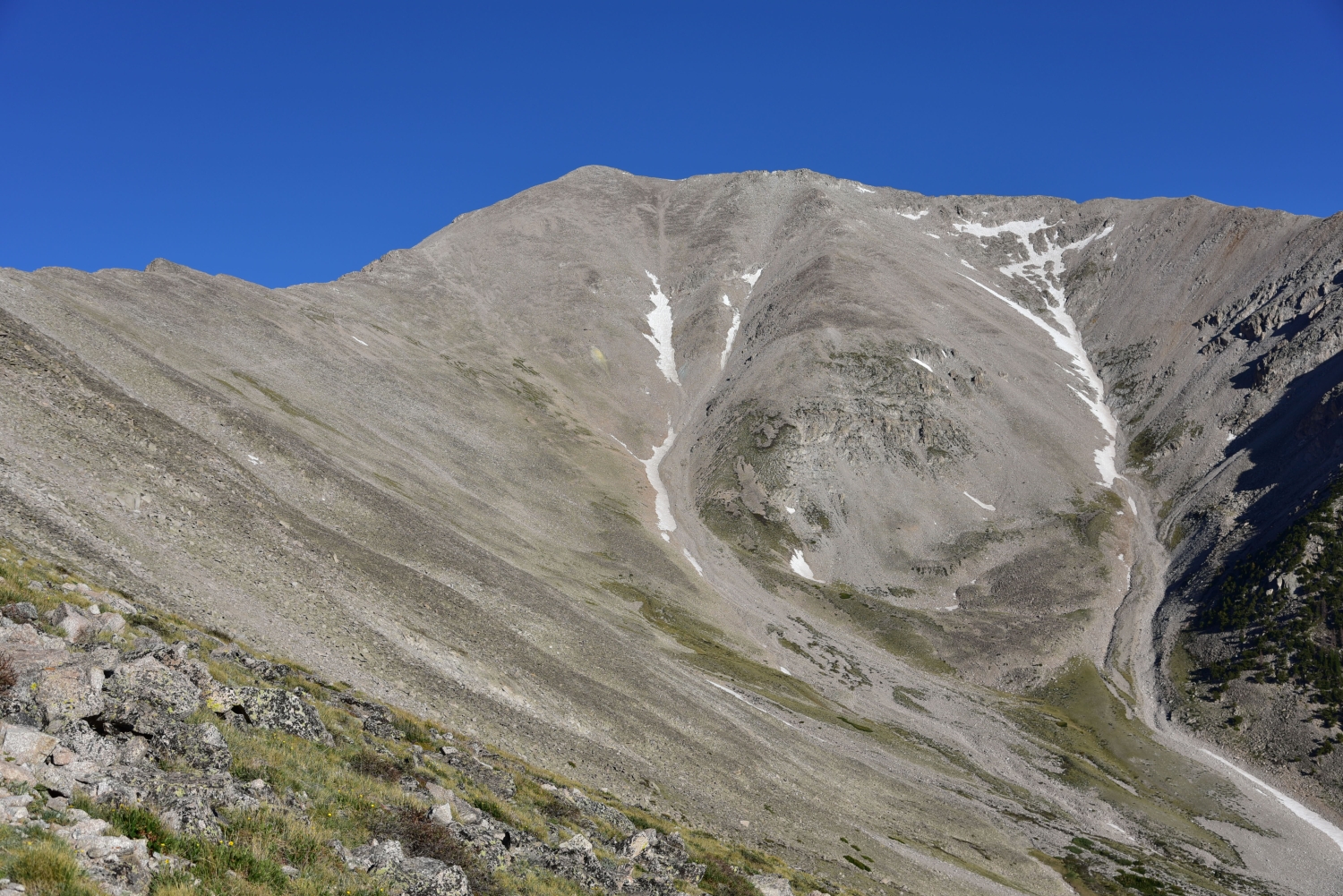
Though the hike up Mount Princeton will be described in better detail as we go along, the photographs above provides a fairly accurate summary of this mountain for those seeking to summit this summer. Talus hopping, navigating steep scree- filled slopes, and dodging the apparent infestation of spiders spinnning their intricate webs among the maze of rock were interwoven into our day. In between the scree surfing and selecting our next boulder step, we drank in the views of the bright blue sky above us and the exquisite alpine around us.
Mount Princeton is one of the Collegiate Peaks located in the Sawatch Range. It’s 14,197 feet above sea level and prominently sits above the small mountain town of Buena Vista. The lower TH is easy to get to, with a large parking area, but be warned, starting from here makes for a much longer, more strenuous day. Hikers will need to gain 5,400 feet of elevation and hike a total of 13.25 miles. We chose to take the X-terra with brand new all-terrain tires up the narrow 4WD road to reach the upper trailhead and camping spots located just past the radio towers. This reduced the gain and round-trip mileage to around 3,200 feet and 6.5 miles, respectively. Almost immediately, we encountered large dips and steeps gains along the road. However, the biggest challenge of the road is how narrow it is. There were several long stretches of the road in which there was no way for two-way traffic. We headed up around 4:30 pm on a Thursday afternoon hoping to not encounter any down hill traffic. Unfortunately, about half a mile up, three large suburbans/trucks were heading straight for us. While uphill traffic has the right of way, there was a small pull-out about 500 feet below, so we carefully backed down the road to let the others pass. The rest of the drive up was fairly uneventful, with the exception of some very large drop-offs as the path became a shelf road. It was slightly unnerving to have the truck lean slightly while skirting the edge of a cliff. Once we reached the radio towers, we continued on the road for another 0.2 miles and found a lovely campsite with room for our tent, two trees to tie our hammock, and spot for the truck. Seen below is a set-up of our camp, the radio towers, and wandering around the area prior to our hike the next day.
The temperatures were cool, but not cold as the sun began to set. We hiked up the road a bit further to enjoy the sun setting. Several spots had openings among the trees that offered views of the town below. As we hiked a little further, we also gained our first views of the summit of Mount Princeton. As it got dark, we retired for the evening. It was mostly a quiet night, with the exception of some strange noises at 3:00 am. At first, we thought it was the Colorado 14ers Initiative group perhaps working on something for the next morning. Their group was camping near us. However, as the noise got louder, it sounded as if it was coming from the car. We quickly flipped on the lantern, and made some noise, and the scrapping/grinding noise stopped. We never figured out what the noise came from, but we think some forest creature was attempting to get into our vehicle. At least this disturbance gave us a glimpse of the night sky. The inky black sky was dotted with a plethora of stars. The views were brilliant and such a amazing treat when coming from the city lights of Denver.
A short two hours later, the sun began to rise. It was time to get moving. All ready we could hear the few other hikers and CFI workers getting ready to start their day. We began our hike at 6:20 am. The morning temperatures were in the upper 40’s, but we quickly ditched our jackets as we made progress up the road. We continued to follow the 4WD road up for what seemed like close to a mile where we reached around 11,800 feet. As views of Tigger peak appeared, we began looking to our right for the trail turn-off for Mount Princeton. There is a large stone staircase that marks the start of the Mount Princeton Trail, and we didn’t have any trouble locating it. Online forums mentioned it can be easily passed by if snow is covering the steps or if you aren’t paying close attention. Missing the turnover will take hikers up the road to the top of “Tigger Peak” and then down the connecting ridge to Mount Princeton. This is the winter route to Princeton, and will add some distance and elevation gain to the day. Seen below are photos of the hike up the road and the turn-off to the Mount Princeton TH.
We were thankful to ditch the road and continue our journey on an actual trail, even if that trail became a talus field soon. We crossed the north side of “Tigger Peak” on relatively smooth trail for about a quarter of a mile until we reached the gullies. The trail crossed through mostly stable rock, and the elevation gain through here was modest. There was one remaining snowfield to cross when we summited on June 8th, but the section was well-boot packed and we had no trouble crossing. It was truly astonishing how little snow is left in the high country this early in the year, and also a bit concerning. As we hopped and skipped our way over boulders, we could see the remaining route in front of us and the summit of Mount Princeton. Compared to some of the other 14ers, we thought it honestly didn’t look too far away. Seen below are photos of the start of the Mount Princeton Trail and the fun gullies we had to cross. If you look closely, you can see the faint path through the gullies leading towards the summit.
Shortly past the snow drift, the trail veers left to gain the ridge. We followed the series of steep-switch backs up the ridge and were greeted with some cold wind, but also striking views of the nearby 14er, Mount Antero. We could still see some remaining snow hanging on to the nearby slopes. We paused for a moment on the ridge to enjoy the views before carefully picking our way along the talus ridge towards the summit. The terrain and elevation made the hike slow going once we gained the ridge. We were now above 13,000 feet for the first time in several months. Despite the heaviness in our legs and strain on our lungs we could see the summit, and it looked so close. We continued to weave through large spider-webs and subequently pass large spiders that looked to be Mountain Spiders (Aculepeira carbonarioides). They were out in the bright sun, basking. Seen below are views of Mount Antero from the ridge, and the slog up the steep rock leading to Princeton’s summit.
The final 900 feet (elevation gain) or so to the summit were tough. The trail turned to loose scree and dirt and was very steep. It took more energy to balance and gain elevation at the same time. Despite looking close by to us earlier, at this point, it seemed just out of reach with each additional step. At around 9:30 am, we finally topped out. The sky remained a perfect hue of blue and clear. We could see for miles in all directions. There were nice views of much of the Sawatch range including Mount Antero and Mount Yale and to our east we could see all of Buena Vista below. We took reprieve from the sudden gusts of wind in one of several rock shelters built on the summit for around half an hour. Seen below are photos from the Summit.
Interestingly, the descent from Princeton’s summit was not as fast as normal. The loose dirt and scree and series of boulder hopping across the gullies made for slow going for most of the journey back to the road. We took our time and ensured good footing, and also admired much of the alpine flora. It’s always amazing to see the brilliant display of flowers that manage to survive the harsh conditions of this environment. Seen below are a view of the many varieties that dotted the grassy slopes and the crevices between rocks on our descent.
We reached our camp around 12:30-1:00, roughly 6 hours after we began. Though this hike can be done much faster, we took our time with footing and let ourselves adjust to the workload at high altitude since we haven’t been to 14,000 feet in a while. As we drove back down the 4WD road to the lower parking lot we had the road to ourselves, which was very nice. We stopped by the Mt. Princeton Hot Springs Resort — only a few miles from the trailhead — and had a nice lunch. It was far too hot to want to soak in hot springs for us, but we did walk the grounds, and we want to come back when the weather is cooler.
It was a quick drive back to highway 285 and as we passed Johnson Village we stopped briefly to look back at what we had just done. Even from miles away, Mt. Princeton stood prominently over the entire range. We could make out the trail to the summit and see the small snow field we crossed. Shavano, Antero, Princeton, Yale, Columbia, and Harvard were all in view (see below). It was a humbling end to a great trip and we look forward to coming back for more adventures.

Mt. Blue Sky from Summit Lake
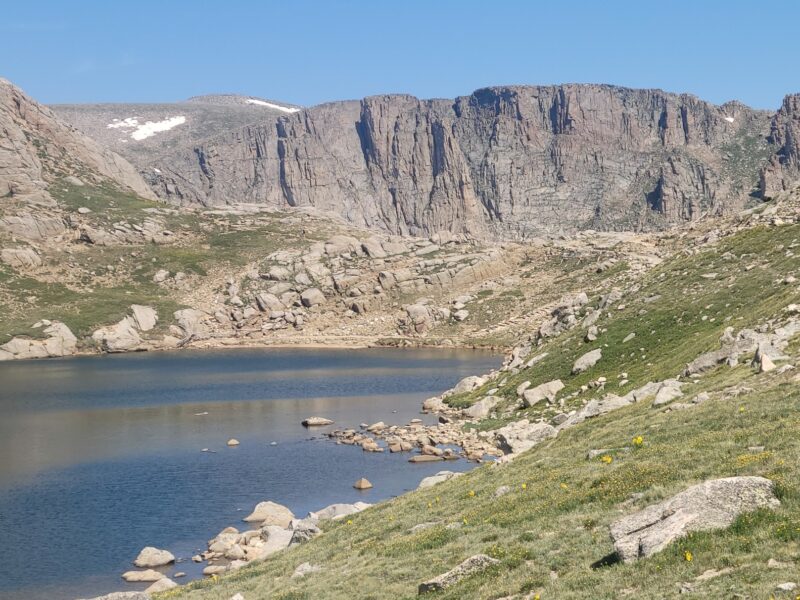
Stats: RT distance 5.75 — Elevation Gain: 2,159 ft — Summit Lake Parking Lot — Hiked: July 13, 2024
We started out our 14er season this year with Mt. Blue Sky from Summit Lake. It now requires a permit to park and it is a timed entry. But it is pretty easy to get a permit (not like the lottery systems for peaks like Mt. Whitney). The link is here: https://www.recreation.gov/timed-entry/10087438. One issue is that the first timed entry is 8 am and you may want to get an earlier start; what you can do is enter and park and put your permit that you printed at home in the window. Make sure to get the correct permit.
This was not our first time hiking Mt. Blue Sky, but it was our first time hiking it from Summit Lake. The area is really pretty and there were some goats hanging around and park rangers giving educational lessons on the area at a table. It was very busy and many many tourists around. The trail begins just north of the parking lot and is obvious and very nice. There are bathrooms and some side trails to go to the lake. I want to post a few shots below and one in particular from Google Earth that I marked up.

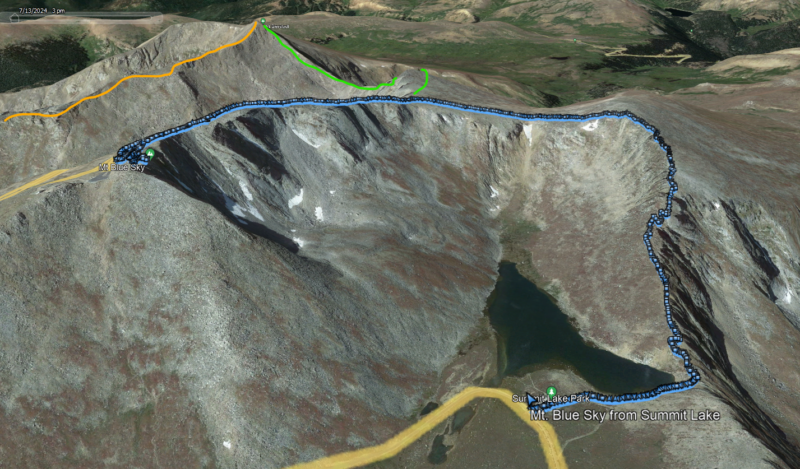
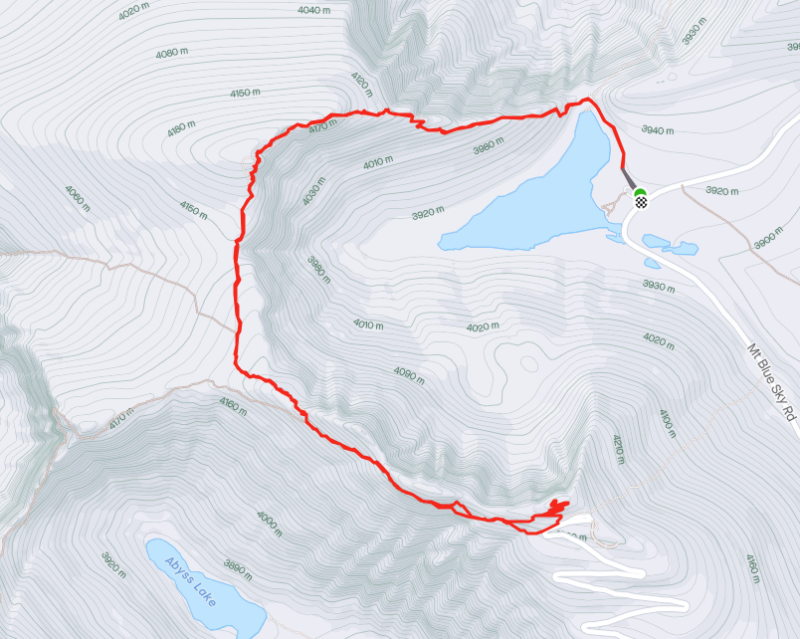
The first image is the elevation profile, and you’ll likely have to open it to see the full profile. But generally you have a nice little walk over to the actual trail, and then start a steep hike up to Mt. Spalding (a 13er at 13,863′). From there you lose about 200 ft. of elevation before hiking up to a little spot where you make a left hand turn onto the southwest face of Mt. Blue Sky. The last section is what throws people off and I’ll provide some tips down below. I marked up the middle image to shows some other popular routes. The green is the Sawtooth route and the orange is the Bierstadt’s East Ridge route. We plan on hiking the East Ridge soon as part of the Tour de Abyss (named for Abyss Lake which you can see in some pictures below). Let me post a few pictures of the first section up to Mt. Spalding.
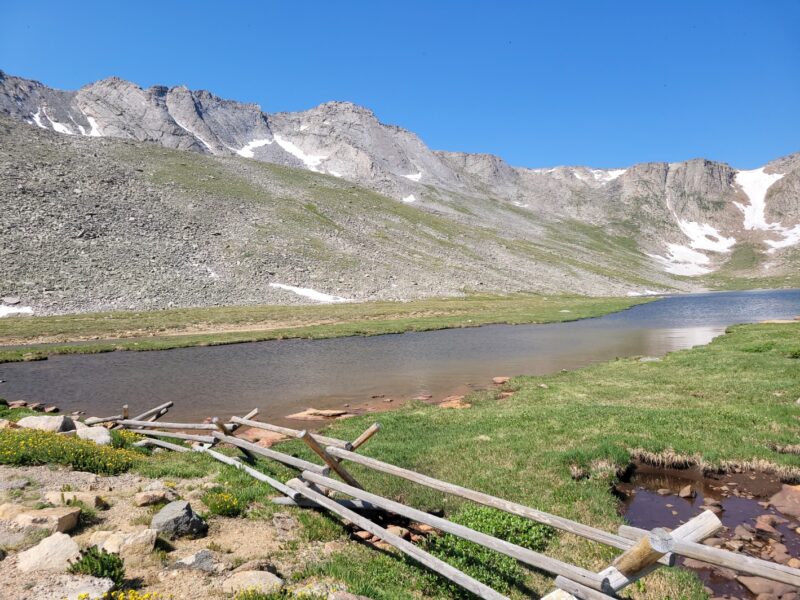
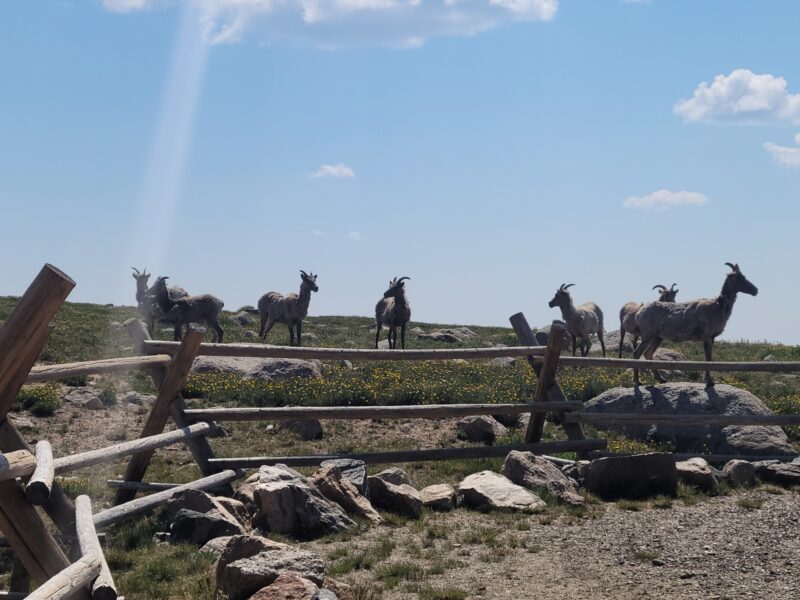
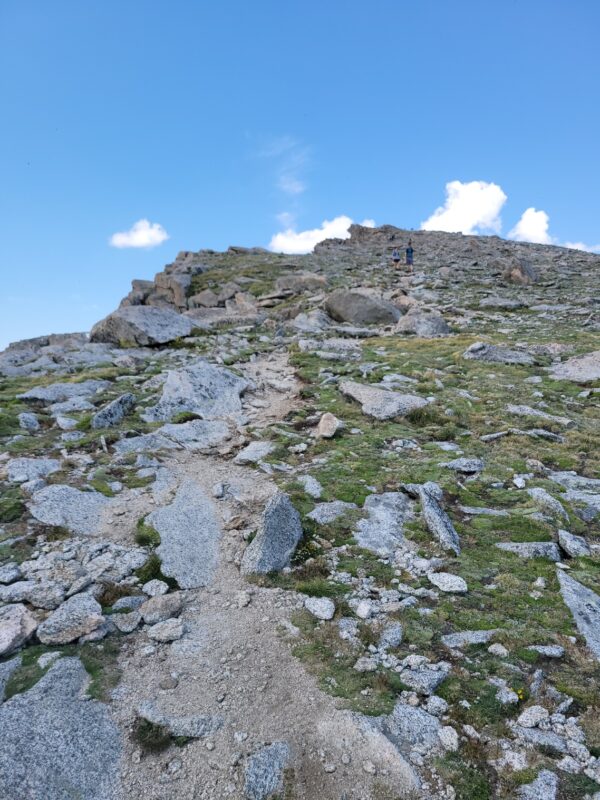
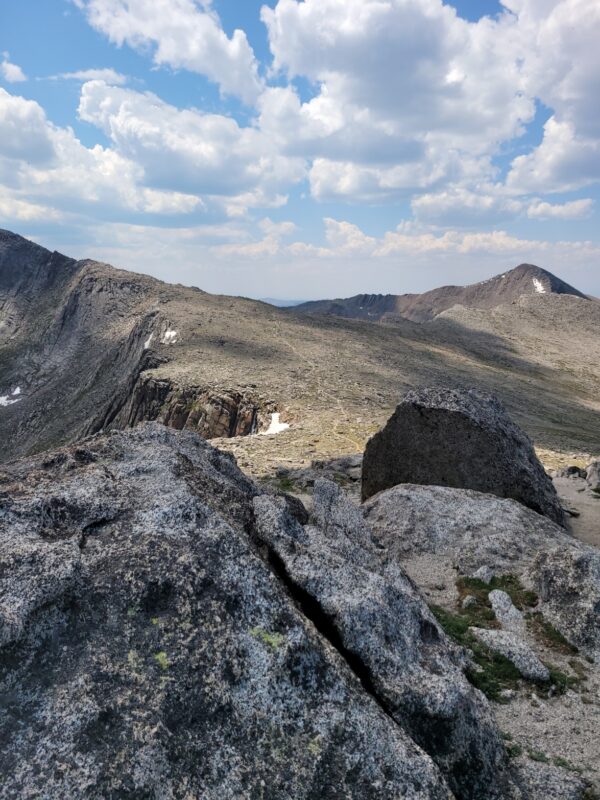
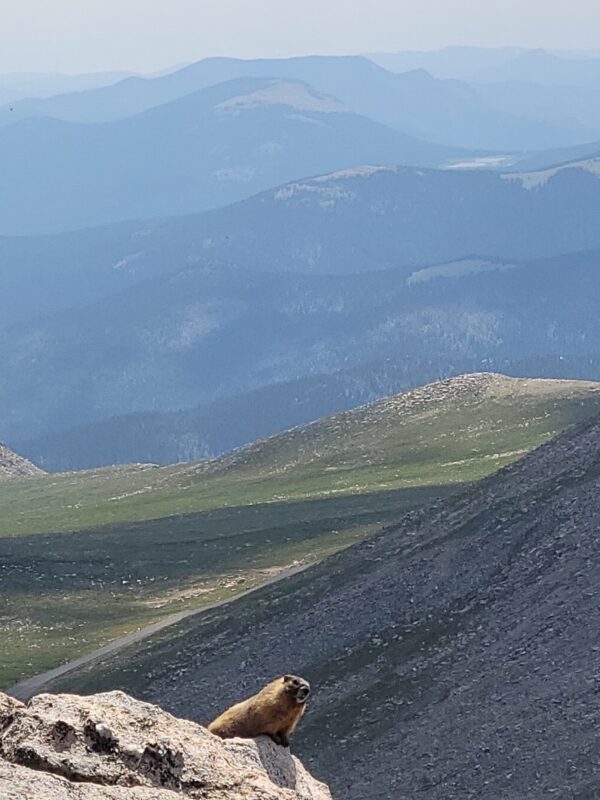
I want to make a brief-ish plug about hiking this trail. We saw multiple groups of hikers who really weren’t prepared for the hike. While it is a “short” hike and you can do it one way and have a car meet you at the top (making the entire journey a little over 2.5 miles), it is not easy. We ran into a few people who said they weren’t prepared for the “scrambling” on the first section of the hike and who had very little water (they were going to run out). First, there is no scrambling on the standard route up to Mt. Spalding from Summit Lake. If you’re actually scrambling, you’re off route. Second, unless you are accustomed to hiking across mountain terrain, hiking a mile here is not hiking a mile at your local hike and bike trail in the city. I sincerely hope the individuals we ran into made it safely to the summit, since they did not want to turn around. But this is part of the issue with having a summit you can drive to. Short version, be prepared.
Anyways, once you are to Mt. Spalding and drop down those 200 feet you get to that left hand turn I mentioned and the class 2 climbing begins. Up until this point it should have been class 1. You can almost see where I’m talking about in the second to last picture above (you can follow the trail up and see where it kind of vanishes behind the face. Let me put some pictures of this area below (you can see Abyss Lake in the first picture below Mt. Bierstadt).
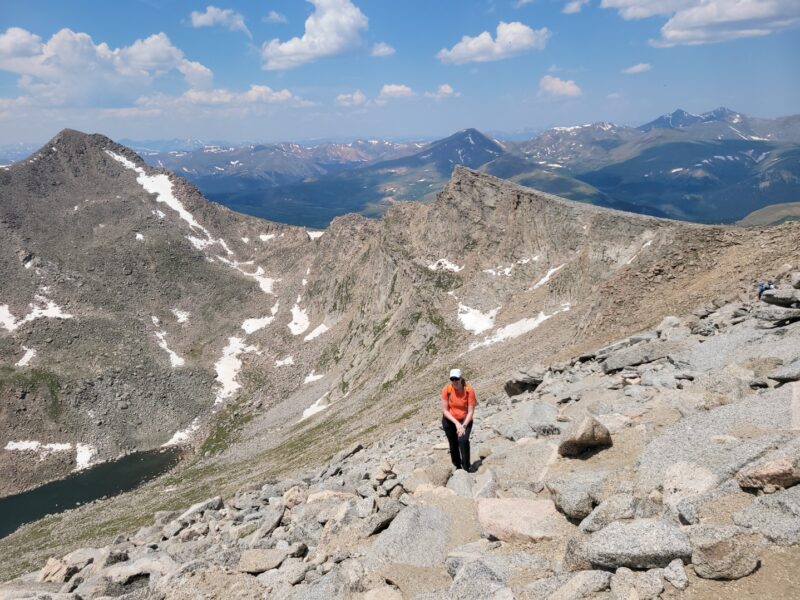
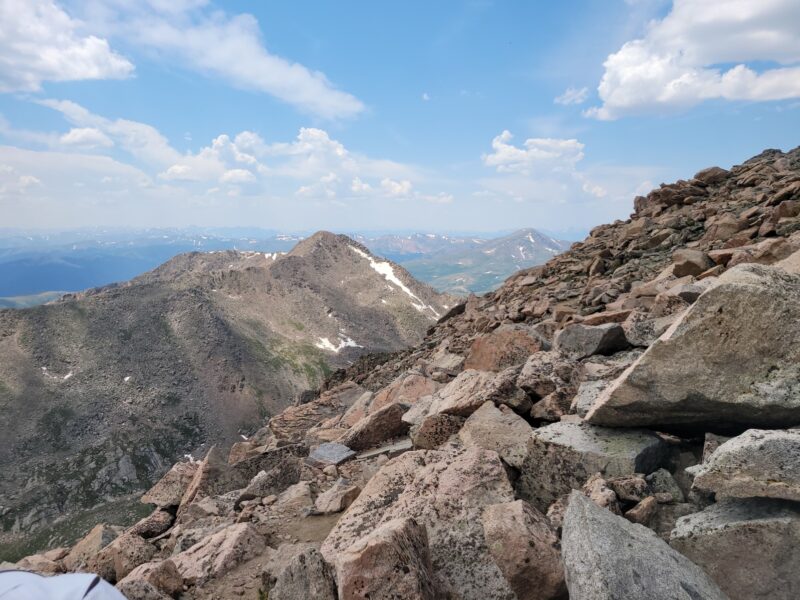
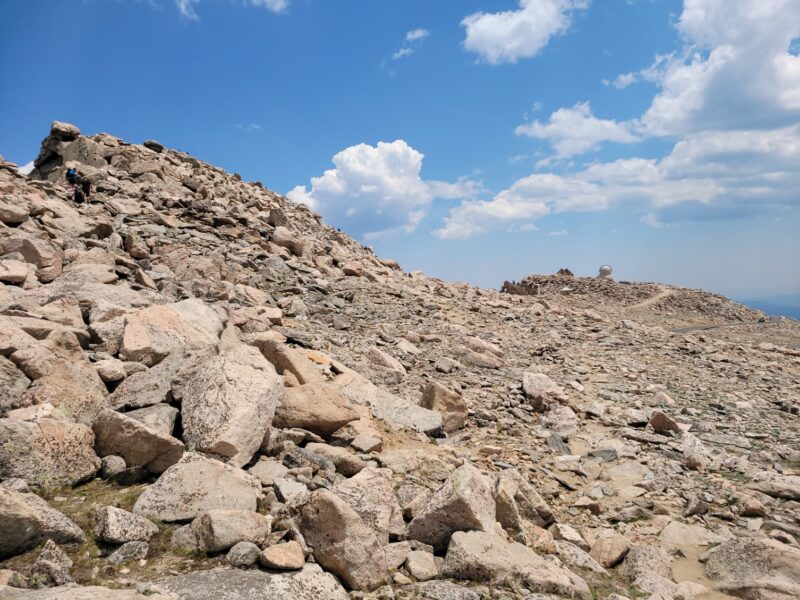
Alright, so here’s my biggest tip and I offered to groups who requested it. The easiest trail and the one that will keep it to class 2 stays low pretty much the entire time. You may be temped to climb up to the ridge, but don’t unless you want class 3 climbing or, and this is a big or, you want to tag West Mt. Blue Sky. Yup, that’s right, there is a second, unranked peak at about 14,250 ft. There are cairns that lead to this second peak, and if you follow them up, you’ll be led to class 3 scrambling and have to downclimb to avoid being cliffed out. This can tire you out quickly, as I learned when I did it myself when I did the Bierstadt-Sawtooth-WestBlueSky-BlueSky route. So, stay low and the trail should stay pretty nice. Don’t worry about missing the peak, look at the last picture, it shows that as you hike you eventually will see the observatory while on the trail. Not having good route finding skills in this area can lead to an extra 30 minutes to over an hour of extra hiking (depending on various factors).
Keep hiking towards that observatory and you’ll see the the parking lot and the mass of humans all milling about. Hike up the last few switchbacks to join the gong show at the top. Luckily, it is a big trail and a large rather accommodating summit. I didn’t actually take any pictures at the top of Mt. Blue Sky this time, but I have more images in the Bierstadt-Sawtooth-Evans post (the name hadn’t changed yet when we hiked it last). Some people catch a ride down from here, but the return hike is the same as going up but in reverse. Take some pictures and mosey on back down to the trail to find some solitude.
I will say that this really actually is a lovely hike. You have Abyss Lake on the west side and Summit Lake on the east side of the hike, many wildflowers, critters running around, and generally speaking people are friendly. You get great views of Mt. Bierstadt as well as the Sawtooth and the East Ridge. I’ll post a few more pics I did snap along the way in a gallery below. But I hope this helps a little bit on navigating the route.
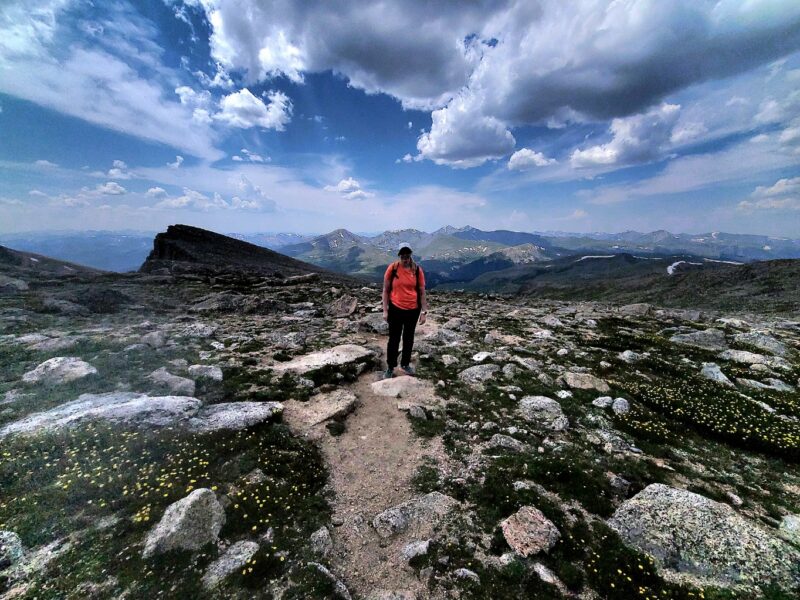
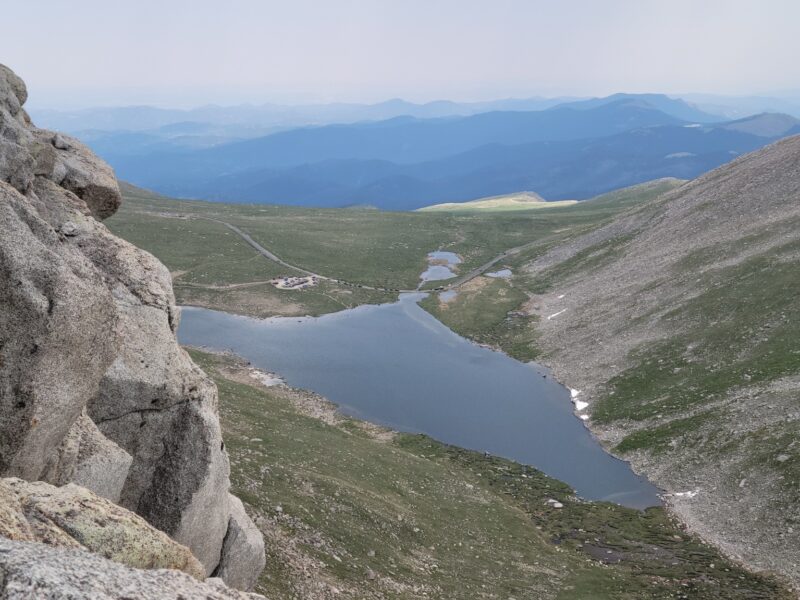
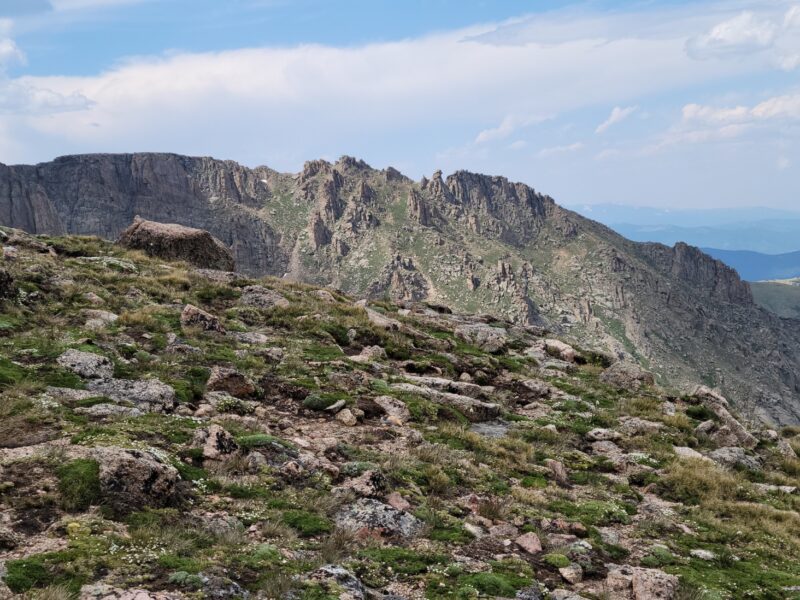
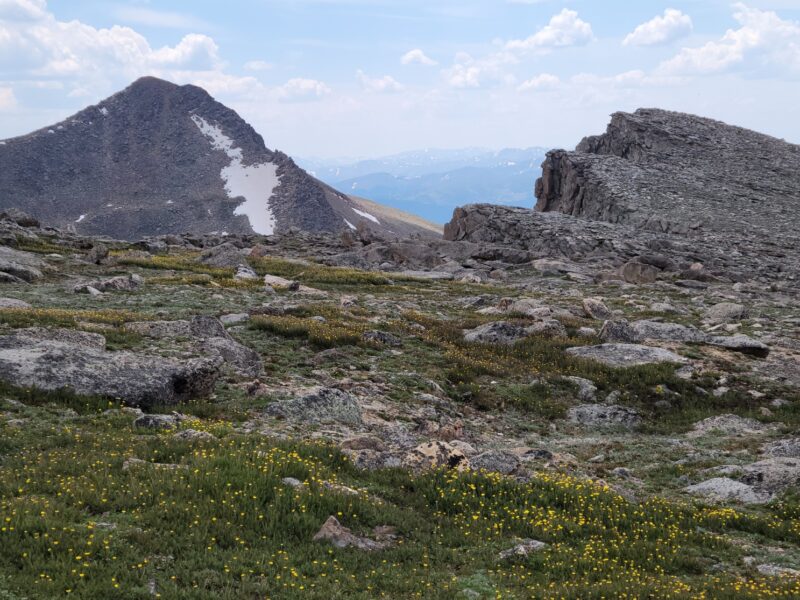
Fletcher Mountain (13,951 ft)
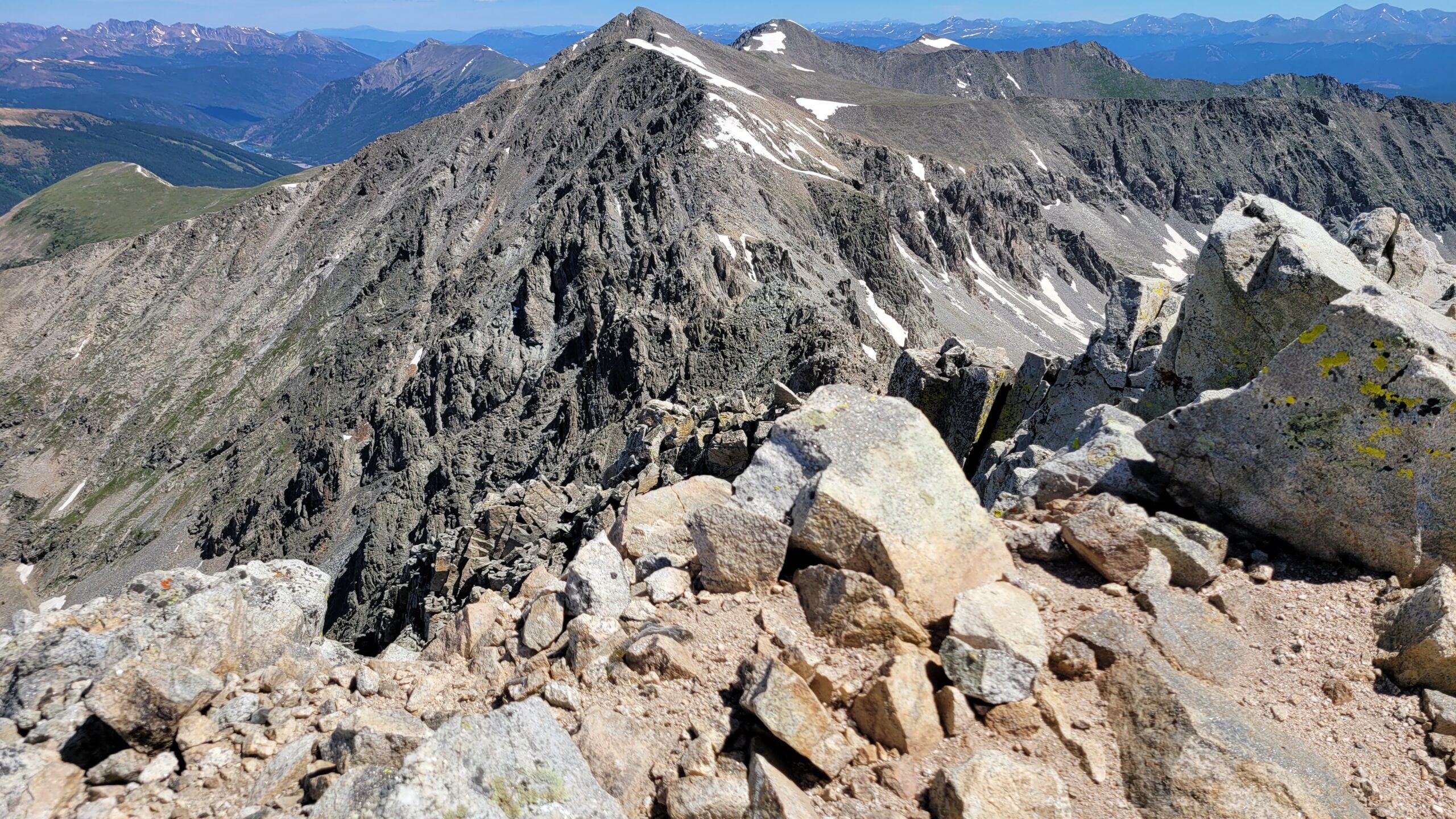
The allure of standing atop 14,000-foot peaks and sense of accomplishment at reaching each one in Colorado remains a goal for us though our perspectives have shifted over the last several years. Popular trails have become even more popular, and nearly impossible for seeking solitude or a trailhead parking spot for that matter. It’s been interesting to see the world trade the routine of daily commutes, happy hours and Netflix in favor of more adventures in the great outdoors. Though it is clearly a positive direction for our country to collectively share love and respect for these diverse ecosystems, overuse is inevitable and even heightened when leave no trace isn’t practiced. Reservation systems have been put in place and fees increased for many national parks and even some 14er parking (looking at you Quandary) in the hopes of managing more of the crowds though this is not without many issues including the loss of freedom and spontaneity but more importantly the development of access and equity concerns.
One way that we can help mitigate some of the overuse of popular areas is expand our areas of interest and explore all the nooks and crannies around us. We have started to transition our weekend adventures to trail running in less popular trails or exploring the hundreds of other majestic peaks under 14,000 feet that this state has to offer. In fact, there are 583 ranked peaks that fall between 13,000 and 13,999 feet in Colorado making seemingly endless options for varying degrees of adventure and solitude.
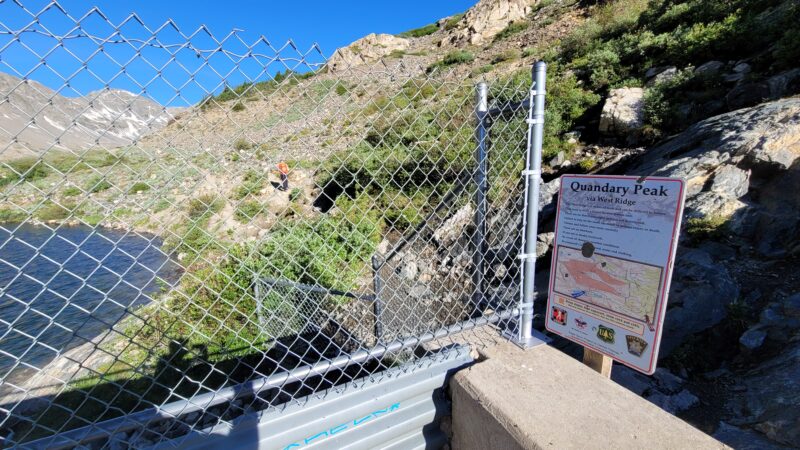
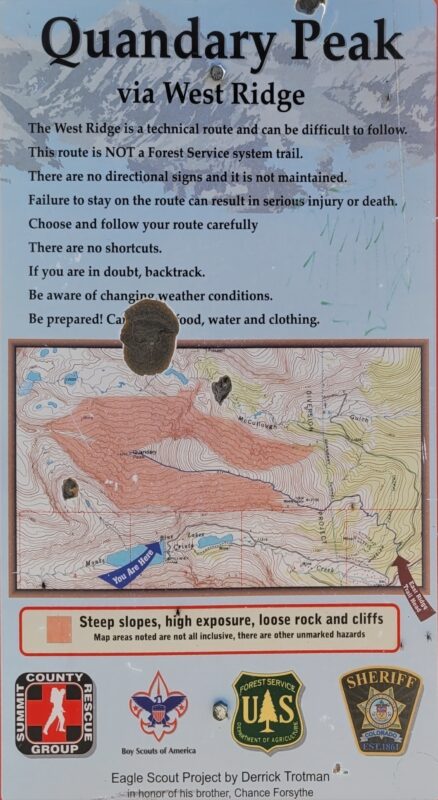
On July 9th , we decided to finally make our way up a nearby centennially peak in the Tenmile range, Fletcher Mountain, which sits majestically at 13,951 feet above sea level — a mere 49 feet from 14er status but therefore not on as many checklists. We decided to climb the class 2 southeast ridge of the peak which begins at the Blue lakes TH right next to the dam (seen above). Parking access at the Blue lakes TH is currently fee and reservation free allowing us to base our decision to climb on the predicted weather and our energy levels that day rather than whether we committed to something on the internet weeks ago.
Trip reports we read promised us a short day and easy climb, but if there is one lesson that we have learned over the years is that everything is relative, and conditions can be quite different from month to month or even summer to summer. To start, our day began at the lower parking lot, because to our surprise, the gate to the upper large parking lot next to the dam was still closed despite summer conditions in and around the lakes. The extra hike up the road to the dam was only 0.6 miles (one-way) and around 350 feet of elevation gain, but already extended the day slightly longer than we had planned. Once we reached the dam, we followed a rocky path up and around the right side of the dam, passing by the warning sign for Quandary Peak’s West Ridge Route. This is a Class 3 exposed route up the famous 14er. Despite the extra challenges of this route, we suspect it might be gaining popularity as there is no reservation required and free parking.
We quickly followed the trail and traversed rapidly up the west slope and found ourselves high above the lake within 10-15 minutes of steep hiking. Be cognizant and follow the upper trail rather than the lower social trail that follow the lakeside. There is a trail restoration sign by the trail that incorrectly leads by the lake. We went the wrong way on a hike here several years ago and ended up bushwhacking up a steep scree slope to regain the appropriate trail. One thing to note about this hike, is that it is all truly an alpine experience. The trail begins above tree line at around 11,700 feet and quickly gains elevation making most of your day spent very high in one sense of the word.
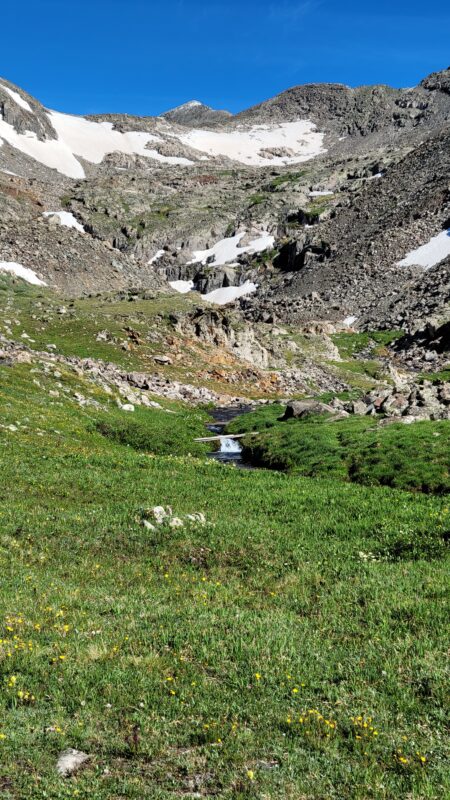
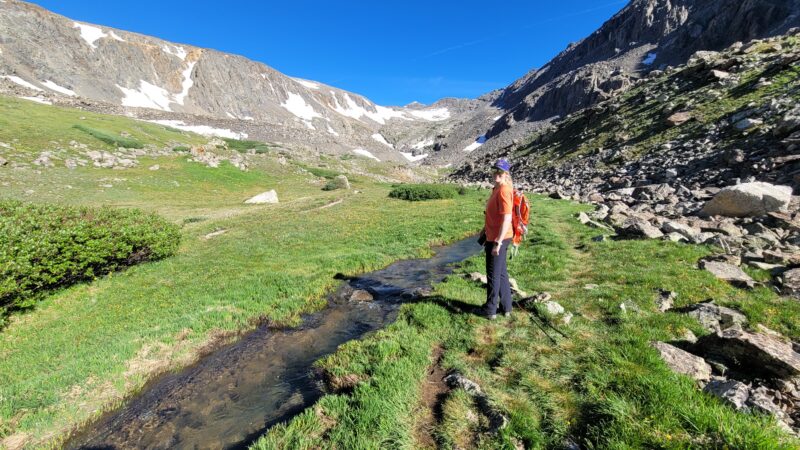
Once above 12,000 feet, the trail begins to angle northwest leading into a verdant basin, also known as
the Monte Cristo gulch. One thing we noticed about this hike was the abundance of water. Creeks
flowed everywhere, with the trail seemingly weaving in and out of rushing snowmelt. We carefully rock-
hopped over streams and deep mountain pools. There was some remaining mud, but nothing too
unmanageable. As we gained elevation in the basin, we also passed by some old mining ruins.
The skies remained a brilliant blue with very few clouds in sight as morning progressed along. We
continued hiking a wonderful trail through the basin as views began to open of the gully in front of us
with Fletcher Mountain peeking out above all. Once we reached the gully, the trail sort of slowly
dissipated, and we had to spend a few minutes evaluating our options for ascending the steep rock.
There were still several snow fields in the gully that were too steep and slick to ascend without the
appropriate gear. We initially climbed steeply up a rust-colored creek in the center of the gully before
veering left and bypassing a snowfield. This allowed for some fun scrambling among the rocks as we
ascended higher. Carefully test all holds or talus before stepping as much of this rock was quite loose.
We did note several cairns as we made our way up the gully, but there were plenty of different options
for gaining the ridge allowing for variation in the effort and difficulty of this climb.
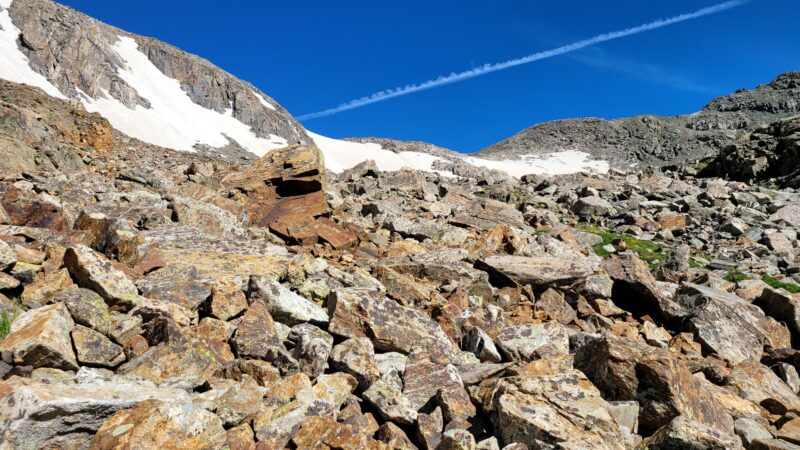

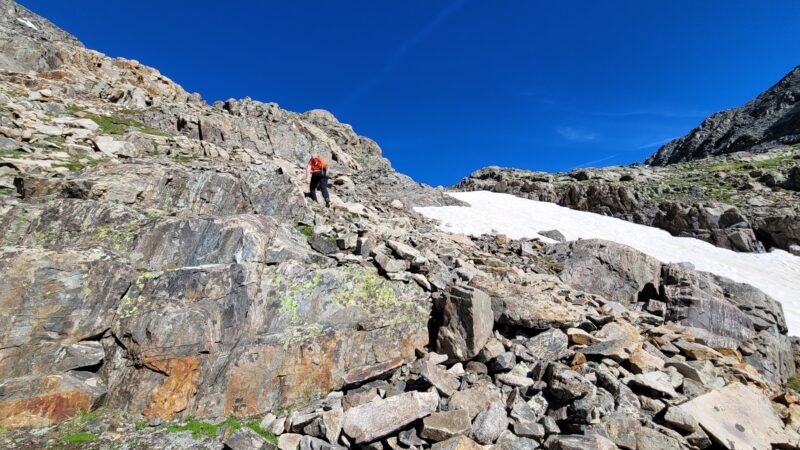
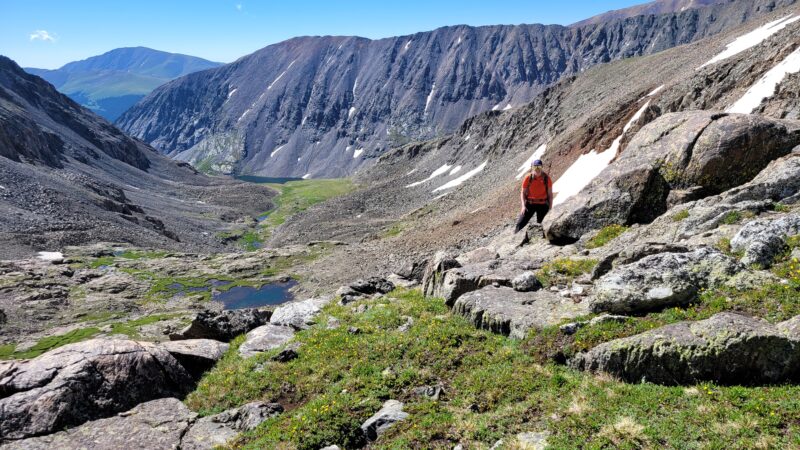
After much rock hopping, we veered west and exited the gully/basin around 13,100 feet which we noted was marked by a large wooden stick that proved quite useful for guiding us during the descent. Fletcher mountain was now in full view before us and to our dismay, appeared to be a large, very steep pile of rubble. We headed the obvious direction towards the southeast ridge of the peak gaining minimal elevation (roughly 100 feet) as we navigated uneven, rocky terrain on a large plateau. Unfortunately, we didn’t take the most straightforward path up the peak following the ridge, but instead tried to head straight up the south face. This didn’t save time and we soon found ourselves in a talus nightmare, climbing and hopping very large boulders, many that were not very stable. Eventually, we reconnected
with the ridge only to discover it was covered in a slab of snow just shy of the summit. Here, we downclimbed a little to avoid the snow, adding a little more work to our summit adventure. Despite our heavier than needed workload, we made the summit and enjoyed spectacular views of the Tenmile range including Quandary Peak, Atlantic Peak, and the impressive east ridge over to Pacific Peak that we climbed last year. The basins and gulches were still holding some snow alongside their fresh wildflower blooms and alpine grasses making for an impressive explosion of colors.
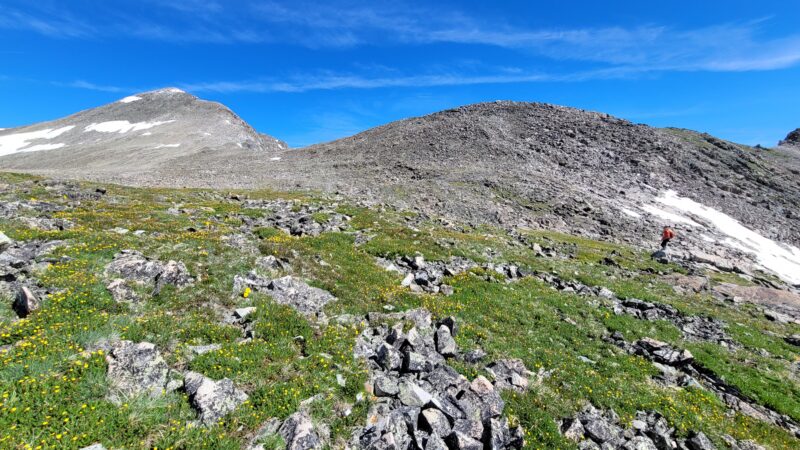
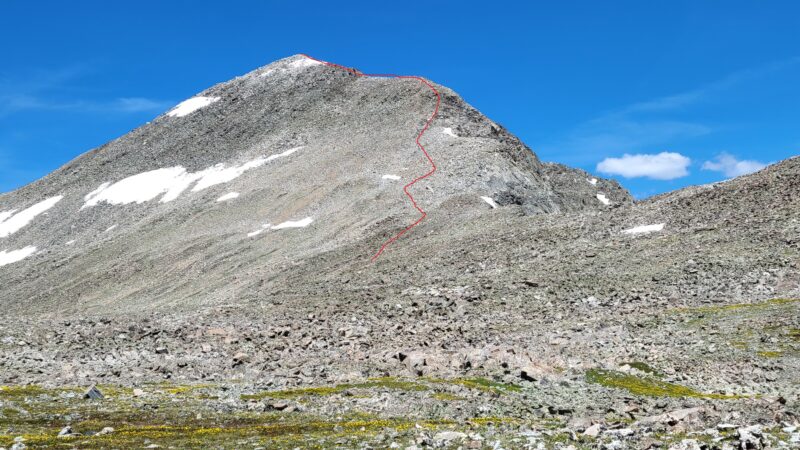
There was no one that we shared the summit with, but we did enjoy looking over at all the tiny human
dots on the top of Quandary towards the east. After a few minutes of relaxation and snacking, we
decided to head back down. This time, we followed the ridge proper as closely as possible for our
descent. The snow just below the summit was avoided by staying slightly left of the ridge and very
carefully negotiating the rock as there were some serious drop offs below us. Once past the snow, we
followed a rough path through the large talus. While it was still rough class 2, this was a much easier
route option than we encountered on our ascent. Solitude was finally gone as we made our way down,
and we encountered a solo hiker and then a group of 3 making their way up the ridge. For perspective,
in a game of boredom on a descent of gray’s peak several years ago, we tallied 700 hikers seeking an
“adventure” and wildflowers on a pleasant July weekend. There was scarcely a moment in our descent
that we didn’t have to move the right of the trail. Though that was frightening example of overuse and
the strain on our natural resources, the number of hikers ascending Fletcher or Quandary and the few
playing in the gulch seemed to strike a good balance.
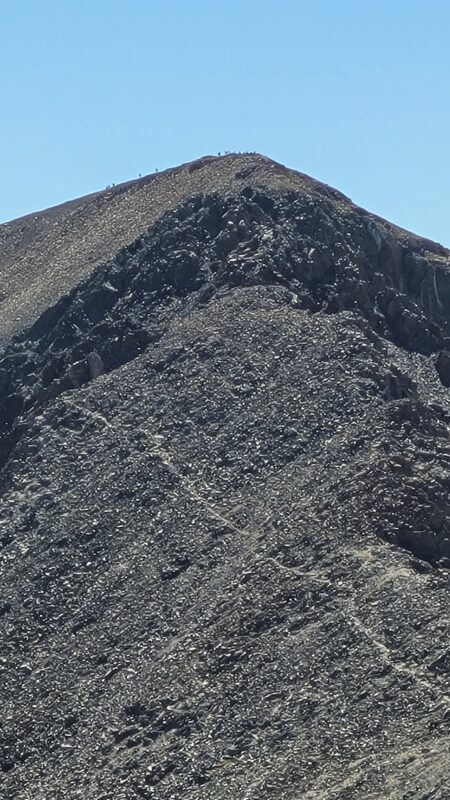
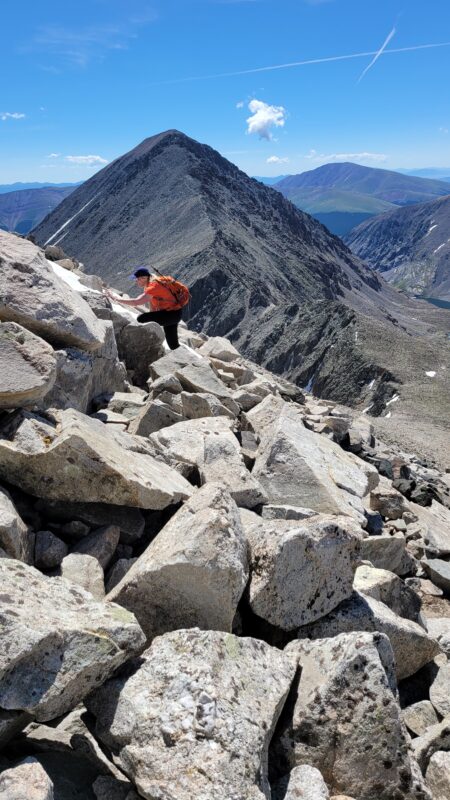
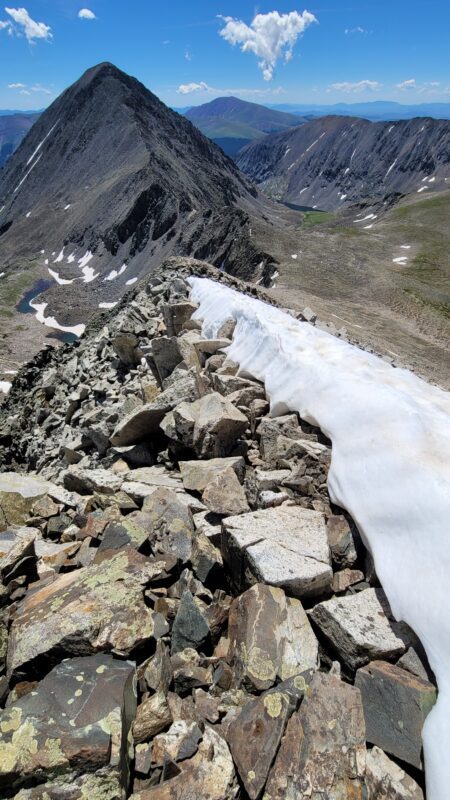
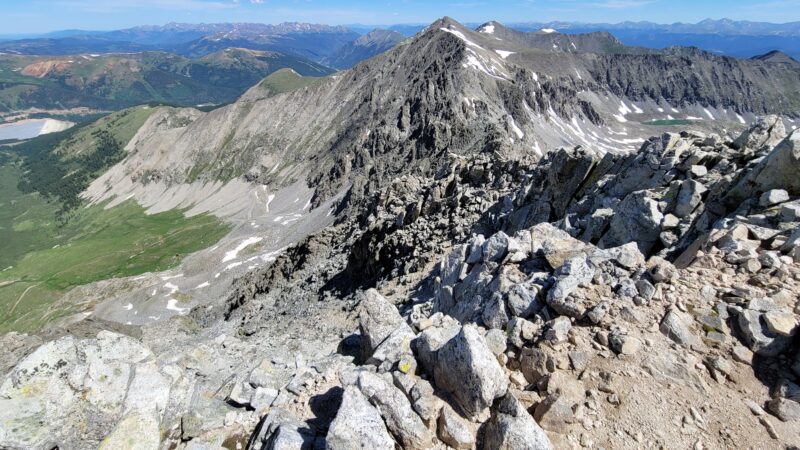
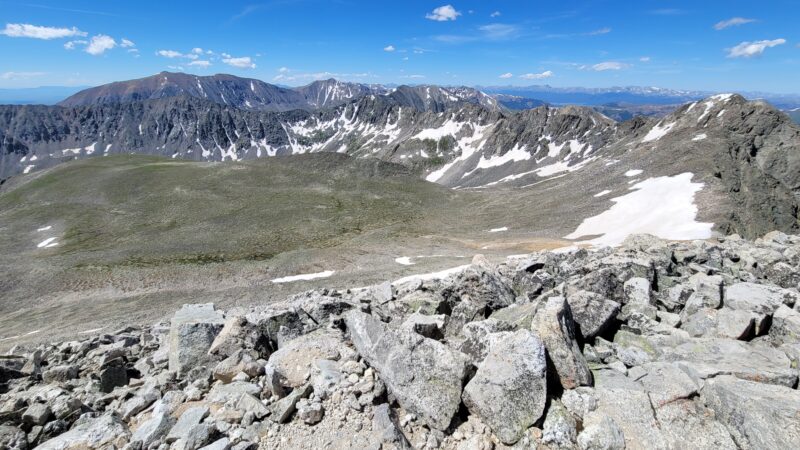
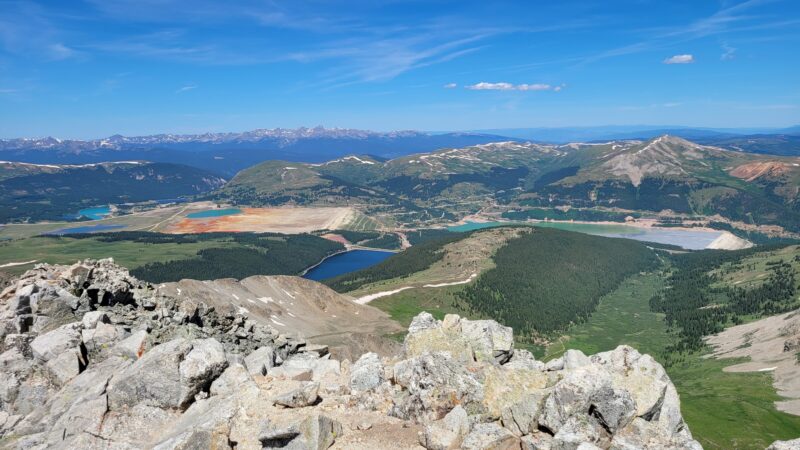
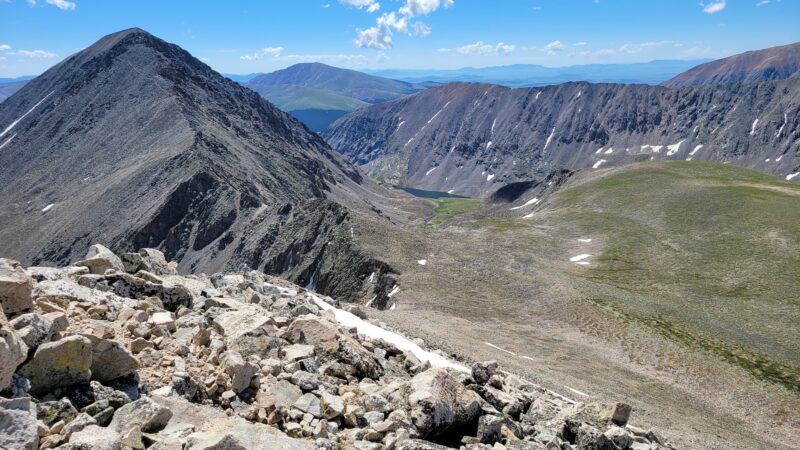
The sun was now high in the sky without a cloud in sight and beginning to bake us a bit in its warmth. Sunscreen is inevitably never applied as evenly or abundantly as needed and that was quickly become apparent as we hiked back through the basin. The cool, blue alpine streams beckoned us to dip our hats in the icy coldness for some relief. Though, thoughtfully, this sounds dramatic now as temperatures were roughly 70 degrees at the time.
As we reached the dam, we began our walk back down the road. It was now lunch time, and many families were out and about walking up the road to view the waterfall just below the dam. Mountain goats continue to find us this summer, and today was no exception. Down the road, we encountered a group of 10-12 goats hogging much of the road including a precious baby. We were not oblivious to the protective mother and kept our admiration at a distance.
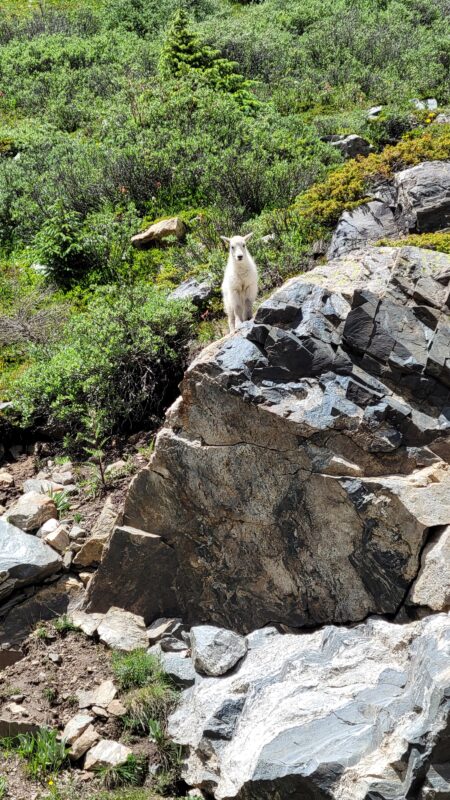
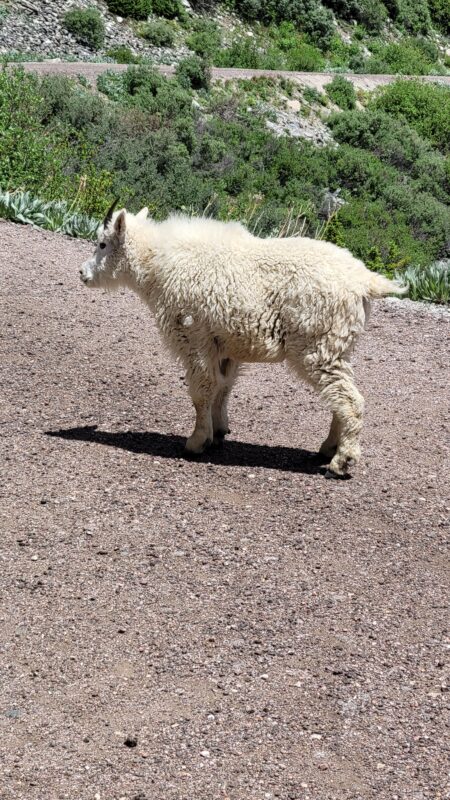
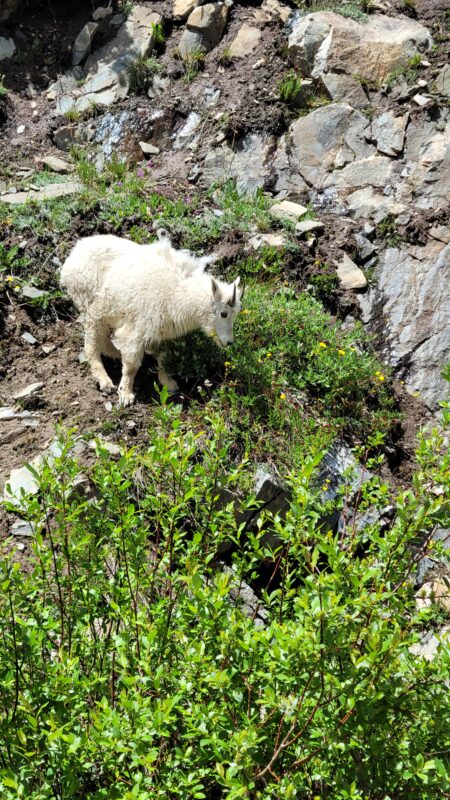
As we reached the truck, we noticed a few late comers vying for our parking spot. Popularity is gaining at this TH too though an earlier start affords a spot and quiet for a while. The diet coke we had been saving was too warm to enjoy and we settled on the remaining bladder water that had been baking in the pack throughout our hike with its signature plastic flavor. Once in town, we made our way to Breckenridge Brewery for lunch. Oddly enough, on a Saturday at lunch, we pulled into a rock star parking lot right in front and were immediately seated when we walked in. Guess everyone was still out on the trails. How the times are changing.
Mount Parnassus (13,574′) and Bard Peak (13,641′) from Herman Gulch Trailhead
Introduction
Numerous trip reports exist on climbing the 13ers in this range; however, there appears to be a need for a more detailed description of this particular route of climbing Parnassus from Herman Gulch Trailhead via Watrous Gulch Trail to Woods Mountain Ridge trail to a bushwhack up to Parnassus, hike the ridge over to Bard, bushwhack south from Bard to connect with Bard Creek Trail which takes us back to Watrous Gulch trail and then back to Herman Gulch Trailhead. Most of this is pretty obvious, except the descent from Bard. So, we’ll go quickly through most of this, but focus on that aspect of the hike.
Part 1
First things first. Herman Gulch Trailhead is close-ish to Denver, and thus, can be very busy. However, it is a nice trailhead with Port-o-Potties and nice parking just off I-70. From the trailhead you are on the CDT: Herman Gulch Trail very briefly before turning right onto Watrous Gulch Trail; there are signs here, the trail is large and well maintained, and it is obvious. You continue on Watrous for about 1.25 miles before reaching the Woods Mountain Ridge trail and veering sharply uphill to the right — towards an obvious saddle. It is a beautiful hike on a very well maintained trail and it has a little creek crossing with gorgeous views of the Front Range.
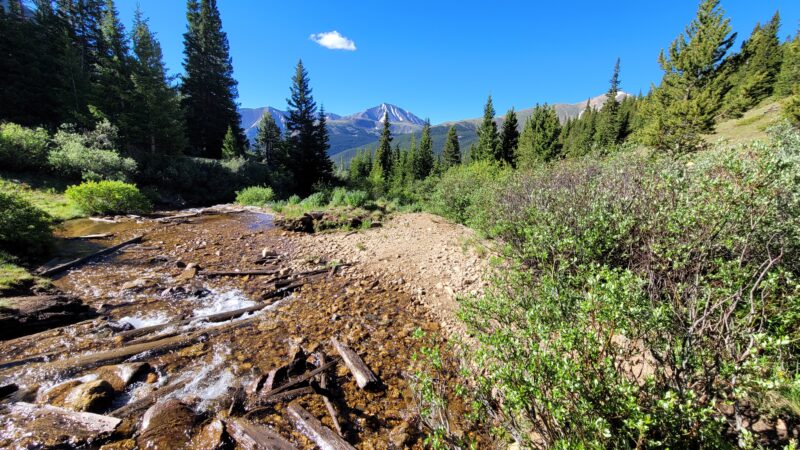
As you climb up the Woods Mountain Ridge trail you get some very nice views of Grays and Torreys, and we could even see the trail leading up to Grays’ summit. It is a splendid hike and there was still a nice trail that was never smaller than single track — it was pretty steep.
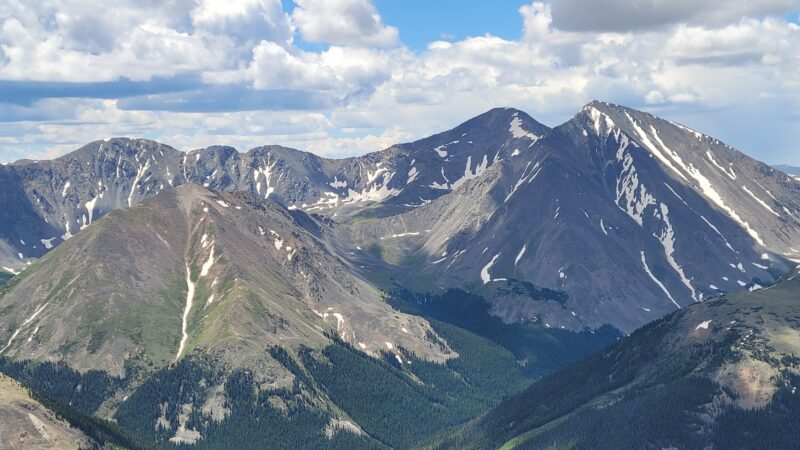
Saddle to Parnassus
Anyways, once you reach the saddle, if you look to your left (climbers left as you reach the saddle) you will see a trail leading up to Woods Mountain (a 12er) and if you look to your right, you will see a large climb with no clear trail (see second picture below). You want to turn right and climb up to Parnassus.
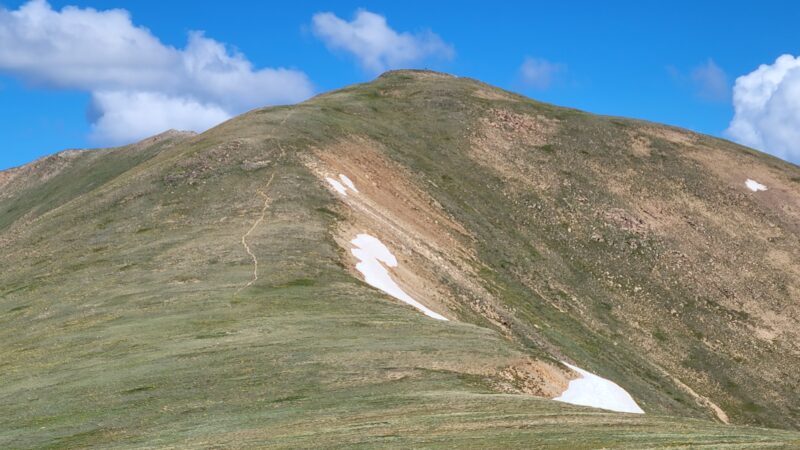
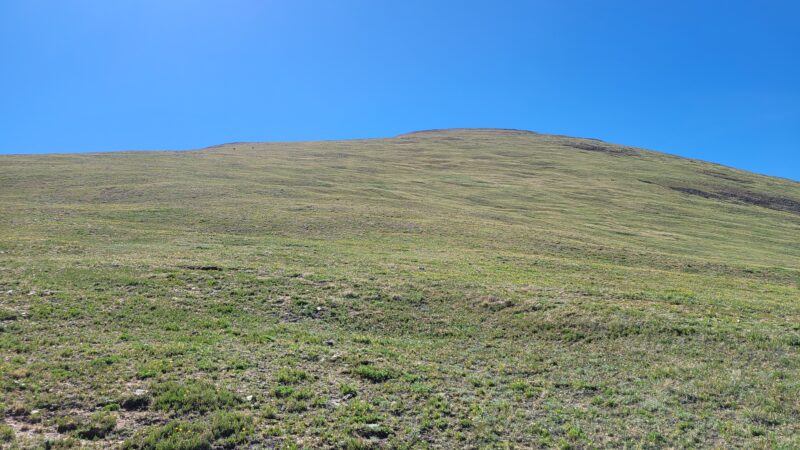
Once you get up this beast, you are pretty much there. It isn’t really a false summit, per se. From here, the next route is more or less obvious (depending on conditions). You do have two options, though, on how you want to tackle Bard. You can maintain the ridge proper (which is what most people do), or you could stay a little lower and traverse around and then come up a saddle on the opposite side of Bard. If you take the second option, which isn’t as steep and is probably easier, then you do add some distance since you have to turn left once you reach the saddle and then gain the summit of Bard. Either way, there isn’t anything special to know, other than that the ridge can hold snow which can make this treacherous. There are some trails on the ridge, but they fade and you really can’t follow one trail across the whole ridge — so just pick a line and stick to it.
Parnassus to Bard
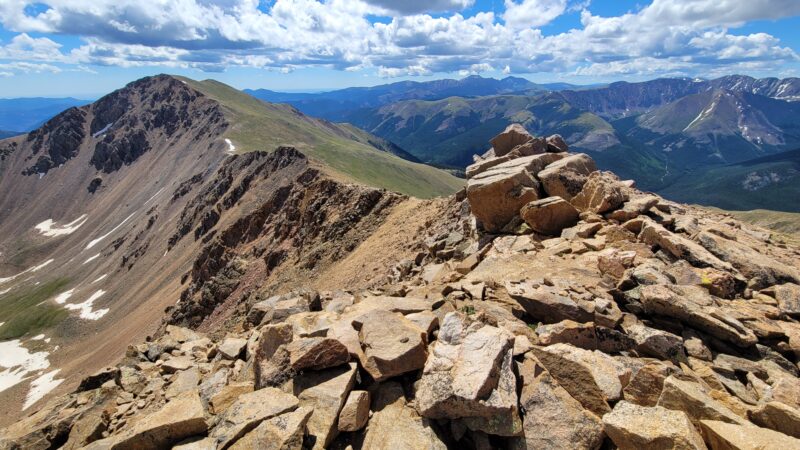
The ridge hike, as we mentioned above, isn’t that bad. And you’ll be at Bard in no time. Below are a couple shots of the hike.
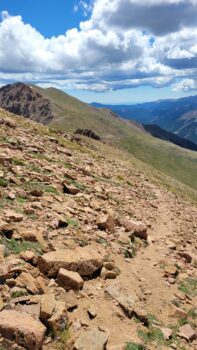
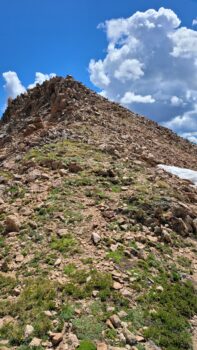
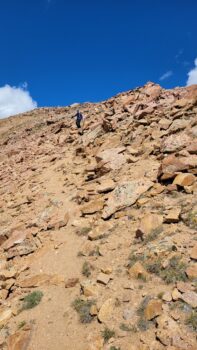
You can see that there is a trail on parts of the ridge, and on other parts there is nothing. You can also see that even in July during a hot summer, there is some snow.
Choices Choices Choices…
Once you are on Bard, you have a few choices to make. Are you going to head north to Robeson and Engelmann or are you going to head back? If you are going to head back, then you have to decide if you are going to retrace your steps or if you are going to head south and try and connect with the Bard Creek Trail. We weren’t trying to nab any other 13ers, and we had seen other trip reports where the authors had climbed down Bard and connected with the Bard Creek Trail, which we thought looked nice. However, it wasn’t clear where to descend and what to shoot for, and this is where our trip report will focus some attention on our idea of how to do this. (I want to state, though, that the recommendation below is only if the conditions are similar to what we were hiking in — that is, relatively snow free.)
Bard Descent to Bard Creek Trail
First, looking south from Bard you are going to see a large ridge that connects to Parnassus to your right, a smaller ridge to the left of that with a gully/cirque between them; directly below, you will see another gully/cirque and another ridge to your left. Our recommendation is to head to that smaller ridge to your right — you can even take the ridge down from Bard a bit to meet up with it. Going straight down from Bard is not pleasant. It is steep, loose and uneven — and it is about 1,400 ft. of elevation loss before you reach the Bard Creek Trail. Below are some shots from Google Earth and from our hike that show what I’m talking about.
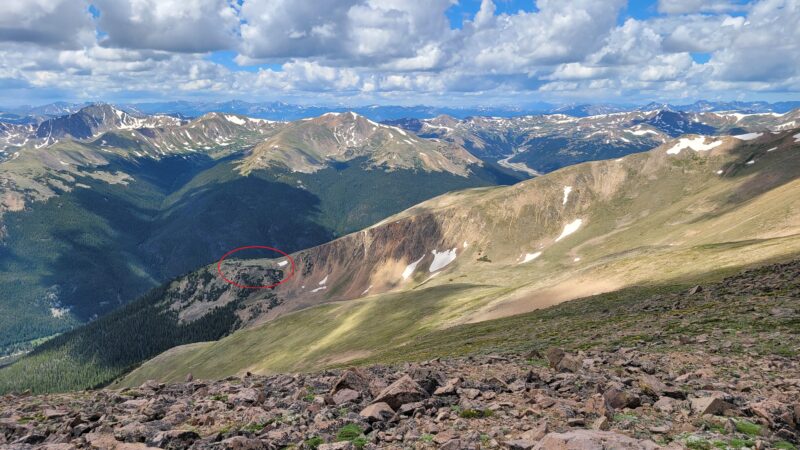

Bard Creek Trail does go up and over two ridges if you choose to go this way. So if you retrace your steps, you are going to regain Parnassus which is 600 ft. of elevation gain. But if you go down to Bard Creek Trail, you are going to have to do some route finding and still climb out. Up to you. But it is hard to see what you are supposed to do from this angle, so I got Google Earth out and took some screen shots of what we think is the best way down.
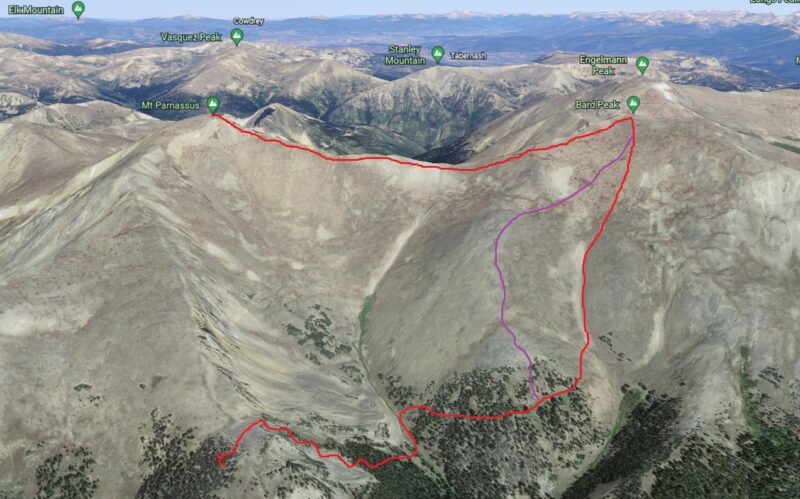

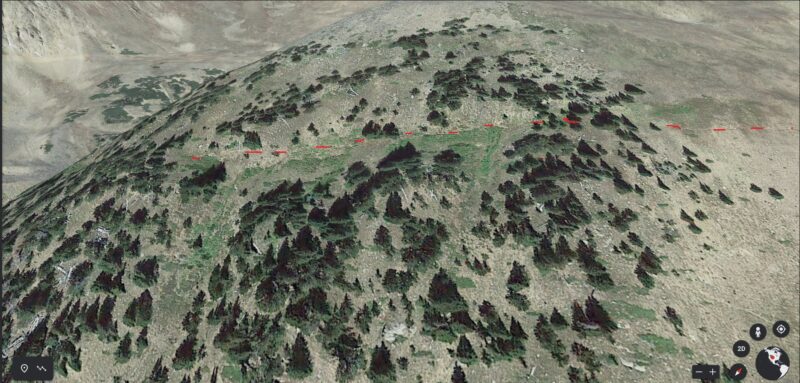
Bard Creek Trail to Watrous Gulch Trail
So, once you are down to the trail, you can relax a bit and then traverse around the ridge and down into the cirque/valley below. At this point, you again lose a trail, but you have cairns that do lead you in the right direction — which is just following the stream. (see below).
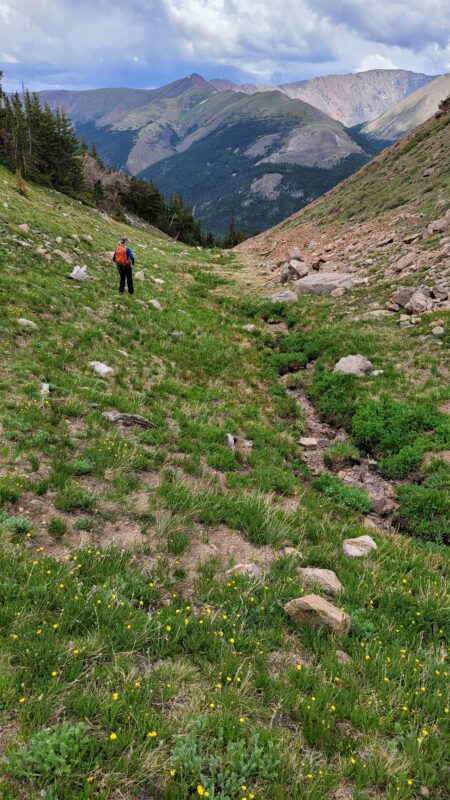
Eventually, you come to what looks like a camp site and just past that is a cairn that points into the trees. Take that path. From there, there is mostly a trail to the plateau.
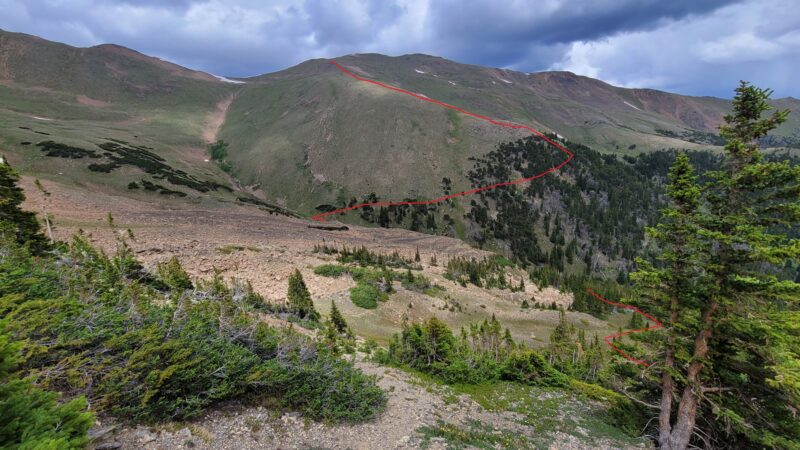
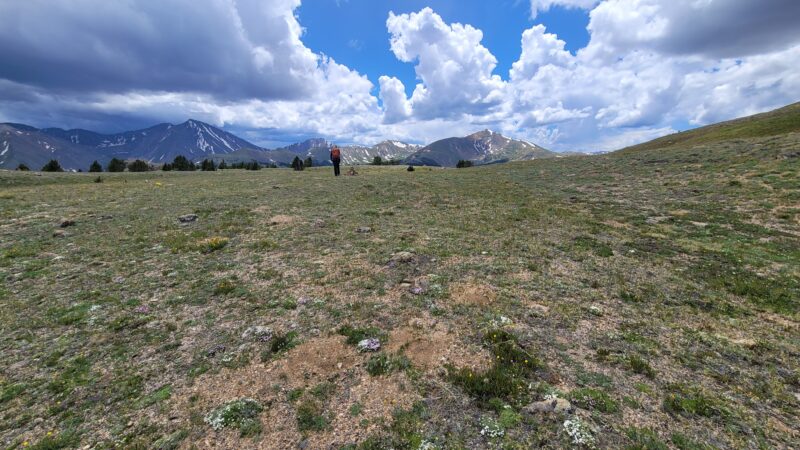

Conclusion
All in all it was right at 9.5 miles for us and about 4,700 feet of elevation gain. As you can tell, depending on how you do this, your mileage and potentially elevation gain may be slightly different. I think this was a fun route and the descent from Bard made more of a challenge. But, it would have been nice to have better beta on this, so I hope this helps someone. I would like to one day do this again, and try the route we have proposed. If you try it out, let us know in the comments. Have fun out there and be safe.
